Self-Compassion And Body Dissatisfaction Assessment 2022
VerifiedAdded on 2022/09/18
|57
|14743
|23
AI Summary
Contribute Materials
Your contribution can guide someone’s learning journey. Share your
documents today.
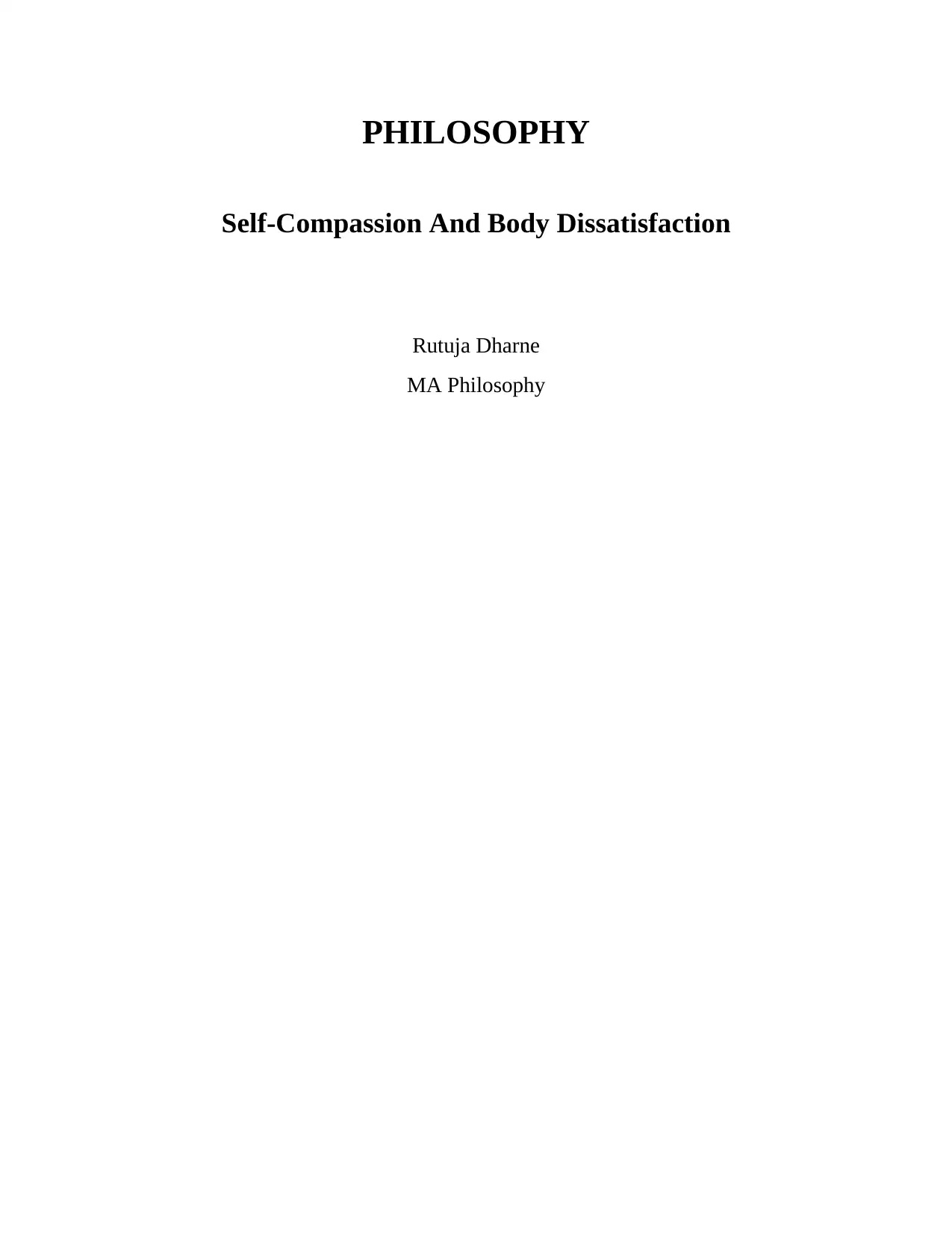
PHILOSOPHY
Self-Compassion And Body Dissatisfaction
Rutuja Dharne
MA Philosophy
Self-Compassion And Body Dissatisfaction
Rutuja Dharne
MA Philosophy
Secure Best Marks with AI Grader
Need help grading? Try our AI Grader for instant feedback on your assignments.
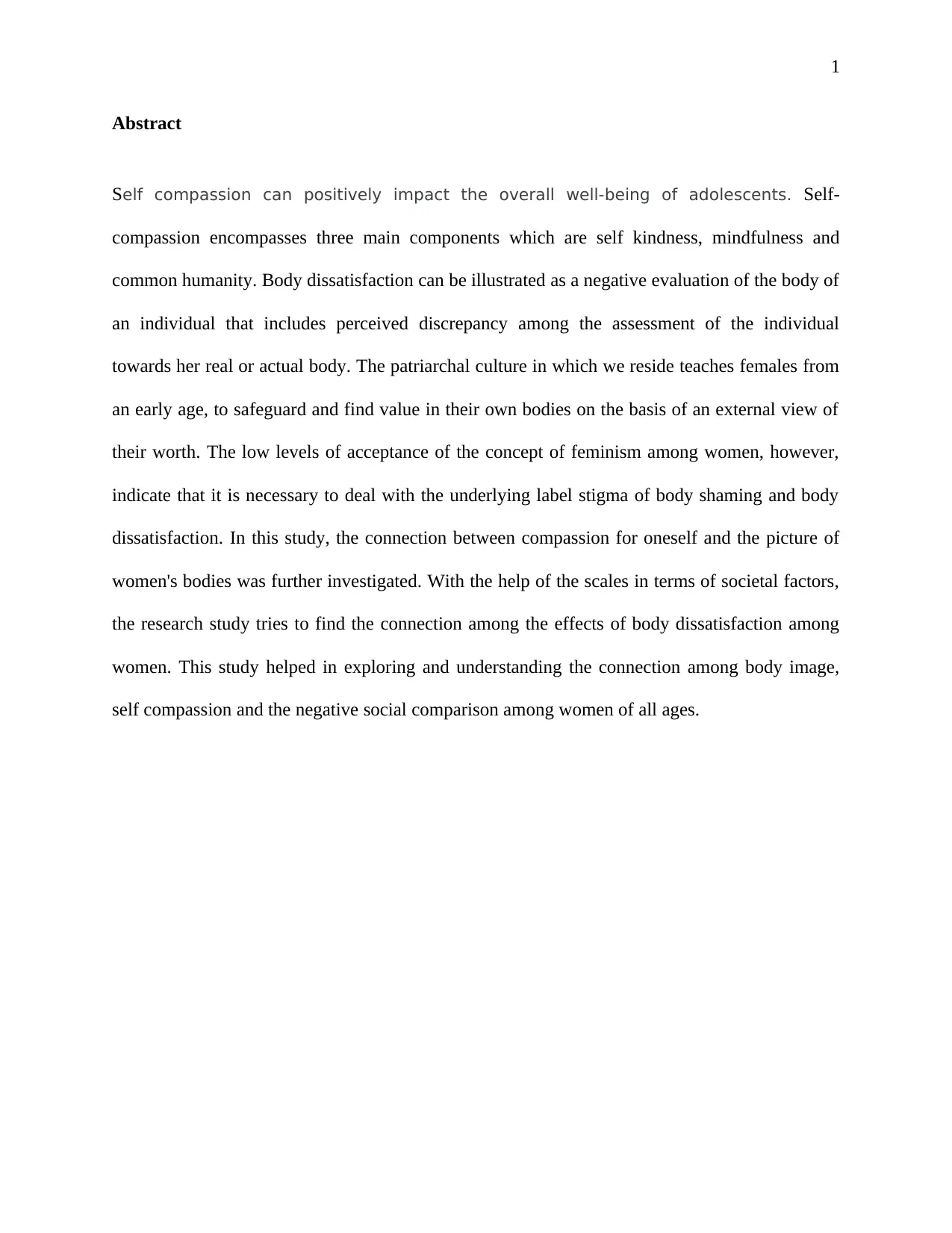
1
Abstract
Self compassion can positively impact the overall well-being of adolescents. Self-
compassion encompasses three main components which are self kindness, mindfulness and
common humanity. Body dissatisfaction can be illustrated as a negative evaluation of the body of
an individual that includes perceived discrepancy among the assessment of the individual
towards her real or actual body. The patriarchal culture in which we reside teaches females from
an early age, to safeguard and find value in their own bodies on the basis of an external view of
their worth. The low levels of acceptance of the concept of feminism among women, however,
indicate that it is necessary to deal with the underlying label stigma of body shaming and body
dissatisfaction. In this study, the connection between compassion for oneself and the picture of
women's bodies was further investigated. With the help of the scales in terms of societal factors,
the research study tries to find the connection among the effects of body dissatisfaction among
women. This study helped in exploring and understanding the connection among body image,
self compassion and the negative social comparison among women of all ages.
Abstract
Self compassion can positively impact the overall well-being of adolescents. Self-
compassion encompasses three main components which are self kindness, mindfulness and
common humanity. Body dissatisfaction can be illustrated as a negative evaluation of the body of
an individual that includes perceived discrepancy among the assessment of the individual
towards her real or actual body. The patriarchal culture in which we reside teaches females from
an early age, to safeguard and find value in their own bodies on the basis of an external view of
their worth. The low levels of acceptance of the concept of feminism among women, however,
indicate that it is necessary to deal with the underlying label stigma of body shaming and body
dissatisfaction. In this study, the connection between compassion for oneself and the picture of
women's bodies was further investigated. With the help of the scales in terms of societal factors,
the research study tries to find the connection among the effects of body dissatisfaction among
women. This study helped in exploring and understanding the connection among body image,
self compassion and the negative social comparison among women of all ages.

2
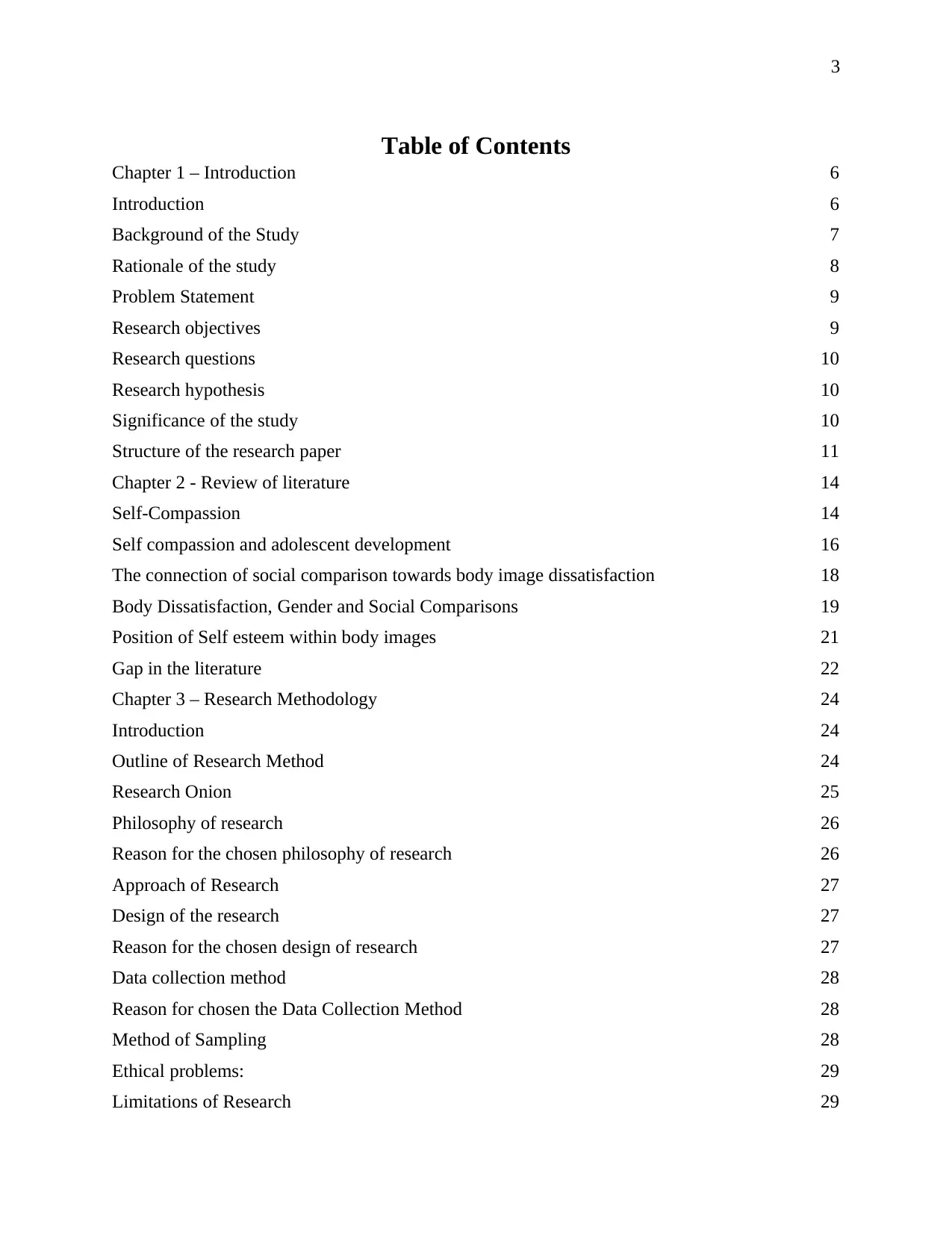
3
Table of Contents
Chapter 1 – Introduction 6
Introduction 6
Background of the Study 7
Rationale of the study 8
Problem Statement 9
Research objectives 9
Research questions 10
Research hypothesis 10
Significance of the study 10
Structure of the research paper 11
Chapter 2 - Review of literature 14
Self-Compassion 14
Self compassion and adolescent development 16
The connection of social comparison towards body image dissatisfaction 18
Body Dissatisfaction, Gender and Social Comparisons 19
Position of Self esteem within body images 21
Gap in the literature 22
Chapter 3 – Research Methodology 24
Introduction 24
Outline of Research Method 24
Research Onion 25
Philosophy of research 26
Reason for the chosen philosophy of research 26
Approach of Research 27
Design of the research 27
Reason for the chosen design of research 27
Data collection method 28
Reason for chosen the Data Collection Method 28
Method of Sampling 28
Ethical problems: 29
Limitations of Research 29
Table of Contents
Chapter 1 – Introduction 6
Introduction 6
Background of the Study 7
Rationale of the study 8
Problem Statement 9
Research objectives 9
Research questions 10
Research hypothesis 10
Significance of the study 10
Structure of the research paper 11
Chapter 2 - Review of literature 14
Self-Compassion 14
Self compassion and adolescent development 16
The connection of social comparison towards body image dissatisfaction 18
Body Dissatisfaction, Gender and Social Comparisons 19
Position of Self esteem within body images 21
Gap in the literature 22
Chapter 3 – Research Methodology 24
Introduction 24
Outline of Research Method 24
Research Onion 25
Philosophy of research 26
Reason for the chosen philosophy of research 26
Approach of Research 27
Design of the research 27
Reason for the chosen design of research 27
Data collection method 28
Reason for chosen the Data Collection Method 28
Method of Sampling 28
Ethical problems: 29
Limitations of Research 29
Secure Best Marks with AI Grader
Need help grading? Try our AI Grader for instant feedback on your assignments.
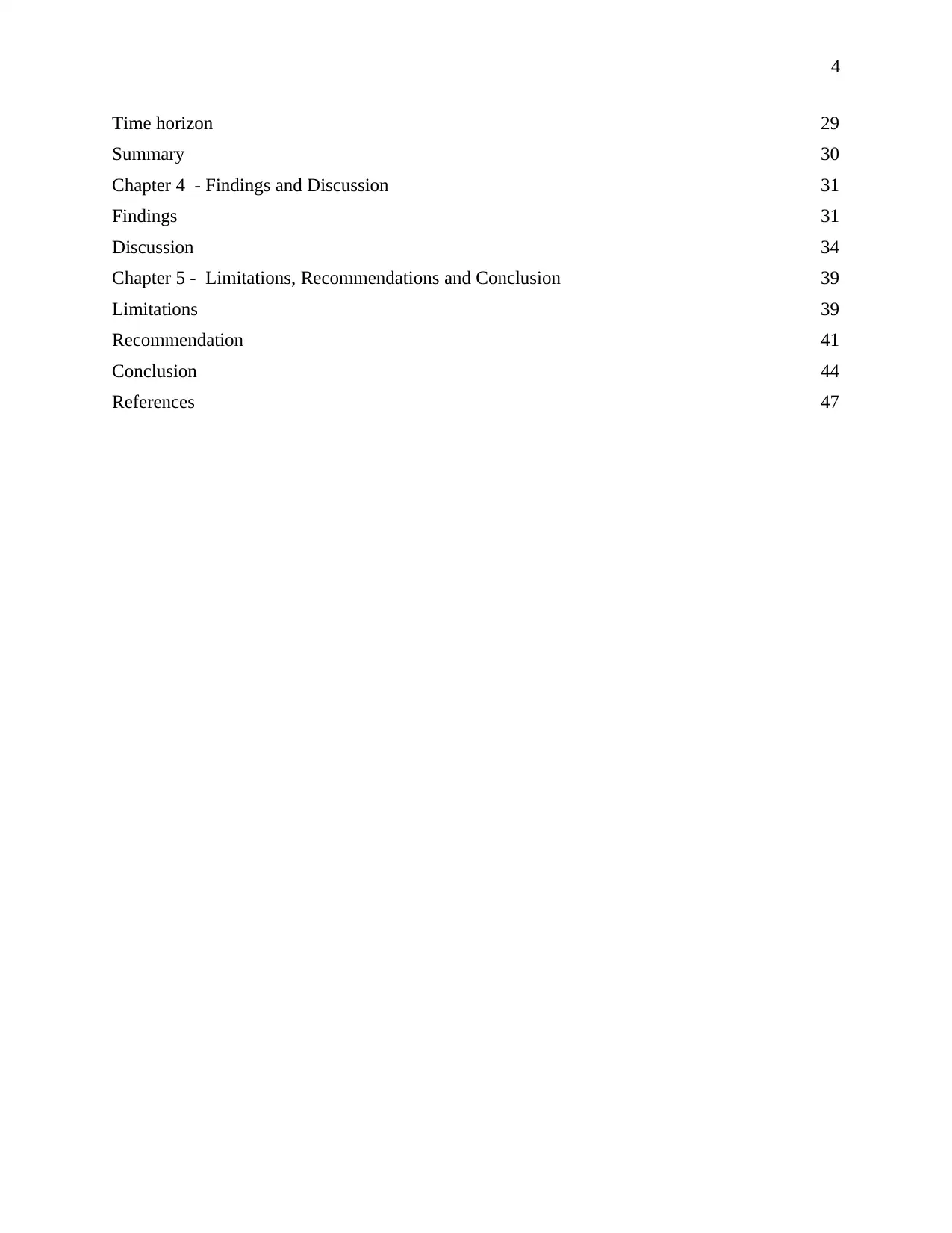
4
Time horizon 29
Summary 30
Chapter 4 - Findings and Discussion 31
Findings 31
Discussion 34
Chapter 5 - Limitations, Recommendations and Conclusion 39
Limitations 39
Recommendation 41
Conclusion 44
References 47
Time horizon 29
Summary 30
Chapter 4 - Findings and Discussion 31
Findings 31
Discussion 34
Chapter 5 - Limitations, Recommendations and Conclusion 39
Limitations 39
Recommendation 41
Conclusion 44
References 47
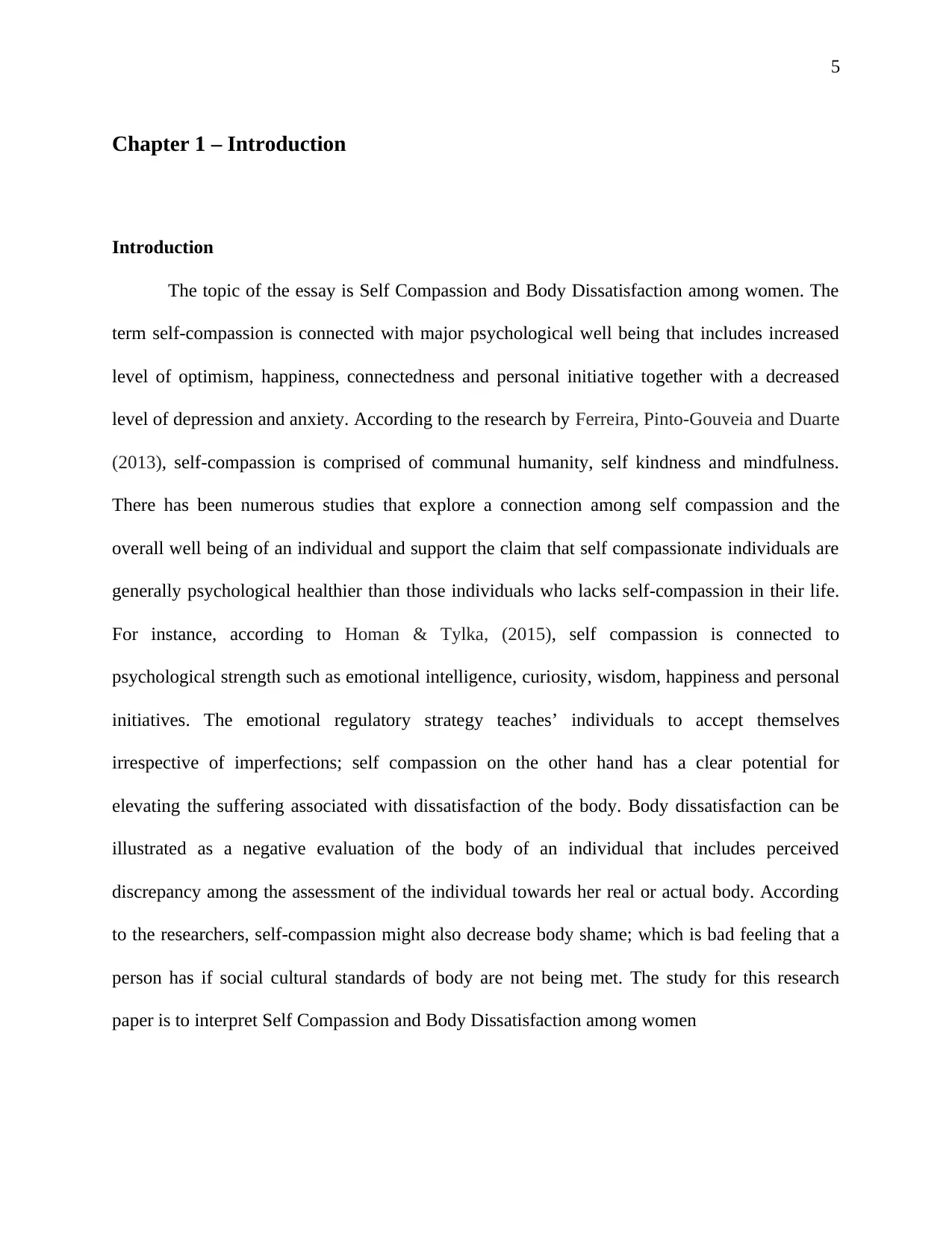
5
Chapter 1 – Introduction
Introduction
The topic of the essay is Self Compassion and Body Dissatisfaction among women. The
term self-compassion is connected with major psychological well being that includes increased
level of optimism, happiness, connectedness and personal initiative together with a decreased
level of depression and anxiety. According to the research by Ferreira, Pinto-Gouveia and Duarte
(2013), self-compassion is comprised of communal humanity, self kindness and mindfulness.
There has been numerous studies that explore a connection among self compassion and the
overall well being of an individual and support the claim that self compassionate individuals are
generally psychological healthier than those individuals who lacks self-compassion in their life.
For instance, according to Homan & Tylka, (2015), self compassion is connected to
psychological strength such as emotional intelligence, curiosity, wisdom, happiness and personal
initiatives. The emotional regulatory strategy teaches’ individuals to accept themselves
irrespective of imperfections; self compassion on the other hand has a clear potential for
elevating the suffering associated with dissatisfaction of the body. Body dissatisfaction can be
illustrated as a negative evaluation of the body of an individual that includes perceived
discrepancy among the assessment of the individual towards her real or actual body. According
to the researchers, self-compassion might also decrease body shame; which is bad feeling that a
person has if social cultural standards of body are not being met. The study for this research
paper is to interpret Self Compassion and Body Dissatisfaction among women
Chapter 1 – Introduction
Introduction
The topic of the essay is Self Compassion and Body Dissatisfaction among women. The
term self-compassion is connected with major psychological well being that includes increased
level of optimism, happiness, connectedness and personal initiative together with a decreased
level of depression and anxiety. According to the research by Ferreira, Pinto-Gouveia and Duarte
(2013), self-compassion is comprised of communal humanity, self kindness and mindfulness.
There has been numerous studies that explore a connection among self compassion and the
overall well being of an individual and support the claim that self compassionate individuals are
generally psychological healthier than those individuals who lacks self-compassion in their life.
For instance, according to Homan & Tylka, (2015), self compassion is connected to
psychological strength such as emotional intelligence, curiosity, wisdom, happiness and personal
initiatives. The emotional regulatory strategy teaches’ individuals to accept themselves
irrespective of imperfections; self compassion on the other hand has a clear potential for
elevating the suffering associated with dissatisfaction of the body. Body dissatisfaction can be
illustrated as a negative evaluation of the body of an individual that includes perceived
discrepancy among the assessment of the individual towards her real or actual body. According
to the researchers, self-compassion might also decrease body shame; which is bad feeling that a
person has if social cultural standards of body are not being met. The study for this research
paper is to interpret Self Compassion and Body Dissatisfaction among women
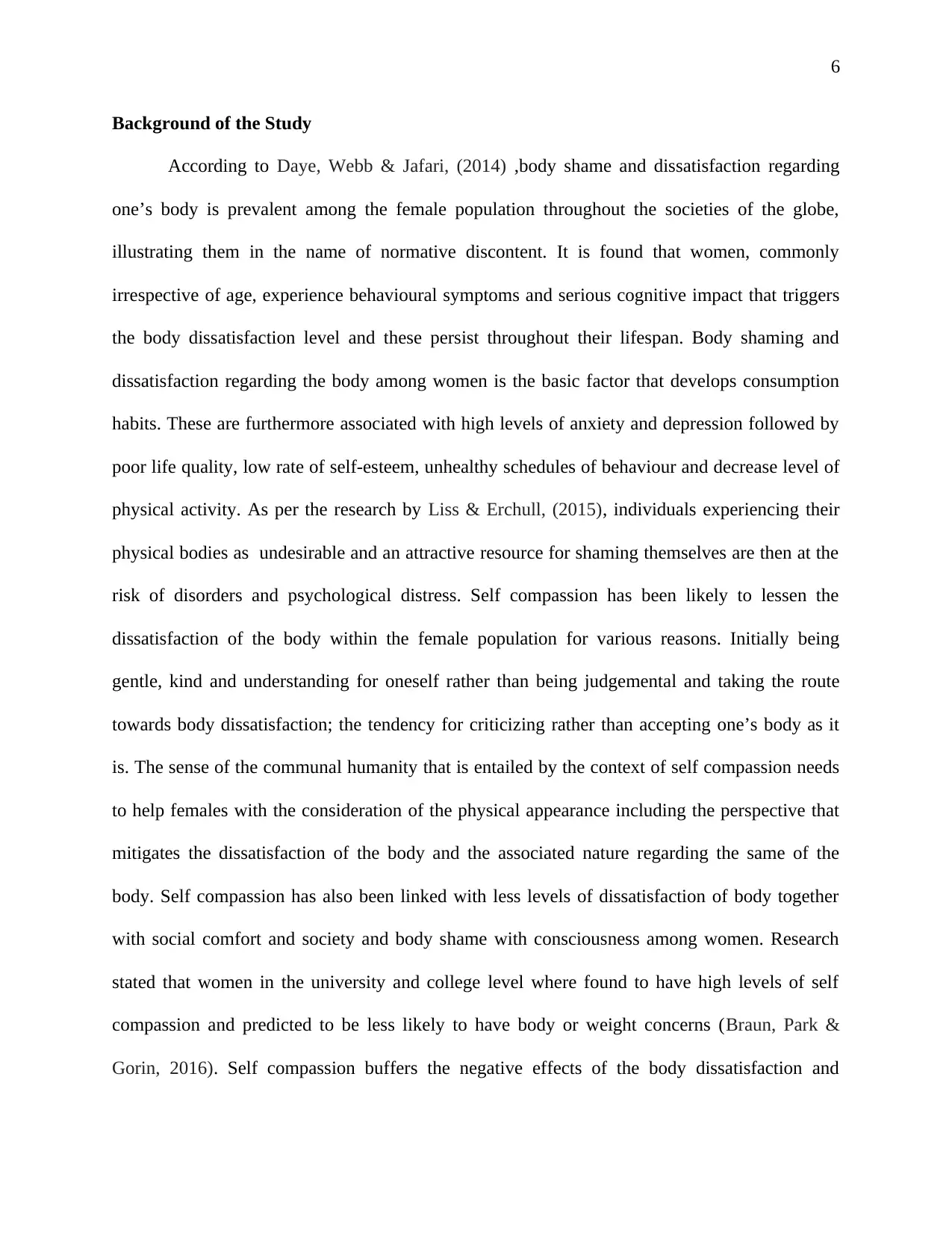
6
Background of the Study
According to Daye, Webb & Jafari, (2014) ,body shame and dissatisfaction regarding
one’s body is prevalent among the female population throughout the societies of the globe,
illustrating them in the name of normative discontent. It is found that women, commonly
irrespective of age, experience behavioural symptoms and serious cognitive impact that triggers
the body dissatisfaction level and these persist throughout their lifespan. Body shaming and
dissatisfaction regarding the body among women is the basic factor that develops consumption
habits. These are furthermore associated with high levels of anxiety and depression followed by
poor life quality, low rate of self-esteem, unhealthy schedules of behaviour and decrease level of
physical activity. As per the research by Liss & Erchull, (2015), individuals experiencing their
physical bodies as undesirable and an attractive resource for shaming themselves are then at the
risk of disorders and psychological distress. Self compassion has been likely to lessen the
dissatisfaction of the body within the female population for various reasons. Initially being
gentle, kind and understanding for oneself rather than being judgemental and taking the route
towards body dissatisfaction; the tendency for criticizing rather than accepting one’s body as it
is. The sense of the communal humanity that is entailed by the context of self compassion needs
to help females with the consideration of the physical appearance including the perspective that
mitigates the dissatisfaction of the body and the associated nature regarding the same of the
body. Self compassion has also been linked with less levels of dissatisfaction of body together
with social comfort and society and body shame with consciousness among women. Research
stated that women in the university and college level where found to have high levels of self
compassion and predicted to be less likely to have body or weight concerns (Braun, Park &
Gorin, 2016). Self compassion buffers the negative effects of the body dissatisfaction and
Background of the Study
According to Daye, Webb & Jafari, (2014) ,body shame and dissatisfaction regarding
one’s body is prevalent among the female population throughout the societies of the globe,
illustrating them in the name of normative discontent. It is found that women, commonly
irrespective of age, experience behavioural symptoms and serious cognitive impact that triggers
the body dissatisfaction level and these persist throughout their lifespan. Body shaming and
dissatisfaction regarding the body among women is the basic factor that develops consumption
habits. These are furthermore associated with high levels of anxiety and depression followed by
poor life quality, low rate of self-esteem, unhealthy schedules of behaviour and decrease level of
physical activity. As per the research by Liss & Erchull, (2015), individuals experiencing their
physical bodies as undesirable and an attractive resource for shaming themselves are then at the
risk of disorders and psychological distress. Self compassion has been likely to lessen the
dissatisfaction of the body within the female population for various reasons. Initially being
gentle, kind and understanding for oneself rather than being judgemental and taking the route
towards body dissatisfaction; the tendency for criticizing rather than accepting one’s body as it
is. The sense of the communal humanity that is entailed by the context of self compassion needs
to help females with the consideration of the physical appearance including the perspective that
mitigates the dissatisfaction of the body and the associated nature regarding the same of the
body. Self compassion has also been linked with less levels of dissatisfaction of body together
with social comfort and society and body shame with consciousness among women. Research
stated that women in the university and college level where found to have high levels of self
compassion and predicted to be less likely to have body or weight concerns (Braun, Park &
Gorin, 2016). Self compassion buffers the negative effects of the body dissatisfaction and
Paraphrase This Document
Need a fresh take? Get an instant paraphrase of this document with our AI Paraphraser
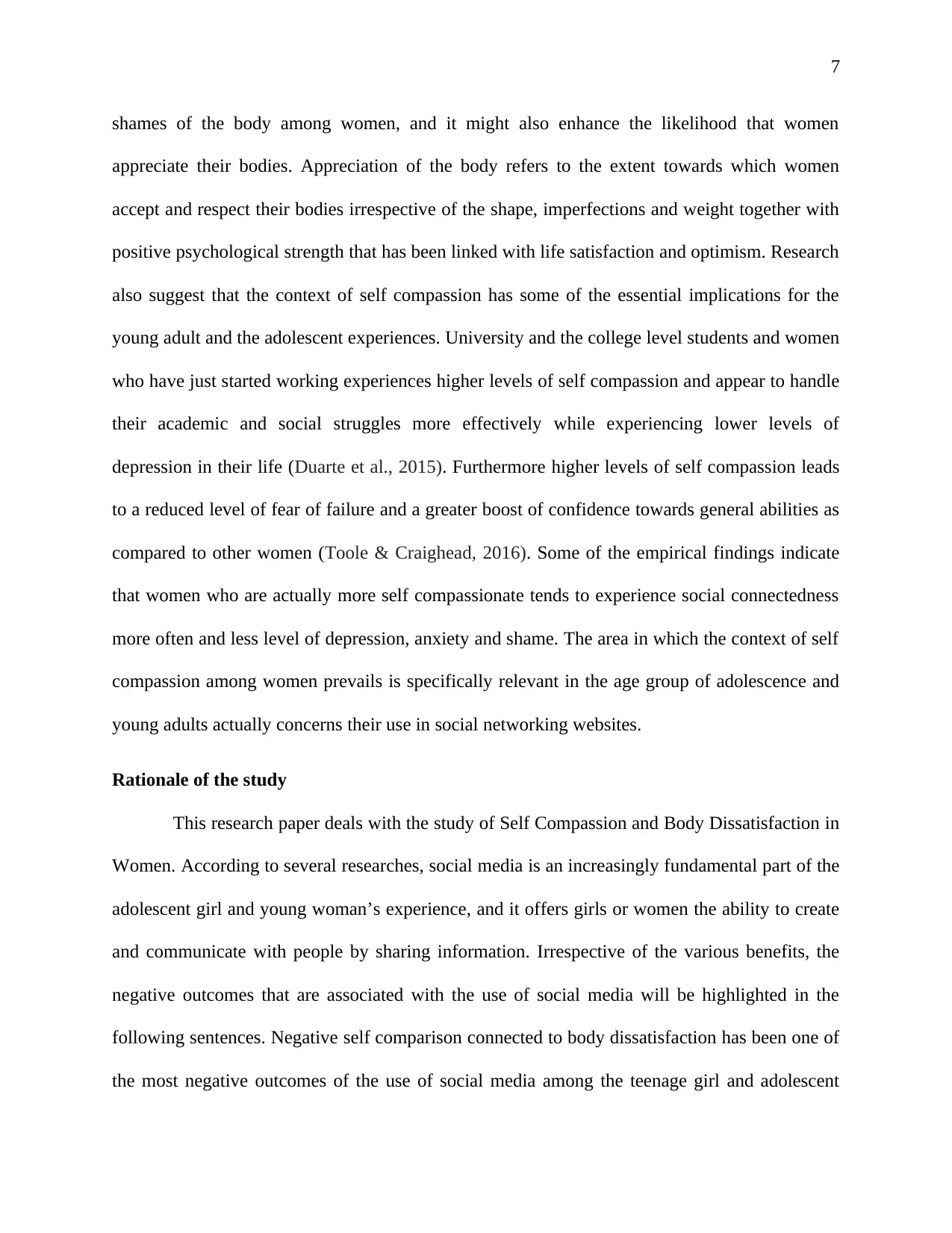
7
shames of the body among women, and it might also enhance the likelihood that women
appreciate their bodies. Appreciation of the body refers to the extent towards which women
accept and respect their bodies irrespective of the shape, imperfections and weight together with
positive psychological strength that has been linked with life satisfaction and optimism. Research
also suggest that the context of self compassion has some of the essential implications for the
young adult and the adolescent experiences. University and the college level students and women
who have just started working experiences higher levels of self compassion and appear to handle
their academic and social struggles more effectively while experiencing lower levels of
depression in their life (Duarte et al., 2015). Furthermore higher levels of self compassion leads
to a reduced level of fear of failure and a greater boost of confidence towards general abilities as
compared to other women (Toole & Craighead, 2016). Some of the empirical findings indicate
that women who are actually more self compassionate tends to experience social connectedness
more often and less level of depression, anxiety and shame. The area in which the context of self
compassion among women prevails is specifically relevant in the age group of adolescence and
young adults actually concerns their use in social networking websites.
Rationale of the study
This research paper deals with the study of Self Compassion and Body Dissatisfaction in
Women. According to several researches, social media is an increasingly fundamental part of the
adolescent girl and young woman’s experience, and it offers girls or women the ability to create
and communicate with people by sharing information. Irrespective of the various benefits, the
negative outcomes that are associated with the use of social media will be highlighted in the
following sentences. Negative self comparison connected to body dissatisfaction has been one of
the most negative outcomes of the use of social media among the teenage girl and adolescent
shames of the body among women, and it might also enhance the likelihood that women
appreciate their bodies. Appreciation of the body refers to the extent towards which women
accept and respect their bodies irrespective of the shape, imperfections and weight together with
positive psychological strength that has been linked with life satisfaction and optimism. Research
also suggest that the context of self compassion has some of the essential implications for the
young adult and the adolescent experiences. University and the college level students and women
who have just started working experiences higher levels of self compassion and appear to handle
their academic and social struggles more effectively while experiencing lower levels of
depression in their life (Duarte et al., 2015). Furthermore higher levels of self compassion leads
to a reduced level of fear of failure and a greater boost of confidence towards general abilities as
compared to other women (Toole & Craighead, 2016). Some of the empirical findings indicate
that women who are actually more self compassionate tends to experience social connectedness
more often and less level of depression, anxiety and shame. The area in which the context of self
compassion among women prevails is specifically relevant in the age group of adolescence and
young adults actually concerns their use in social networking websites.
Rationale of the study
This research paper deals with the study of Self Compassion and Body Dissatisfaction in
Women. According to several researches, social media is an increasingly fundamental part of the
adolescent girl and young woman’s experience, and it offers girls or women the ability to create
and communicate with people by sharing information. Irrespective of the various benefits, the
negative outcomes that are associated with the use of social media will be highlighted in the
following sentences. Negative self comparison connected to body dissatisfaction has been one of
the most negative outcomes of the use of social media among the teenage girl and adolescent
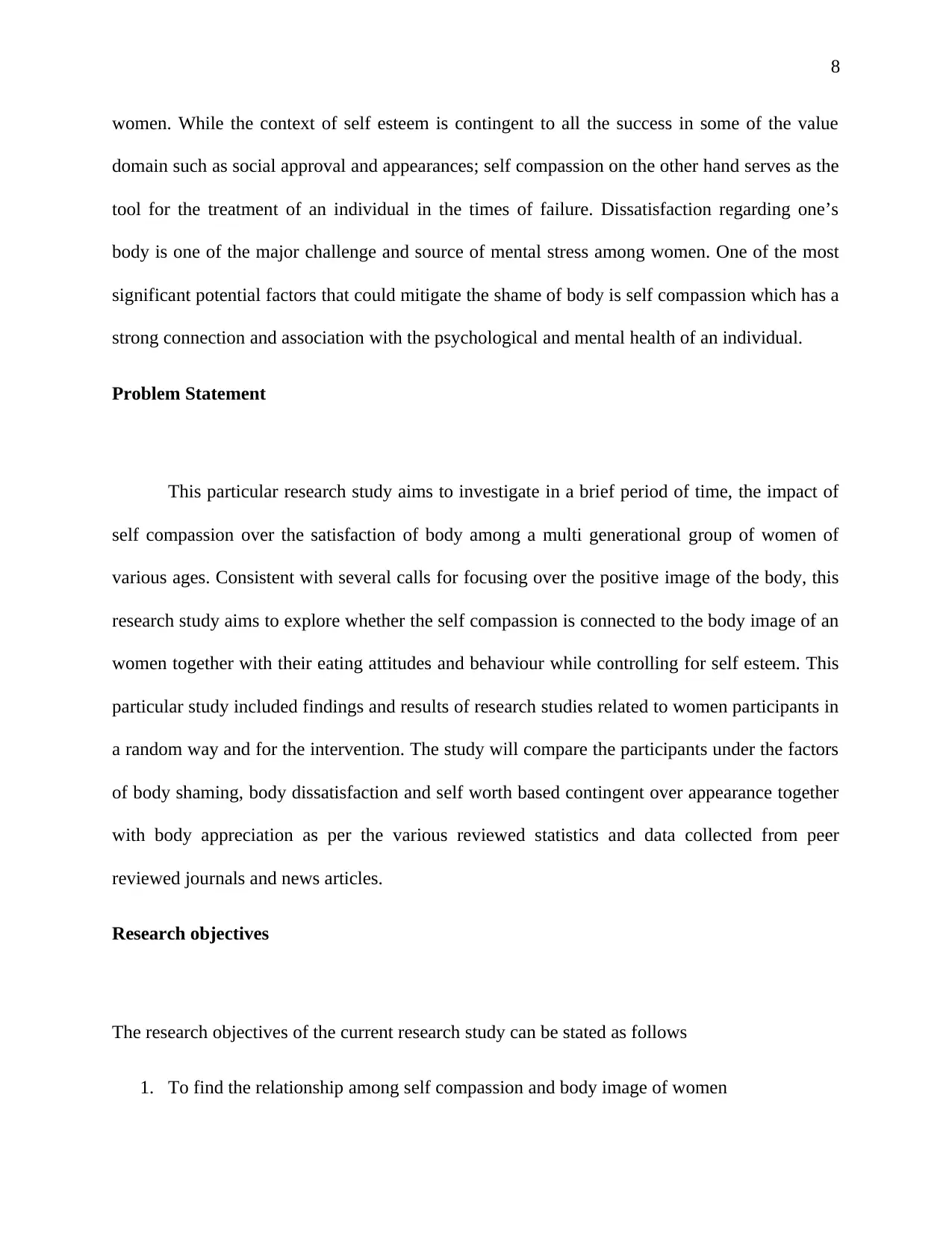
8
women. While the context of self esteem is contingent to all the success in some of the value
domain such as social approval and appearances; self compassion on the other hand serves as the
tool for the treatment of an individual in the times of failure. Dissatisfaction regarding one’s
body is one of the major challenge and source of mental stress among women. One of the most
significant potential factors that could mitigate the shame of body is self compassion which has a
strong connection and association with the psychological and mental health of an individual.
Problem Statement
This particular research study aims to investigate in a brief period of time, the impact of
self compassion over the satisfaction of body among a multi generational group of women of
various ages. Consistent with several calls for focusing over the positive image of the body, this
research study aims to explore whether the self compassion is connected to the body image of an
women together with their eating attitudes and behaviour while controlling for self esteem. This
particular study included findings and results of research studies related to women participants in
a random way and for the intervention. The study will compare the participants under the factors
of body shaming, body dissatisfaction and self worth based contingent over appearance together
with body appreciation as per the various reviewed statistics and data collected from peer
reviewed journals and news articles.
Research objectives
The research objectives of the current research study can be stated as follows
1. To find the relationship among self compassion and body image of women
women. While the context of self esteem is contingent to all the success in some of the value
domain such as social approval and appearances; self compassion on the other hand serves as the
tool for the treatment of an individual in the times of failure. Dissatisfaction regarding one’s
body is one of the major challenge and source of mental stress among women. One of the most
significant potential factors that could mitigate the shame of body is self compassion which has a
strong connection and association with the psychological and mental health of an individual.
Problem Statement
This particular research study aims to investigate in a brief period of time, the impact of
self compassion over the satisfaction of body among a multi generational group of women of
various ages. Consistent with several calls for focusing over the positive image of the body, this
research study aims to explore whether the self compassion is connected to the body image of an
women together with their eating attitudes and behaviour while controlling for self esteem. This
particular study included findings and results of research studies related to women participants in
a random way and for the intervention. The study will compare the participants under the factors
of body shaming, body dissatisfaction and self worth based contingent over appearance together
with body appreciation as per the various reviewed statistics and data collected from peer
reviewed journals and news articles.
Research objectives
The research objectives of the current research study can be stated as follows
1. To find the relationship among self compassion and body image of women
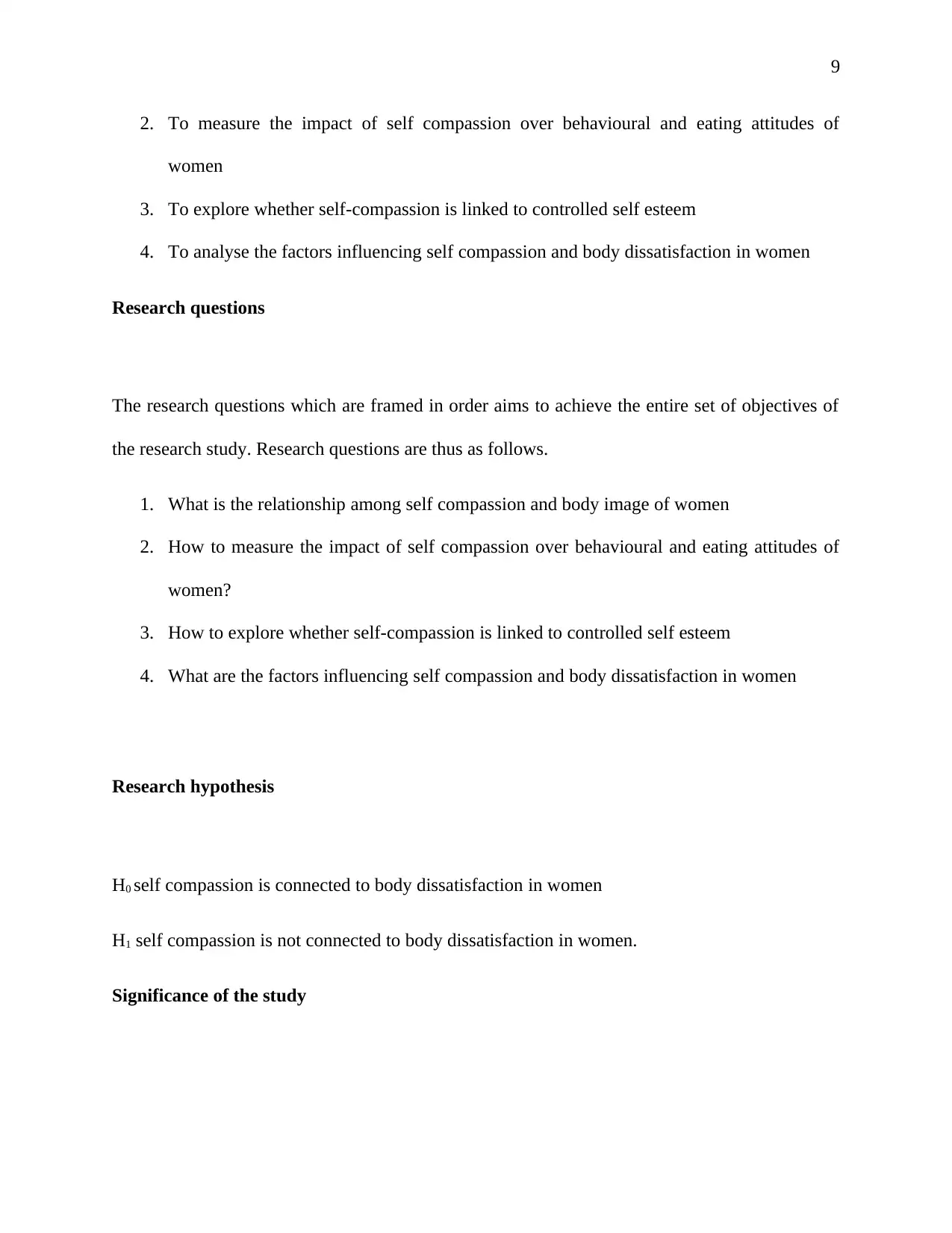
9
2. To measure the impact of self compassion over behavioural and eating attitudes of
women
3. To explore whether self-compassion is linked to controlled self esteem
4. To analyse the factors influencing self compassion and body dissatisfaction in women
Research questions
The research questions which are framed in order aims to achieve the entire set of objectives of
the research study. Research questions are thus as follows.
1. What is the relationship among self compassion and body image of women
2. How to measure the impact of self compassion over behavioural and eating attitudes of
women?
3. How to explore whether self-compassion is linked to controlled self esteem
4. What are the factors influencing self compassion and body dissatisfaction in women
Research hypothesis
H0 self compassion is connected to body dissatisfaction in women
H1 self compassion is not connected to body dissatisfaction in women.
Significance of the study
2. To measure the impact of self compassion over behavioural and eating attitudes of
women
3. To explore whether self-compassion is linked to controlled self esteem
4. To analyse the factors influencing self compassion and body dissatisfaction in women
Research questions
The research questions which are framed in order aims to achieve the entire set of objectives of
the research study. Research questions are thus as follows.
1. What is the relationship among self compassion and body image of women
2. How to measure the impact of self compassion over behavioural and eating attitudes of
women?
3. How to explore whether self-compassion is linked to controlled self esteem
4. What are the factors influencing self compassion and body dissatisfaction in women
Research hypothesis
H0 self compassion is connected to body dissatisfaction in women
H1 self compassion is not connected to body dissatisfaction in women.
Significance of the study
Secure Best Marks with AI Grader
Need help grading? Try our AI Grader for instant feedback on your assignments.
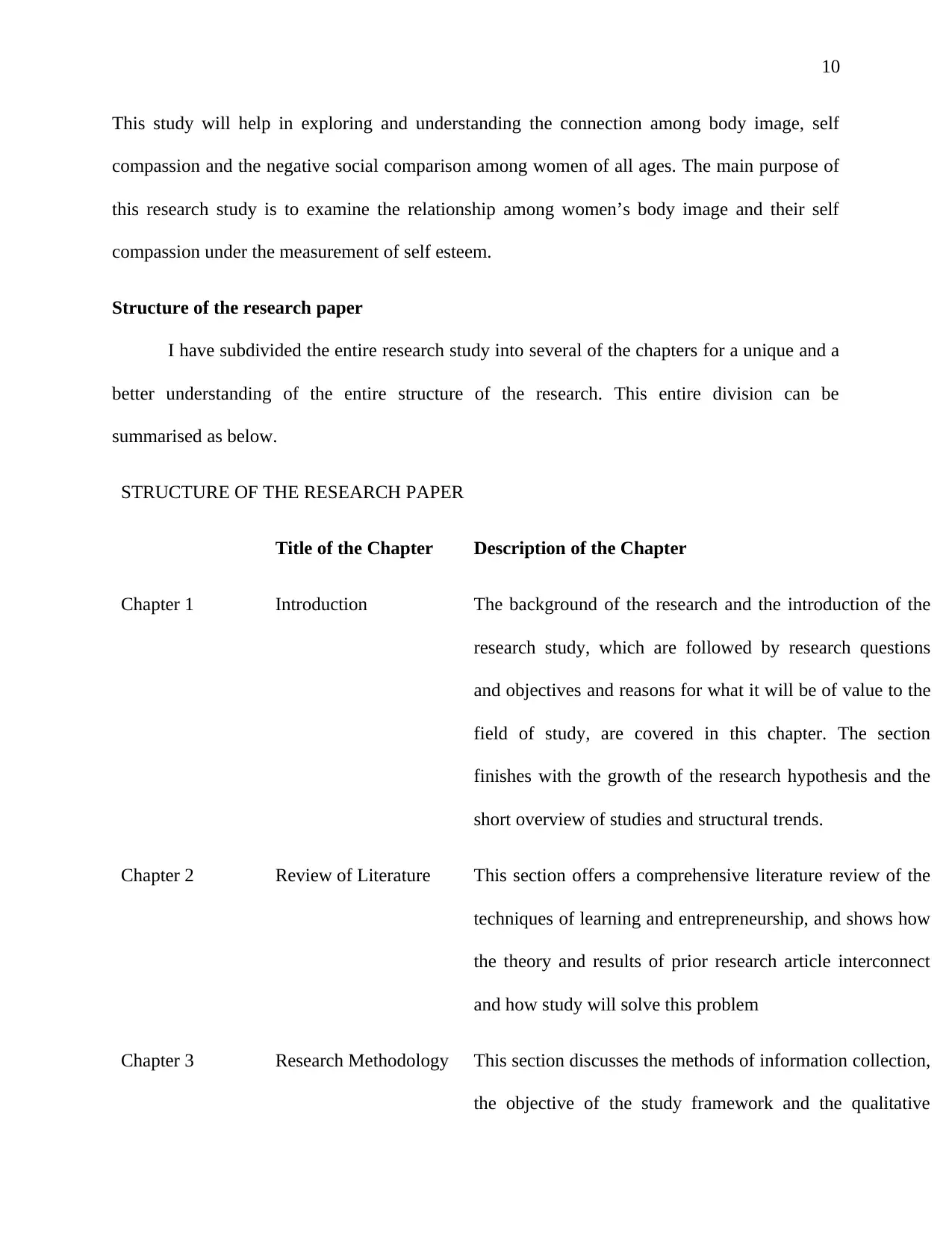
10
This study will help in exploring and understanding the connection among body image, self
compassion and the negative social comparison among women of all ages. The main purpose of
this research study is to examine the relationship among women’s body image and their self
compassion under the measurement of self esteem.
Structure of the research paper
I have subdivided the entire research study into several of the chapters for a unique and a
better understanding of the entire structure of the research. This entire division can be
summarised as below.
STRUCTURE OF THE RESEARCH PAPER
Title of the Chapter Description of the Chapter
Chapter 1 Introduction The background of the research and the introduction of the
research study, which are followed by research questions
and objectives and reasons for what it will be of value to the
field of study, are covered in this chapter. The section
finishes with the growth of the research hypothesis and the
short overview of studies and structural trends.
Chapter 2 Review of Literature This section offers a comprehensive literature review of the
techniques of learning and entrepreneurship, and shows how
the theory and results of prior research article interconnect
and how study will solve this problem
Chapter 3 Research Methodology This section discusses the methods of information collection,
the objective of the study framework and the qualitative
This study will help in exploring and understanding the connection among body image, self
compassion and the negative social comparison among women of all ages. The main purpose of
this research study is to examine the relationship among women’s body image and their self
compassion under the measurement of self esteem.
Structure of the research paper
I have subdivided the entire research study into several of the chapters for a unique and a
better understanding of the entire structure of the research. This entire division can be
summarised as below.
STRUCTURE OF THE RESEARCH PAPER
Title of the Chapter Description of the Chapter
Chapter 1 Introduction The background of the research and the introduction of the
research study, which are followed by research questions
and objectives and reasons for what it will be of value to the
field of study, are covered in this chapter. The section
finishes with the growth of the research hypothesis and the
short overview of studies and structural trends.
Chapter 2 Review of Literature This section offers a comprehensive literature review of the
techniques of learning and entrepreneurship, and shows how
the theory and results of prior research article interconnect
and how study will solve this problem
Chapter 3 Research Methodology This section discusses the methods of information collection,
the objective of the study framework and the qualitative
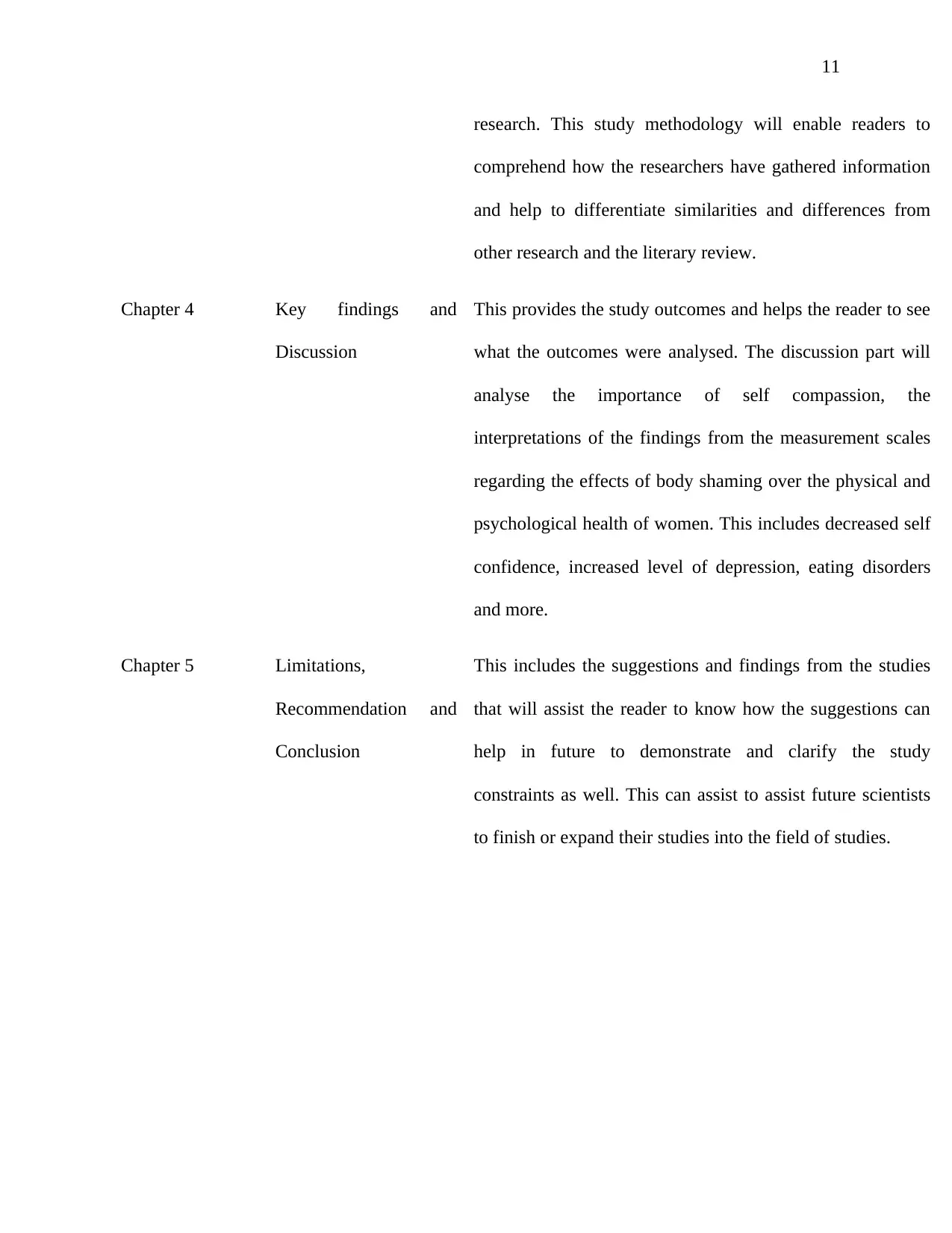
11
research. This study methodology will enable readers to
comprehend how the researchers have gathered information
and help to differentiate similarities and differences from
other research and the literary review.
Chapter 4 Key findings and
Discussion
This provides the study outcomes and helps the reader to see
what the outcomes were analysed. The discussion part will
analyse the importance of self compassion, the
interpretations of the findings from the measurement scales
regarding the effects of body shaming over the physical and
psychological health of women. This includes decreased self
confidence, increased level of depression, eating disorders
and more.
Chapter 5 Limitations,
Recommendation and
Conclusion
This includes the suggestions and findings from the studies
that will assist the reader to know how the suggestions can
help in future to demonstrate and clarify the study
constraints as well. This can assist to assist future scientists
to finish or expand their studies into the field of studies.
research. This study methodology will enable readers to
comprehend how the researchers have gathered information
and help to differentiate similarities and differences from
other research and the literary review.
Chapter 4 Key findings and
Discussion
This provides the study outcomes and helps the reader to see
what the outcomes were analysed. The discussion part will
analyse the importance of self compassion, the
interpretations of the findings from the measurement scales
regarding the effects of body shaming over the physical and
psychological health of women. This includes decreased self
confidence, increased level of depression, eating disorders
and more.
Chapter 5 Limitations,
Recommendation and
Conclusion
This includes the suggestions and findings from the studies
that will assist the reader to know how the suggestions can
help in future to demonstrate and clarify the study
constraints as well. This can assist to assist future scientists
to finish or expand their studies into the field of studies.

12
Paraphrase This Document
Need a fresh take? Get an instant paraphrase of this document with our AI Paraphraser

13
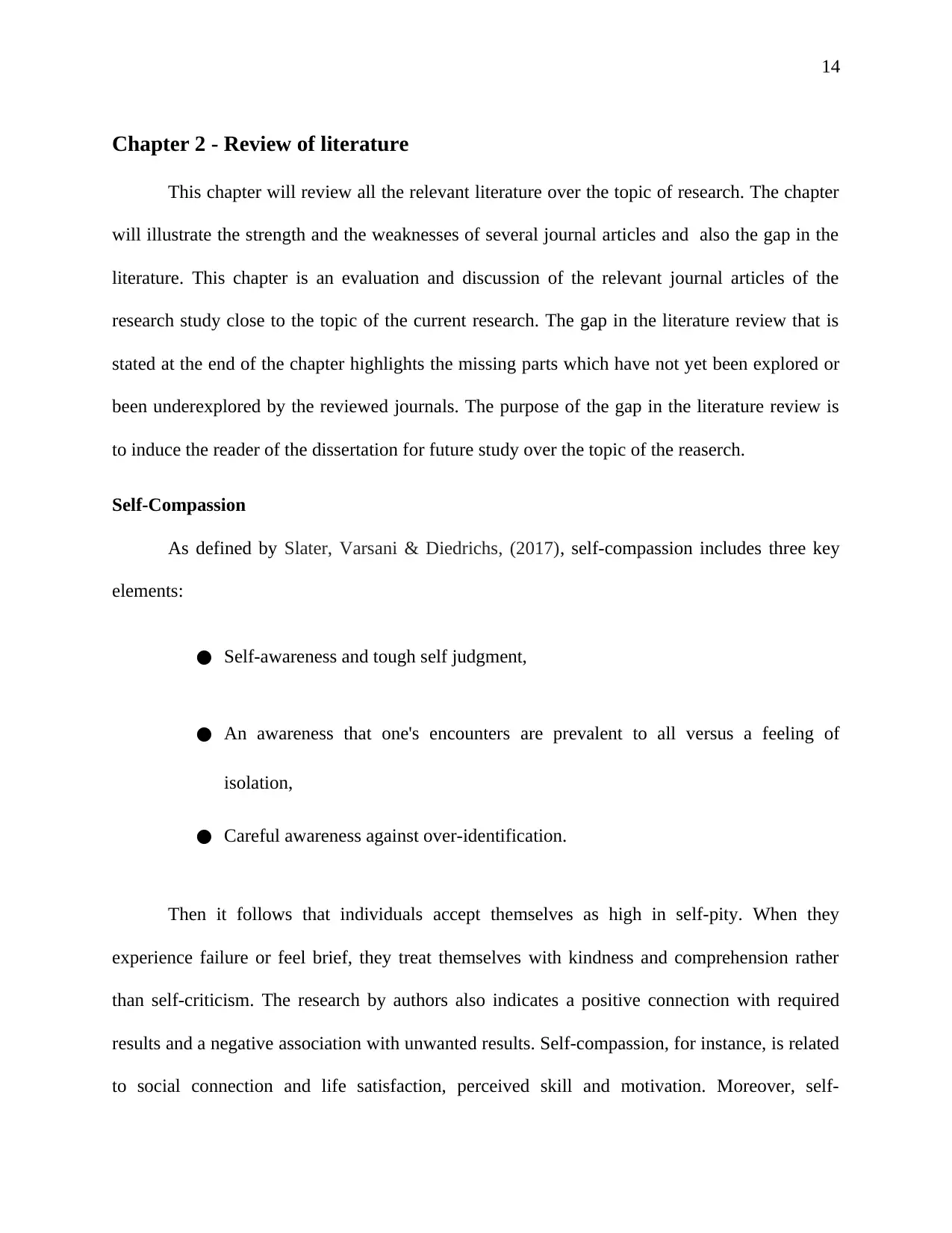
14
Chapter 2 - Review of literature
This chapter will review all the relevant literature over the topic of research. The chapter
will illustrate the strength and the weaknesses of several journal articles and also the gap in the
literature. This chapter is an evaluation and discussion of the relevant journal articles of the
research study close to the topic of the current research. The gap in the literature review that is
stated at the end of the chapter highlights the missing parts which have not yet been explored or
been underexplored by the reviewed journals. The purpose of the gap in the literature review is
to induce the reader of the dissertation for future study over the topic of the reaserch.
Self-Compassion
As defined by Slater, Varsani & Diedrichs, (2017), self-compassion includes three key
elements:
● Self-awareness and tough self judgment,
● An awareness that one's encounters are prevalent to all versus a feeling of
isolation,
● Careful awareness against over-identification.
Then it follows that individuals accept themselves as high in self-pity. When they
experience failure or feel brief, they treat themselves with kindness and comprehension rather
than self-criticism. The research by authors also indicates a positive connection with required
results and a negative association with unwanted results. Self-compassion, for instance, is related
to social connection and life satisfaction, perceived skill and motivation. Moreover, self-
Chapter 2 - Review of literature
This chapter will review all the relevant literature over the topic of research. The chapter
will illustrate the strength and the weaknesses of several journal articles and also the gap in the
literature. This chapter is an evaluation and discussion of the relevant journal articles of the
research study close to the topic of the current research. The gap in the literature review that is
stated at the end of the chapter highlights the missing parts which have not yet been explored or
been underexplored by the reviewed journals. The purpose of the gap in the literature review is
to induce the reader of the dissertation for future study over the topic of the reaserch.
Self-Compassion
As defined by Slater, Varsani & Diedrichs, (2017), self-compassion includes three key
elements:
● Self-awareness and tough self judgment,
● An awareness that one's encounters are prevalent to all versus a feeling of
isolation,
● Careful awareness against over-identification.
Then it follows that individuals accept themselves as high in self-pity. When they
experience failure or feel brief, they treat themselves with kindness and comprehension rather
than self-criticism. The research by authors also indicates a positive connection with required
results and a negative association with unwanted results. Self-compassion, for instance, is related
to social connection and life satisfaction, perceived skill and motivation. Moreover, self-
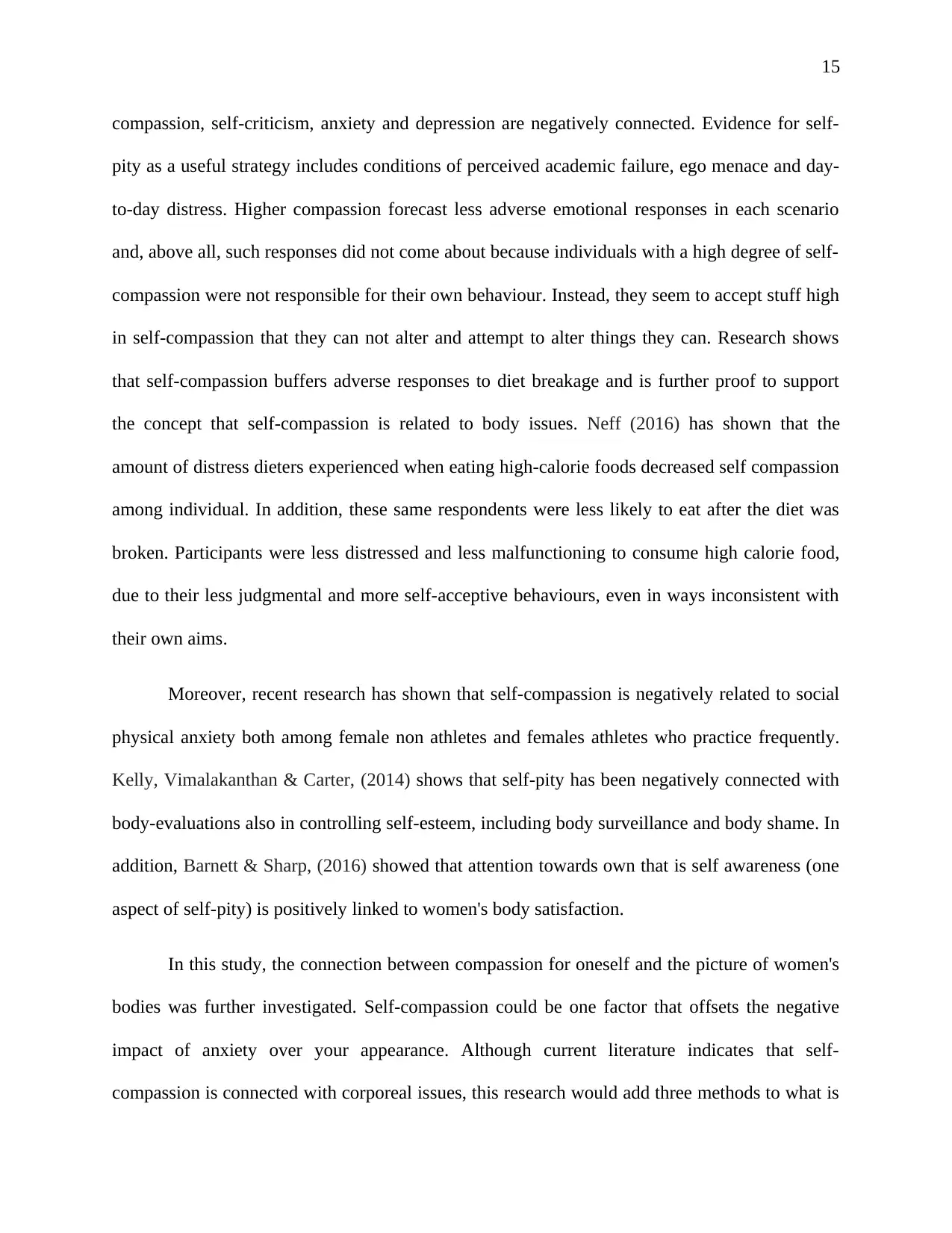
15
compassion, self-criticism, anxiety and depression are negatively connected. Evidence for self-
pity as a useful strategy includes conditions of perceived academic failure, ego menace and day-
to-day distress. Higher compassion forecast less adverse emotional responses in each scenario
and, above all, such responses did not come about because individuals with a high degree of self-
compassion were not responsible for their own behaviour. Instead, they seem to accept stuff high
in self-compassion that they can not alter and attempt to alter things they can. Research shows
that self-compassion buffers adverse responses to diet breakage and is further proof to support
the concept that self-compassion is related to body issues. Neff (2016) has shown that the
amount of distress dieters experienced when eating high-calorie foods decreased self compassion
among individual. In addition, these same respondents were less likely to eat after the diet was
broken. Participants were less distressed and less malfunctioning to consume high calorie food,
due to their less judgmental and more self-acceptive behaviours, even in ways inconsistent with
their own aims.
Moreover, recent research has shown that self-compassion is negatively related to social
physical anxiety both among female non athletes and females athletes who practice frequently.
Kelly, Vimalakanthan & Carter, (2014) shows that self-pity has been negatively connected with
body-evaluations also in controlling self-esteem, including body surveillance and body shame. In
addition, Barnett & Sharp, (2016) showed that attention towards own that is self awareness (one
aspect of self-pity) is positively linked to women's body satisfaction.
In this study, the connection between compassion for oneself and the picture of women's
bodies was further investigated. Self-compassion could be one factor that offsets the negative
impact of anxiety over your appearance. Although current literature indicates that self-
compassion is connected with corporeal issues, this research would add three methods to what is
compassion, self-criticism, anxiety and depression are negatively connected. Evidence for self-
pity as a useful strategy includes conditions of perceived academic failure, ego menace and day-
to-day distress. Higher compassion forecast less adverse emotional responses in each scenario
and, above all, such responses did not come about because individuals with a high degree of self-
compassion were not responsible for their own behaviour. Instead, they seem to accept stuff high
in self-compassion that they can not alter and attempt to alter things they can. Research shows
that self-compassion buffers adverse responses to diet breakage and is further proof to support
the concept that self-compassion is related to body issues. Neff (2016) has shown that the
amount of distress dieters experienced when eating high-calorie foods decreased self compassion
among individual. In addition, these same respondents were less likely to eat after the diet was
broken. Participants were less distressed and less malfunctioning to consume high calorie food,
due to their less judgmental and more self-acceptive behaviours, even in ways inconsistent with
their own aims.
Moreover, recent research has shown that self-compassion is negatively related to social
physical anxiety both among female non athletes and females athletes who practice frequently.
Kelly, Vimalakanthan & Carter, (2014) shows that self-pity has been negatively connected with
body-evaluations also in controlling self-esteem, including body surveillance and body shame. In
addition, Barnett & Sharp, (2016) showed that attention towards own that is self awareness (one
aspect of self-pity) is positively linked to women's body satisfaction.
In this study, the connection between compassion for oneself and the picture of women's
bodies was further investigated. Self-compassion could be one factor that offsets the negative
impact of anxiety over your appearance. Although current literature indicates that self-
compassion is connected with corporeal issues, this research would add three methods to what is
Secure Best Marks with AI Grader
Need help grading? Try our AI Grader for instant feedback on your assignments.
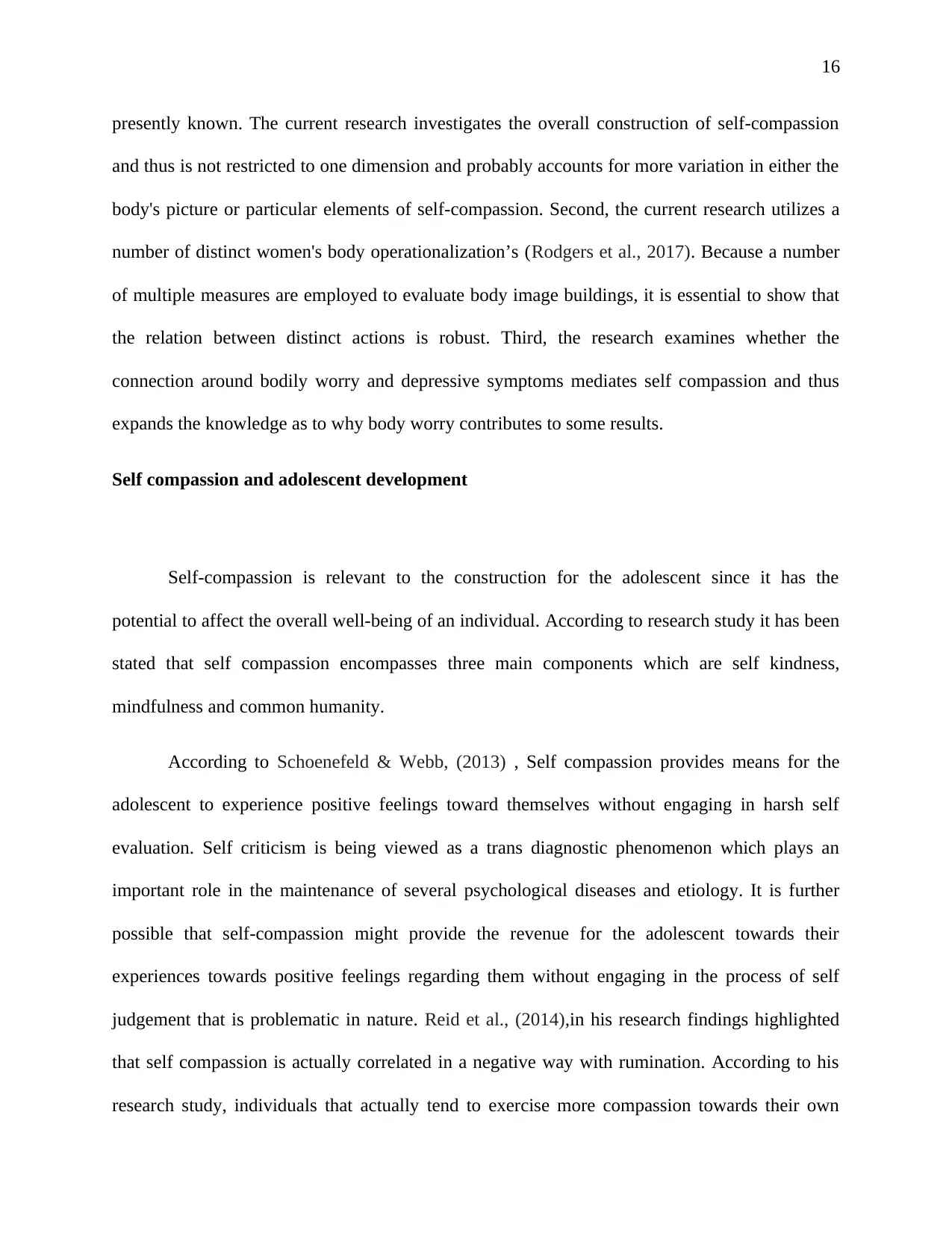
16
presently known. The current research investigates the overall construction of self-compassion
and thus is not restricted to one dimension and probably accounts for more variation in either the
body's picture or particular elements of self-compassion. Second, the current research utilizes a
number of distinct women's body operationalization’s (Rodgers et al., 2017). Because a number
of multiple measures are employed to evaluate body image buildings, it is essential to show that
the relation between distinct actions is robust. Third, the research examines whether the
connection around bodily worry and depressive symptoms mediates self compassion and thus
expands the knowledge as to why body worry contributes to some results.
Self compassion and adolescent development
Self-compassion is relevant to the construction for the adolescent since it has the
potential to affect the overall well-being of an individual. According to research study it has been
stated that self compassion encompasses three main components which are self kindness,
mindfulness and common humanity.
According to Schoenefeld & Webb, (2013) , Self compassion provides means for the
adolescent to experience positive feelings toward themselves without engaging in harsh self
evaluation. Self criticism is being viewed as a trans diagnostic phenomenon which plays an
important role in the maintenance of several psychological diseases and etiology. It is further
possible that self-compassion might provide the revenue for the adolescent towards their
experiences towards positive feelings regarding them without engaging in the process of self
judgement that is problematic in nature. Reid et al., (2014),in his research findings highlighted
that self compassion is actually correlated in a negative way with rumination. According to his
research study, individuals that actually tend to exercise more compassion towards their own
presently known. The current research investigates the overall construction of self-compassion
and thus is not restricted to one dimension and probably accounts for more variation in either the
body's picture or particular elements of self-compassion. Second, the current research utilizes a
number of distinct women's body operationalization’s (Rodgers et al., 2017). Because a number
of multiple measures are employed to evaluate body image buildings, it is essential to show that
the relation between distinct actions is robust. Third, the research examines whether the
connection around bodily worry and depressive symptoms mediates self compassion and thus
expands the knowledge as to why body worry contributes to some results.
Self compassion and adolescent development
Self-compassion is relevant to the construction for the adolescent since it has the
potential to affect the overall well-being of an individual. According to research study it has been
stated that self compassion encompasses three main components which are self kindness,
mindfulness and common humanity.
According to Schoenefeld & Webb, (2013) , Self compassion provides means for the
adolescent to experience positive feelings toward themselves without engaging in harsh self
evaluation. Self criticism is being viewed as a trans diagnostic phenomenon which plays an
important role in the maintenance of several psychological diseases and etiology. It is further
possible that self-compassion might provide the revenue for the adolescent towards their
experiences towards positive feelings regarding them without engaging in the process of self
judgement that is problematic in nature. Reid et al., (2014),in his research findings highlighted
that self compassion is actually correlated in a negative way with rumination. According to his
research study, individuals that actually tend to exercise more compassion towards their own
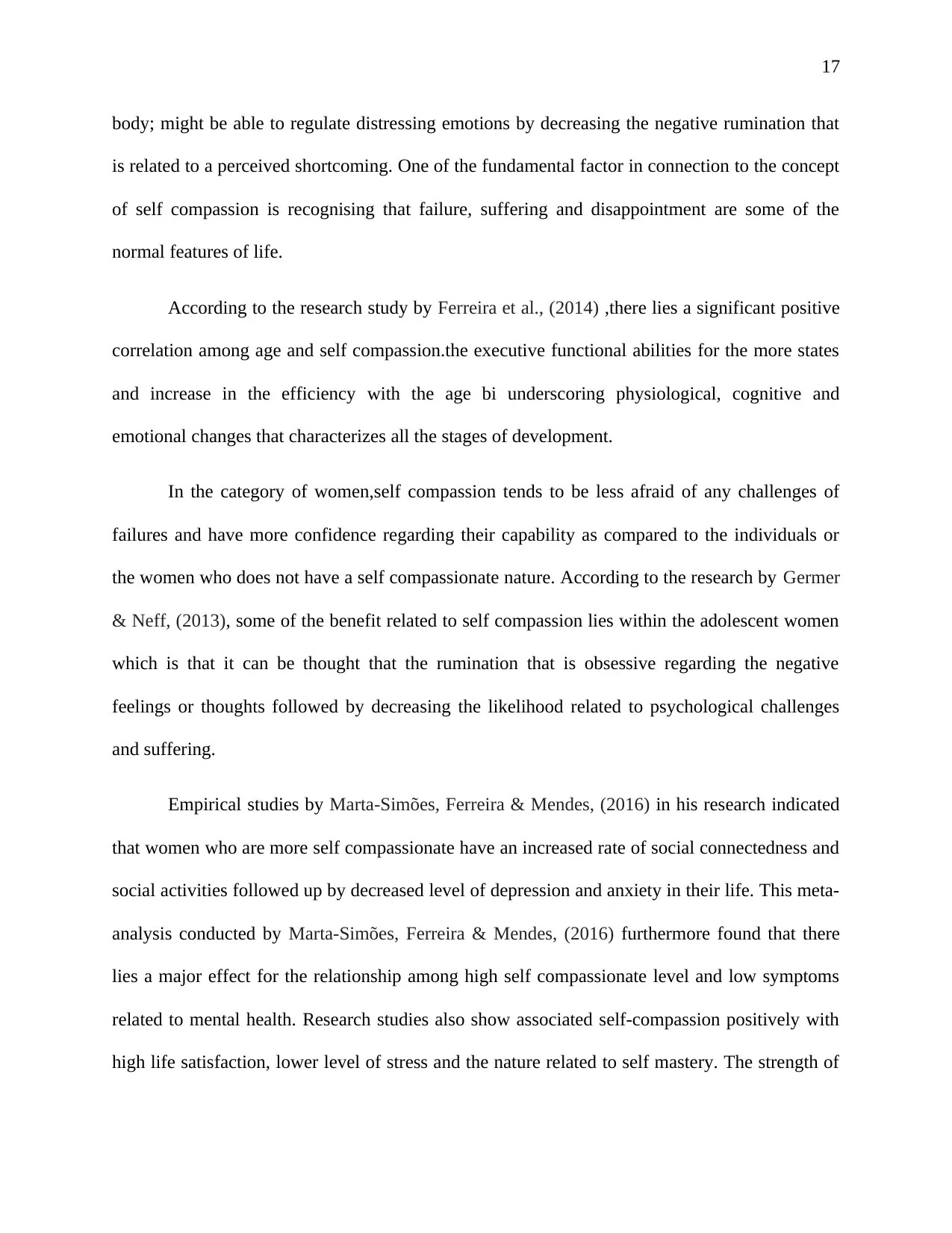
17
body; might be able to regulate distressing emotions by decreasing the negative rumination that
is related to a perceived shortcoming. One of the fundamental factor in connection to the concept
of self compassion is recognising that failure, suffering and disappointment are some of the
normal features of life.
According to the research study by Ferreira et al., (2014) ,there lies a significant positive
correlation among age and self compassion.the executive functional abilities for the more states
and increase in the efficiency with the age bi underscoring physiological, cognitive and
emotional changes that characterizes all the stages of development.
In the category of women,self compassion tends to be less afraid of any challenges of
failures and have more confidence regarding their capability as compared to the individuals or
the women who does not have a self compassionate nature. According to the research by Germer
& Neff, (2013), some of the benefit related to self compassion lies within the adolescent women
which is that it can be thought that the rumination that is obsessive regarding the negative
feelings or thoughts followed by decreasing the likelihood related to psychological challenges
and suffering.
Empirical studies by Marta-Simões, Ferreira & Mendes, (2016) in his research indicated
that women who are more self compassionate have an increased rate of social connectedness and
social activities followed up by decreased level of depression and anxiety in their life. This meta-
analysis conducted by Marta-Simões, Ferreira & Mendes, (2016) furthermore found that there
lies a major effect for the relationship among high self compassionate level and low symptoms
related to mental health. Research studies also show associated self-compassion positively with
high life satisfaction, lower level of stress and the nature related to self mastery. The strength of
body; might be able to regulate distressing emotions by decreasing the negative rumination that
is related to a perceived shortcoming. One of the fundamental factor in connection to the concept
of self compassion is recognising that failure, suffering and disappointment are some of the
normal features of life.
According to the research study by Ferreira et al., (2014) ,there lies a significant positive
correlation among age and self compassion.the executive functional abilities for the more states
and increase in the efficiency with the age bi underscoring physiological, cognitive and
emotional changes that characterizes all the stages of development.
In the category of women,self compassion tends to be less afraid of any challenges of
failures and have more confidence regarding their capability as compared to the individuals or
the women who does not have a self compassionate nature. According to the research by Germer
& Neff, (2013), some of the benefit related to self compassion lies within the adolescent women
which is that it can be thought that the rumination that is obsessive regarding the negative
feelings or thoughts followed by decreasing the likelihood related to psychological challenges
and suffering.
Empirical studies by Marta-Simões, Ferreira & Mendes, (2016) in his research indicated
that women who are more self compassionate have an increased rate of social connectedness and
social activities followed up by decreased level of depression and anxiety in their life. This meta-
analysis conducted by Marta-Simões, Ferreira & Mendes, (2016) furthermore found that there
lies a major effect for the relationship among high self compassionate level and low symptoms
related to mental health. Research studies also show associated self-compassion positively with
high life satisfaction, lower level of stress and the nature related to self mastery. The strength of
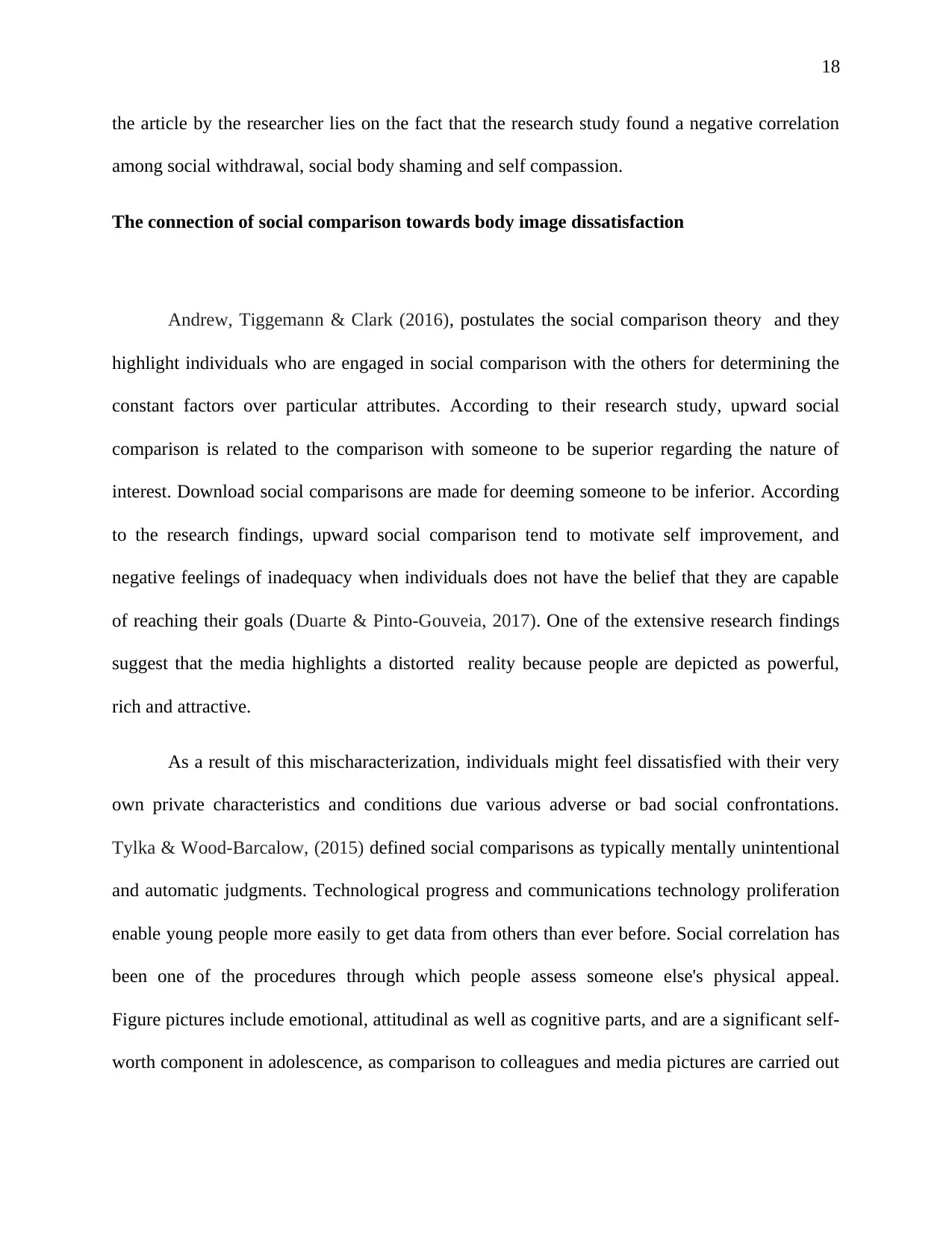
18
the article by the researcher lies on the fact that the research study found a negative correlation
among social withdrawal, social body shaming and self compassion.
The connection of social comparison towards body image dissatisfaction
Andrew, Tiggemann & Clark (2016), postulates the social comparison theory and they
highlight individuals who are engaged in social comparison with the others for determining the
constant factors over particular attributes. According to their research study, upward social
comparison is related to the comparison with someone to be superior regarding the nature of
interest. Download social comparisons are made for deeming someone to be inferior. According
to the research findings, upward social comparison tend to motivate self improvement, and
negative feelings of inadequacy when individuals does not have the belief that they are capable
of reaching their goals (Duarte & Pinto-Gouveia, 2017). One of the extensive research findings
suggest that the media highlights a distorted reality because people are depicted as powerful,
rich and attractive.
As a result of this mischaracterization, individuals might feel dissatisfied with their very
own private characteristics and conditions due various adverse or bad social confrontations.
Tylka & Wood-Barcalow, (2015) defined social comparisons as typically mentally unintentional
and automatic judgments. Technological progress and communications technology proliferation
enable young people more easily to get data from others than ever before. Social correlation has
been one of the procedures through which people assess someone else's physical appeal.
Figure pictures include emotional, attitudinal as well as cognitive parts, and are a significant self-
worth component in adolescence, as comparison to colleagues and media pictures are carried out
the article by the researcher lies on the fact that the research study found a negative correlation
among social withdrawal, social body shaming and self compassion.
The connection of social comparison towards body image dissatisfaction
Andrew, Tiggemann & Clark (2016), postulates the social comparison theory and they
highlight individuals who are engaged in social comparison with the others for determining the
constant factors over particular attributes. According to their research study, upward social
comparison is related to the comparison with someone to be superior regarding the nature of
interest. Download social comparisons are made for deeming someone to be inferior. According
to the research findings, upward social comparison tend to motivate self improvement, and
negative feelings of inadequacy when individuals does not have the belief that they are capable
of reaching their goals (Duarte & Pinto-Gouveia, 2017). One of the extensive research findings
suggest that the media highlights a distorted reality because people are depicted as powerful,
rich and attractive.
As a result of this mischaracterization, individuals might feel dissatisfied with their very
own private characteristics and conditions due various adverse or bad social confrontations.
Tylka & Wood-Barcalow, (2015) defined social comparisons as typically mentally unintentional
and automatic judgments. Technological progress and communications technology proliferation
enable young people more easily to get data from others than ever before. Social correlation has
been one of the procedures through which people assess someone else's physical appeal.
Figure pictures include emotional, attitudinal as well as cognitive parts, and are a significant self-
worth component in adolescence, as comparison to colleagues and media pictures are carried out
Paraphrase This Document
Need a fresh take? Get an instant paraphrase of this document with our AI Paraphraser
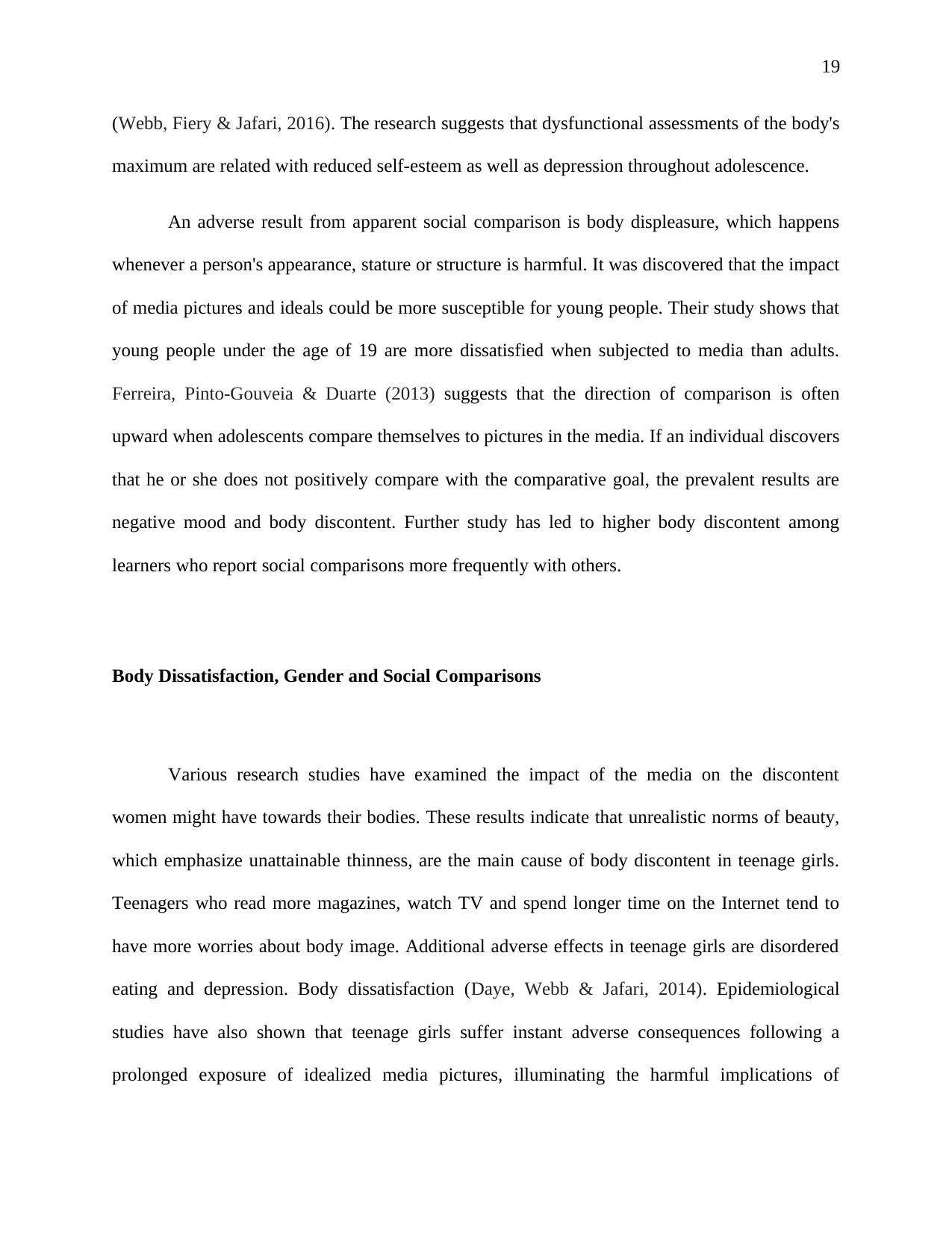
19
(Webb, Fiery & Jafari, 2016). The research suggests that dysfunctional assessments of the body's
maximum are related with reduced self-esteem as well as depression throughout adolescence.
An adverse result from apparent social comparison is body displeasure, which happens
whenever a person's appearance, stature or structure is harmful. It was discovered that the impact
of media pictures and ideals could be more susceptible for young people. Their study shows that
young people under the age of 19 are more dissatisfied when subjected to media than adults.
Ferreira, Pinto-Gouveia & Duarte (2013) suggests that the direction of comparison is often
upward when adolescents compare themselves to pictures in the media. If an individual discovers
that he or she does not positively compare with the comparative goal, the prevalent results are
negative mood and body discontent. Further study has led to higher body discontent among
learners who report social comparisons more frequently with others.
Body Dissatisfaction, Gender and Social Comparisons
Various research studies have examined the impact of the media on the discontent
women might have towards their bodies. These results indicate that unrealistic norms of beauty,
which emphasize unattainable thinness, are the main cause of body discontent in teenage girls.
Teenagers who read more magazines, watch TV and spend longer time on the Internet tend to
have more worries about body image. Additional adverse effects in teenage girls are disordered
eating and depression. Body dissatisfaction (Daye, Webb & Jafari, 2014). Epidemiological
studies have also shown that teenage girls suffer instant adverse consequences following a
prolonged exposure of idealized media pictures, illuminating the harmful implications of
(Webb, Fiery & Jafari, 2016). The research suggests that dysfunctional assessments of the body's
maximum are related with reduced self-esteem as well as depression throughout adolescence.
An adverse result from apparent social comparison is body displeasure, which happens
whenever a person's appearance, stature or structure is harmful. It was discovered that the impact
of media pictures and ideals could be more susceptible for young people. Their study shows that
young people under the age of 19 are more dissatisfied when subjected to media than adults.
Ferreira, Pinto-Gouveia & Duarte (2013) suggests that the direction of comparison is often
upward when adolescents compare themselves to pictures in the media. If an individual discovers
that he or she does not positively compare with the comparative goal, the prevalent results are
negative mood and body discontent. Further study has led to higher body discontent among
learners who report social comparisons more frequently with others.
Body Dissatisfaction, Gender and Social Comparisons
Various research studies have examined the impact of the media on the discontent
women might have towards their bodies. These results indicate that unrealistic norms of beauty,
which emphasize unattainable thinness, are the main cause of body discontent in teenage girls.
Teenagers who read more magazines, watch TV and spend longer time on the Internet tend to
have more worries about body image. Additional adverse effects in teenage girls are disordered
eating and depression. Body dissatisfaction (Daye, Webb & Jafari, 2014). Epidemiological
studies have also shown that teenage girls suffer instant adverse consequences following a
prolonged exposure of idealized media pictures, illuminating the harmful implications of
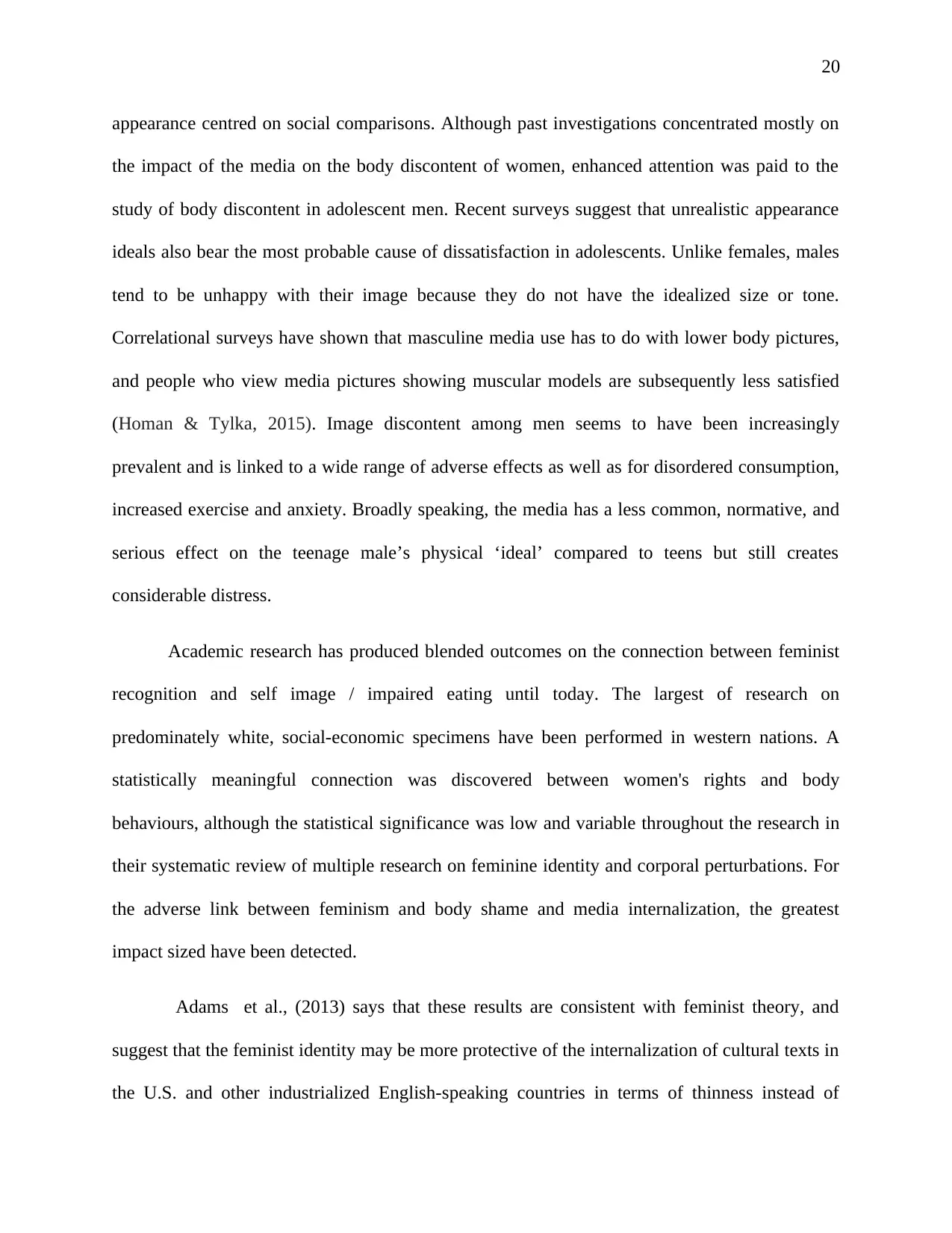
20
appearance centred on social comparisons. Although past investigations concentrated mostly on
the impact of the media on the body discontent of women, enhanced attention was paid to the
study of body discontent in adolescent men. Recent surveys suggest that unrealistic appearance
ideals also bear the most probable cause of dissatisfaction in adolescents. Unlike females, males
tend to be unhappy with their image because they do not have the idealized size or tone.
Correlational surveys have shown that masculine media use has to do with lower body pictures,
and people who view media pictures showing muscular models are subsequently less satisfied
(Homan & Tylka, 2015). Image discontent among men seems to have been increasingly
prevalent and is linked to a wide range of adverse effects as well as for disordered consumption,
increased exercise and anxiety. Broadly speaking, the media has a less common, normative, and
serious effect on the teenage male’s physical ‘ideal’ compared to teens but still creates
considerable distress.
Academic research has produced blended outcomes on the connection between feminist
recognition and self image / impaired eating until today. The largest of research on
predominately white, social-economic specimens have been performed in western nations. A
statistically meaningful connection was discovered between women's rights and body
behaviours, although the statistical significance was low and variable throughout the research in
their systematic review of multiple research on feminine identity and corporal perturbations. For
the adverse link between feminism and body shame and media internalization, the greatest
impact sized have been detected.
Adams et al., (2013) says that these results are consistent with feminist theory, and
suggest that the feminist identity may be more protective of the internalization of cultural texts in
the U.S. and other industrialized English-speaking countries in terms of thinness instead of
appearance centred on social comparisons. Although past investigations concentrated mostly on
the impact of the media on the body discontent of women, enhanced attention was paid to the
study of body discontent in adolescent men. Recent surveys suggest that unrealistic appearance
ideals also bear the most probable cause of dissatisfaction in adolescents. Unlike females, males
tend to be unhappy with their image because they do not have the idealized size or tone.
Correlational surveys have shown that masculine media use has to do with lower body pictures,
and people who view media pictures showing muscular models are subsequently less satisfied
(Homan & Tylka, 2015). Image discontent among men seems to have been increasingly
prevalent and is linked to a wide range of adverse effects as well as for disordered consumption,
increased exercise and anxiety. Broadly speaking, the media has a less common, normative, and
serious effect on the teenage male’s physical ‘ideal’ compared to teens but still creates
considerable distress.
Academic research has produced blended outcomes on the connection between feminist
recognition and self image / impaired eating until today. The largest of research on
predominately white, social-economic specimens have been performed in western nations. A
statistically meaningful connection was discovered between women's rights and body
behaviours, although the statistical significance was low and variable throughout the research in
their systematic review of multiple research on feminine identity and corporal perturbations. For
the adverse link between feminism and body shame and media internalization, the greatest
impact sized have been detected.
Adams et al., (2013) says that these results are consistent with feminist theory, and
suggest that the feminist identity may be more protective of the internalization of cultural texts in
the U.S. and other industrialized English-speaking countries in terms of thinness instead of
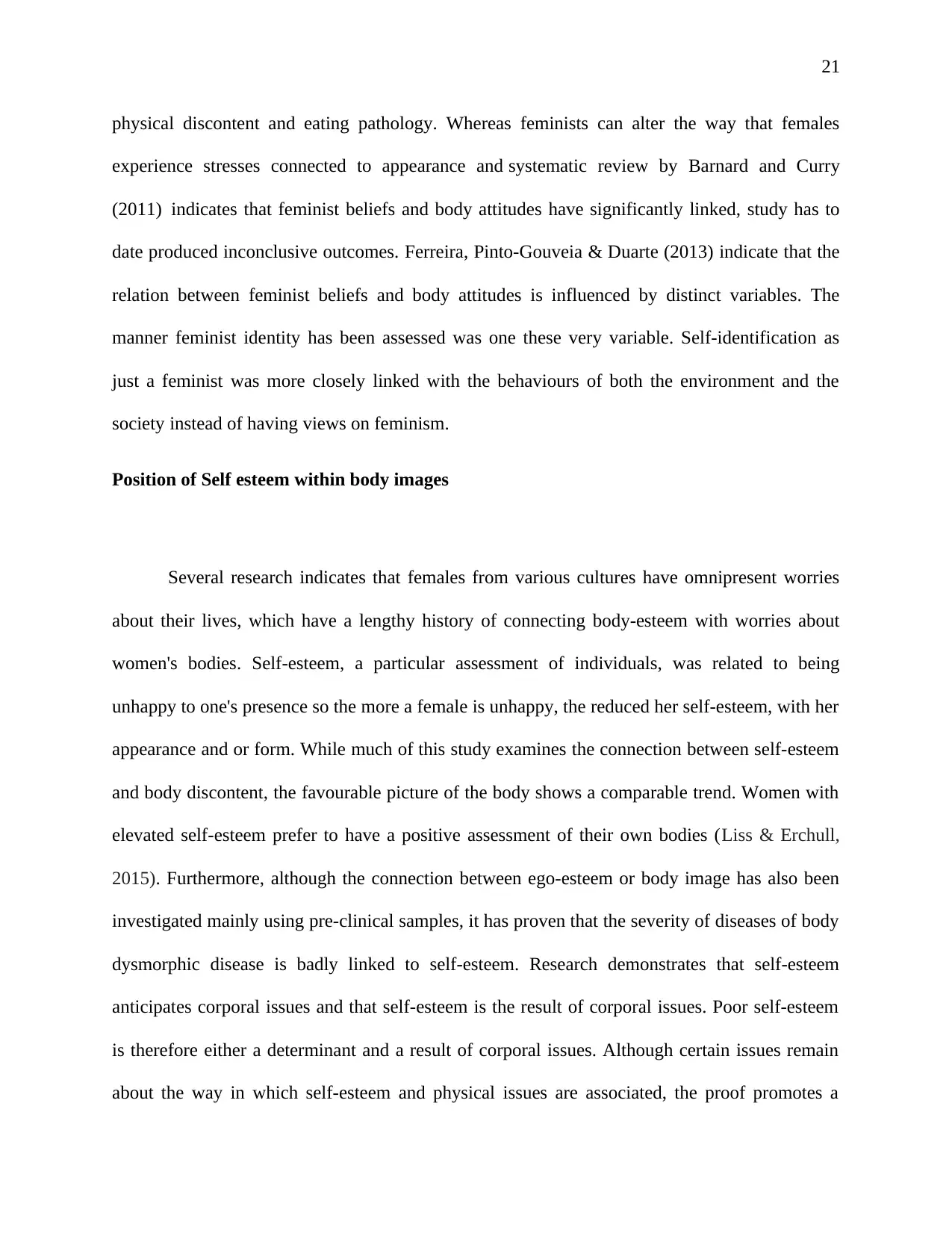
21
physical discontent and eating pathology. Whereas feminists can alter the way that females
experience stresses connected to appearance and systematic review by Barnard and Curry
(2011) indicates that feminist beliefs and body attitudes have significantly linked, study has to
date produced inconclusive outcomes. Ferreira, Pinto-Gouveia & Duarte (2013) indicate that the
relation between feminist beliefs and body attitudes is influenced by distinct variables. The
manner feminist identity has been assessed was one these very variable. Self-identification as
just a feminist was more closely linked with the behaviours of both the environment and the
society instead of having views on feminism.
Position of Self esteem within body images
Several research indicates that females from various cultures have omnipresent worries
about their lives, which have a lengthy history of connecting body-esteem with worries about
women's bodies. Self-esteem, a particular assessment of individuals, was related to being
unhappy to one's presence so the more a female is unhappy, the reduced her self-esteem, with her
appearance and or form. While much of this study examines the connection between self-esteem
and body discontent, the favourable picture of the body shows a comparable trend. Women with
elevated self-esteem prefer to have a positive assessment of their own bodies (Liss & Erchull,
2015). Furthermore, although the connection between ego-esteem or body image has also been
investigated mainly using pre-clinical samples, it has proven that the severity of diseases of body
dysmorphic disease is badly linked to self-esteem. Research demonstrates that self-esteem
anticipates corporal issues and that self-esteem is the result of corporal issues. Poor self-esteem
is therefore either a determinant and a result of corporal issues. Although certain issues remain
about the way in which self-esteem and physical issues are associated, the proof promotes a
physical discontent and eating pathology. Whereas feminists can alter the way that females
experience stresses connected to appearance and systematic review by Barnard and Curry
(2011) indicates that feminist beliefs and body attitudes have significantly linked, study has to
date produced inconclusive outcomes. Ferreira, Pinto-Gouveia & Duarte (2013) indicate that the
relation between feminist beliefs and body attitudes is influenced by distinct variables. The
manner feminist identity has been assessed was one these very variable. Self-identification as
just a feminist was more closely linked with the behaviours of both the environment and the
society instead of having views on feminism.
Position of Self esteem within body images
Several research indicates that females from various cultures have omnipresent worries
about their lives, which have a lengthy history of connecting body-esteem with worries about
women's bodies. Self-esteem, a particular assessment of individuals, was related to being
unhappy to one's presence so the more a female is unhappy, the reduced her self-esteem, with her
appearance and or form. While much of this study examines the connection between self-esteem
and body discontent, the favourable picture of the body shows a comparable trend. Women with
elevated self-esteem prefer to have a positive assessment of their own bodies (Liss & Erchull,
2015). Furthermore, although the connection between ego-esteem or body image has also been
investigated mainly using pre-clinical samples, it has proven that the severity of diseases of body
dysmorphic disease is badly linked to self-esteem. Research demonstrates that self-esteem
anticipates corporal issues and that self-esteem is the result of corporal issues. Poor self-esteem
is therefore either a determinant and a result of corporal issues. Although certain issues remain
about the way in which self-esteem and physical issues are associated, the proof promotes a
Secure Best Marks with AI Grader
Need help grading? Try our AI Grader for instant feedback on your assignments.
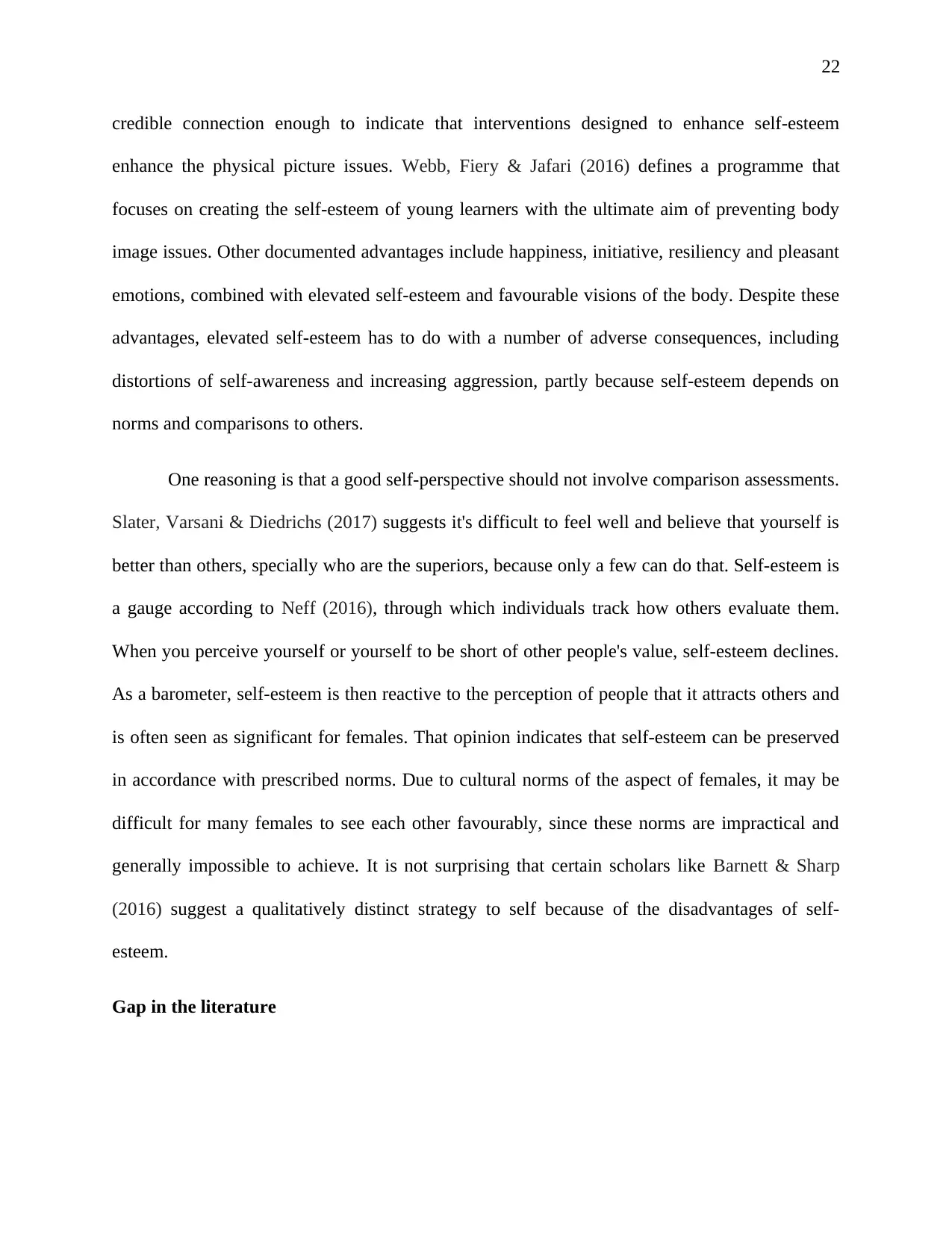
22
credible connection enough to indicate that interventions designed to enhance self-esteem
enhance the physical picture issues. Webb, Fiery & Jafari (2016) defines a programme that
focuses on creating the self-esteem of young learners with the ultimate aim of preventing body
image issues. Other documented advantages include happiness, initiative, resiliency and pleasant
emotions, combined with elevated self-esteem and favourable visions of the body. Despite these
advantages, elevated self-esteem has to do with a number of adverse consequences, including
distortions of self-awareness and increasing aggression, partly because self-esteem depends on
norms and comparisons to others.
One reasoning is that a good self-perspective should not involve comparison assessments.
Slater, Varsani & Diedrichs (2017) suggests it's difficult to feel well and believe that yourself is
better than others, specially who are the superiors, because only a few can do that. Self-esteem is
a gauge according to Neff (2016), through which individuals track how others evaluate them.
When you perceive yourself or yourself to be short of other people's value, self-esteem declines.
As a barometer, self-esteem is then reactive to the perception of people that it attracts others and
is often seen as significant for females. That opinion indicates that self-esteem can be preserved
in accordance with prescribed norms. Due to cultural norms of the aspect of females, it may be
difficult for many females to see each other favourably, since these norms are impractical and
generally impossible to achieve. It is not surprising that certain scholars like Barnett & Sharp
(2016) suggest a qualitatively distinct strategy to self because of the disadvantages of self-
esteem.
Gap in the literature
credible connection enough to indicate that interventions designed to enhance self-esteem
enhance the physical picture issues. Webb, Fiery & Jafari (2016) defines a programme that
focuses on creating the self-esteem of young learners with the ultimate aim of preventing body
image issues. Other documented advantages include happiness, initiative, resiliency and pleasant
emotions, combined with elevated self-esteem and favourable visions of the body. Despite these
advantages, elevated self-esteem has to do with a number of adverse consequences, including
distortions of self-awareness and increasing aggression, partly because self-esteem depends on
norms and comparisons to others.
One reasoning is that a good self-perspective should not involve comparison assessments.
Slater, Varsani & Diedrichs (2017) suggests it's difficult to feel well and believe that yourself is
better than others, specially who are the superiors, because only a few can do that. Self-esteem is
a gauge according to Neff (2016), through which individuals track how others evaluate them.
When you perceive yourself or yourself to be short of other people's value, self-esteem declines.
As a barometer, self-esteem is then reactive to the perception of people that it attracts others and
is often seen as significant for females. That opinion indicates that self-esteem can be preserved
in accordance with prescribed norms. Due to cultural norms of the aspect of females, it may be
difficult for many females to see each other favourably, since these norms are impractical and
generally impossible to achieve. It is not surprising that certain scholars like Barnett & Sharp
(2016) suggest a qualitatively distinct strategy to self because of the disadvantages of self-
esteem.
Gap in the literature
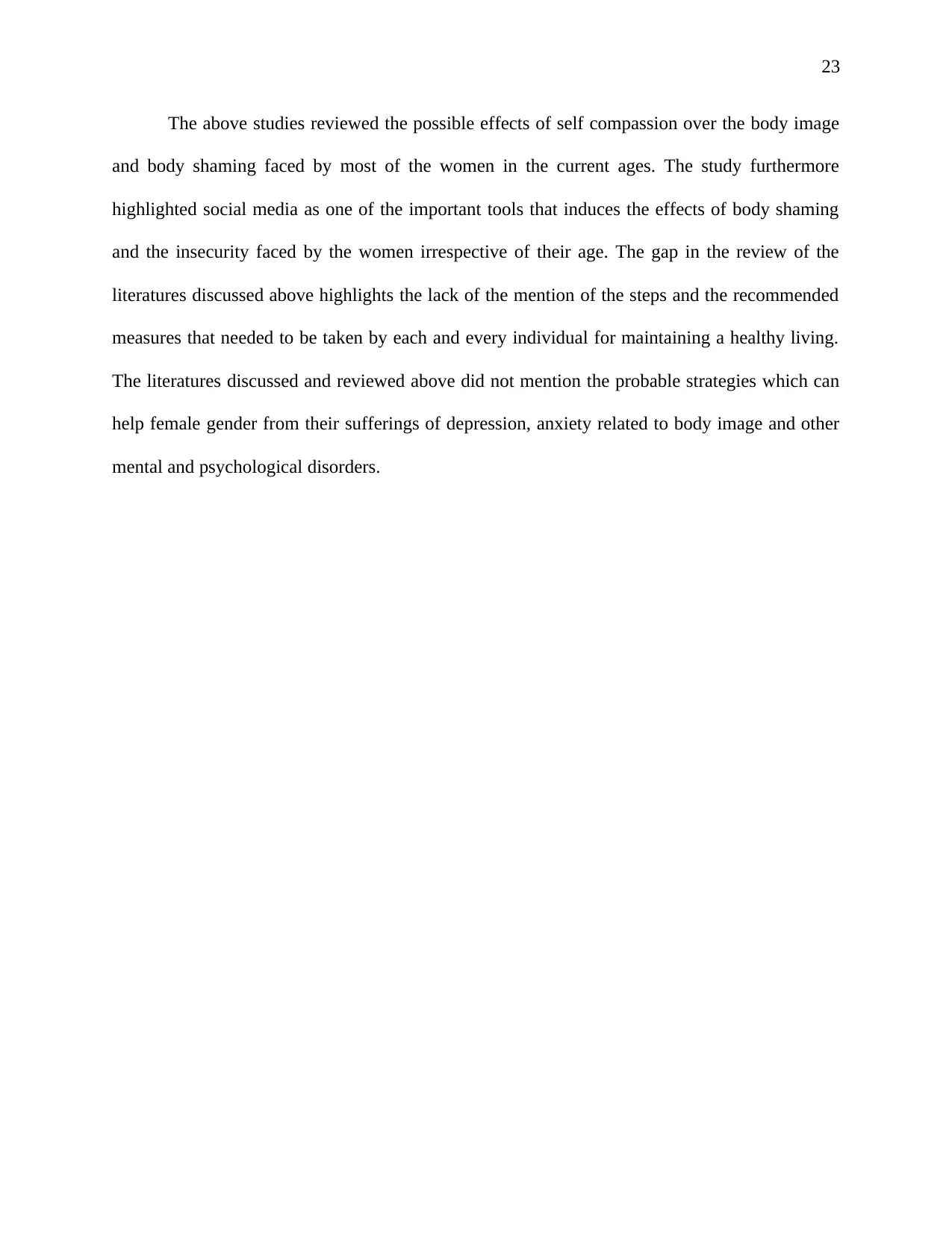
23
The above studies reviewed the possible effects of self compassion over the body image
and body shaming faced by most of the women in the current ages. The study furthermore
highlighted social media as one of the important tools that induces the effects of body shaming
and the insecurity faced by the women irrespective of their age. The gap in the review of the
literatures discussed above highlights the lack of the mention of the steps and the recommended
measures that needed to be taken by each and every individual for maintaining a healthy living.
The literatures discussed and reviewed above did not mention the probable strategies which can
help female gender from their sufferings of depression, anxiety related to body image and other
mental and psychological disorders.
The above studies reviewed the possible effects of self compassion over the body image
and body shaming faced by most of the women in the current ages. The study furthermore
highlighted social media as one of the important tools that induces the effects of body shaming
and the insecurity faced by the women irrespective of their age. The gap in the review of the
literatures discussed above highlights the lack of the mention of the steps and the recommended
measures that needed to be taken by each and every individual for maintaining a healthy living.
The literatures discussed and reviewed above did not mention the probable strategies which can
help female gender from their sufferings of depression, anxiety related to body image and other
mental and psychological disorders.
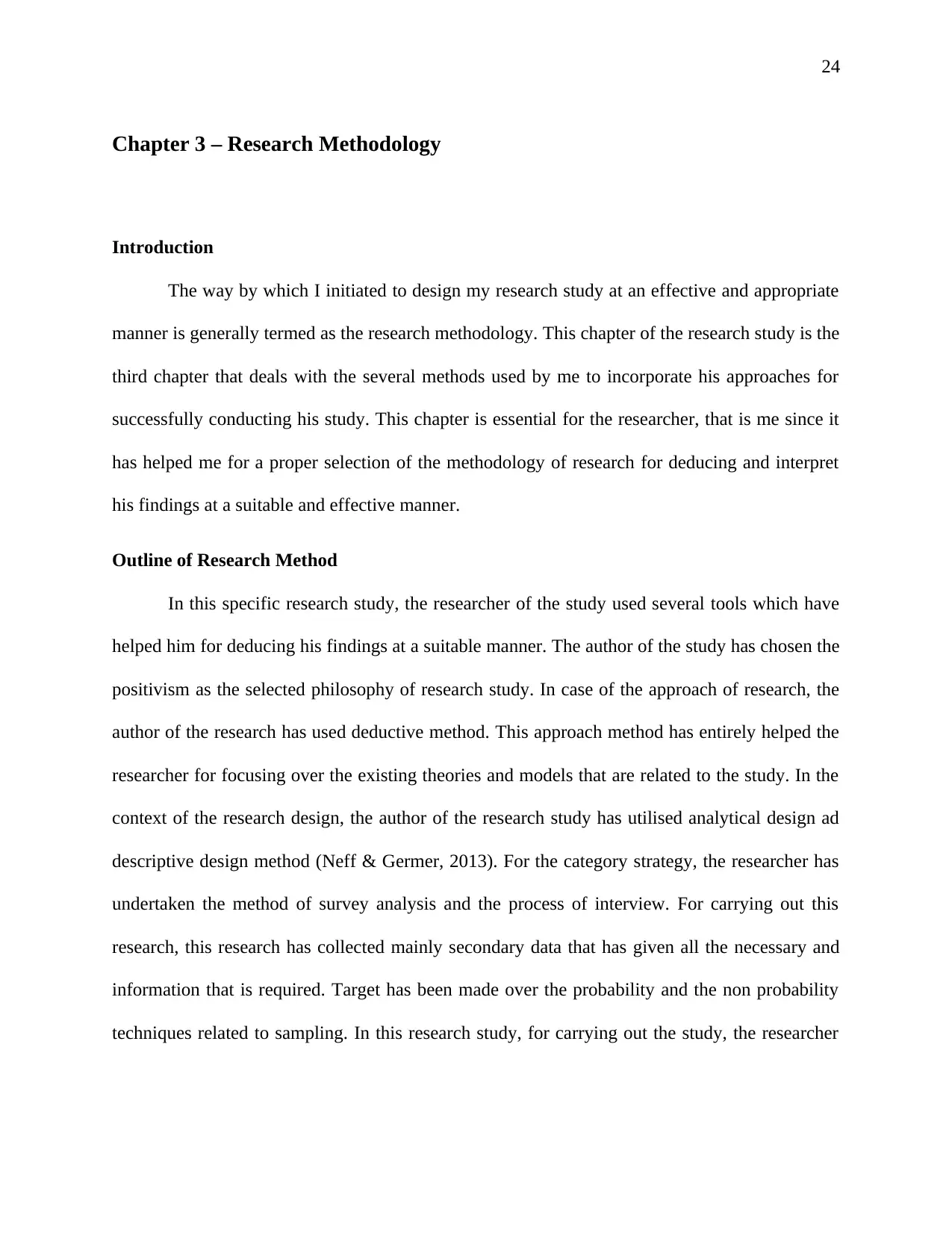
24
Chapter 3 – Research Methodology
Introduction
The way by which I initiated to design my research study at an effective and appropriate
manner is generally termed as the research methodology. This chapter of the research study is the
third chapter that deals with the several methods used by me to incorporate his approaches for
successfully conducting his study. This chapter is essential for the researcher, that is me since it
has helped me for a proper selection of the methodology of research for deducing and interpret
his findings at a suitable and effective manner.
Outline of Research Method
In this specific research study, the researcher of the study used several tools which have
helped him for deducing his findings at a suitable manner. The author of the study has chosen the
positivism as the selected philosophy of research study. In case of the approach of research, the
author of the research has used deductive method. This approach method has entirely helped the
researcher for focusing over the existing theories and models that are related to the study. In the
context of the research design, the author of the research study has utilised analytical design ad
descriptive design method (Neff & Germer, 2013). For the category strategy, the researcher has
undertaken the method of survey analysis and the process of interview. For carrying out this
research, this research has collected mainly secondary data that has given all the necessary and
information that is required. Target has been made over the probability and the non probability
techniques related to sampling. In this research study, for carrying out the study, the researcher
Chapter 3 – Research Methodology
Introduction
The way by which I initiated to design my research study at an effective and appropriate
manner is generally termed as the research methodology. This chapter of the research study is the
third chapter that deals with the several methods used by me to incorporate his approaches for
successfully conducting his study. This chapter is essential for the researcher, that is me since it
has helped me for a proper selection of the methodology of research for deducing and interpret
his findings at a suitable and effective manner.
Outline of Research Method
In this specific research study, the researcher of the study used several tools which have
helped him for deducing his findings at a suitable manner. The author of the study has chosen the
positivism as the selected philosophy of research study. In case of the approach of research, the
author of the research has used deductive method. This approach method has entirely helped the
researcher for focusing over the existing theories and models that are related to the study. In the
context of the research design, the author of the research study has utilised analytical design ad
descriptive design method (Neff & Germer, 2013). For the category strategy, the researcher has
undertaken the method of survey analysis and the process of interview. For carrying out this
research, this research has collected mainly secondary data that has given all the necessary and
information that is required. Target has been made over the probability and the non probability
techniques related to sampling. In this research study, for carrying out the study, the researcher
Paraphrase This Document
Need a fresh take? Get an instant paraphrase of this document with our AI Paraphraser
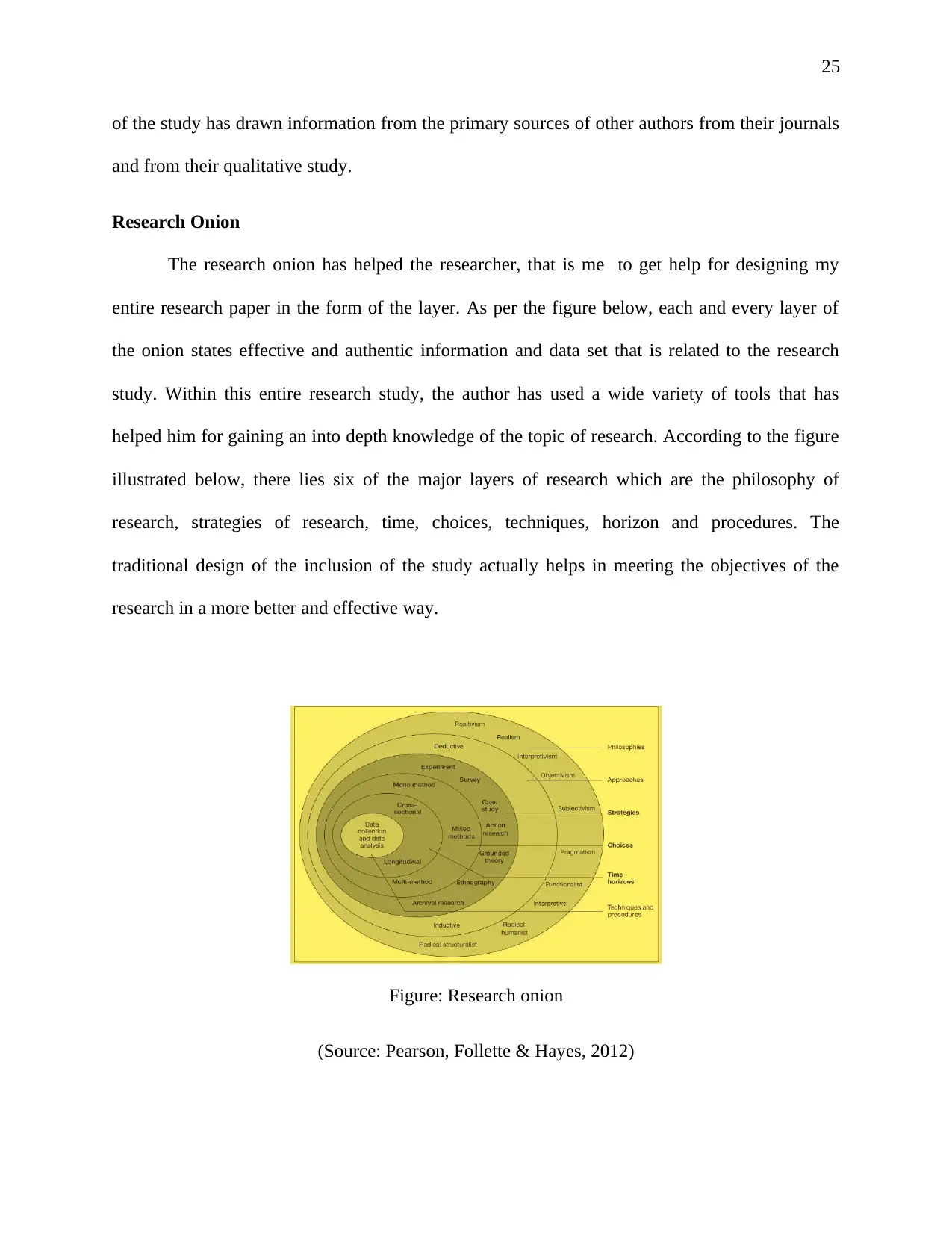
25
of the study has drawn information from the primary sources of other authors from their journals
and from their qualitative study.
Research Onion
The research onion has helped the researcher, that is me to get help for designing my
entire research paper in the form of the layer. As per the figure below, each and every layer of
the onion states effective and authentic information and data set that is related to the research
study. Within this entire research study, the author has used a wide variety of tools that has
helped him for gaining an into depth knowledge of the topic of research. According to the figure
illustrated below, there lies six of the major layers of research which are the philosophy of
research, strategies of research, time, choices, techniques, horizon and procedures. The
traditional design of the inclusion of the study actually helps in meeting the objectives of the
research in a more better and effective way.
Figure: Research onion
(Source: Pearson, Follette & Hayes, 2012)
of the study has drawn information from the primary sources of other authors from their journals
and from their qualitative study.
Research Onion
The research onion has helped the researcher, that is me to get help for designing my
entire research paper in the form of the layer. As per the figure below, each and every layer of
the onion states effective and authentic information and data set that is related to the research
study. Within this entire research study, the author has used a wide variety of tools that has
helped him for gaining an into depth knowledge of the topic of research. According to the figure
illustrated below, there lies six of the major layers of research which are the philosophy of
research, strategies of research, time, choices, techniques, horizon and procedures. The
traditional design of the inclusion of the study actually helps in meeting the objectives of the
research in a more better and effective way.
Figure: Research onion
(Source: Pearson, Follette & Hayes, 2012)
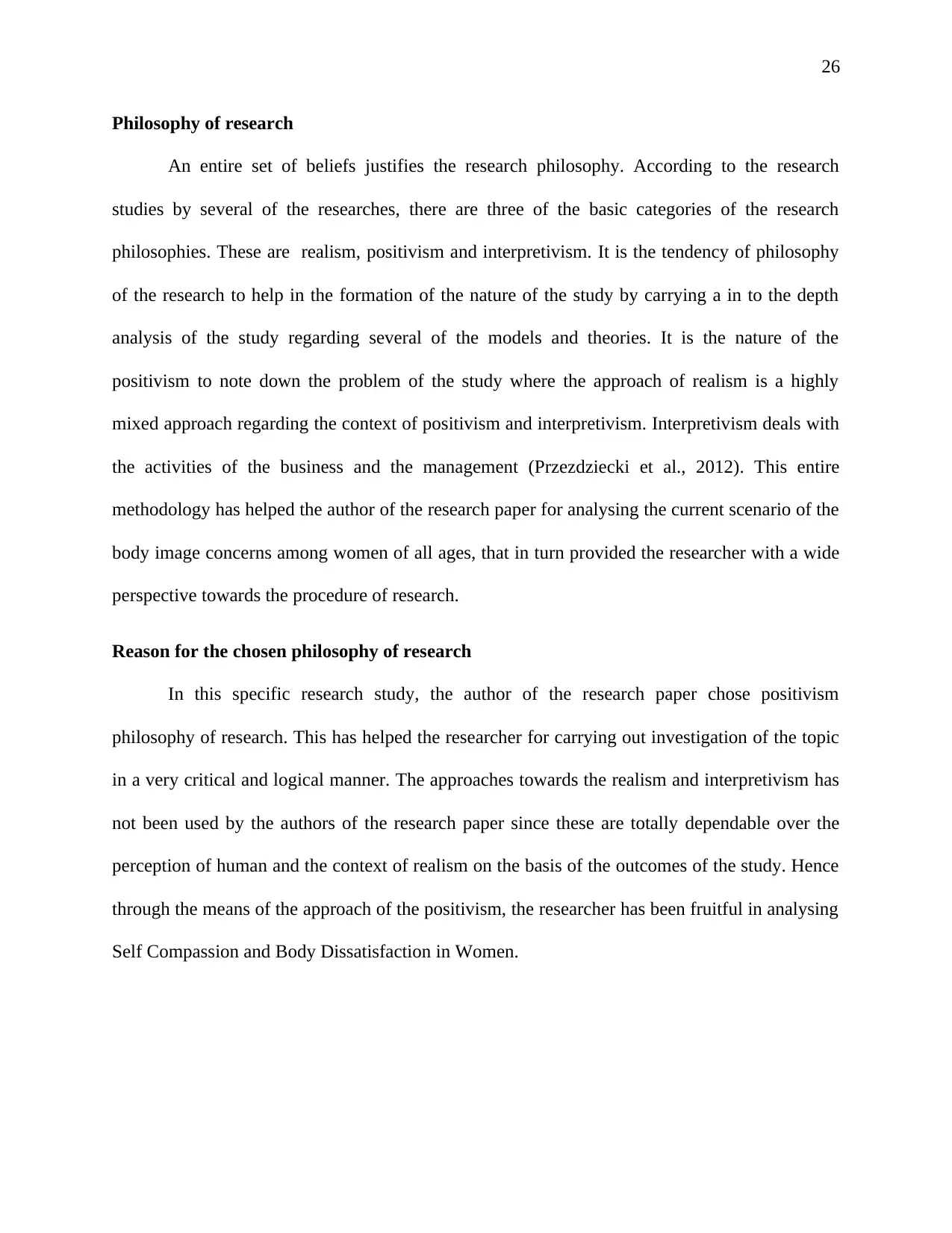
26
Philosophy of research
An entire set of beliefs justifies the research philosophy. According to the research
studies by several of the researches, there are three of the basic categories of the research
philosophies. These are realism, positivism and interpretivism. It is the tendency of philosophy
of the research to help in the formation of the nature of the study by carrying a in to the depth
analysis of the study regarding several of the models and theories. It is the nature of the
positivism to note down the problem of the study where the approach of realism is a highly
mixed approach regarding the context of positivism and interpretivism. Interpretivism deals with
the activities of the business and the management (Przezdziecki et al., 2012). This entire
methodology has helped the author of the research paper for analysing the current scenario of the
body image concerns among women of all ages, that in turn provided the researcher with a wide
perspective towards the procedure of research.
Reason for the chosen philosophy of research
In this specific research study, the author of the research paper chose positivism
philosophy of research. This has helped the researcher for carrying out investigation of the topic
in a very critical and logical manner. The approaches towards the realism and interpretivism has
not been used by the authors of the research paper since these are totally dependable over the
perception of human and the context of realism on the basis of the outcomes of the study. Hence
through the means of the approach of the positivism, the researcher has been fruitful in analysing
Self Compassion and Body Dissatisfaction in Women.
Philosophy of research
An entire set of beliefs justifies the research philosophy. According to the research
studies by several of the researches, there are three of the basic categories of the research
philosophies. These are realism, positivism and interpretivism. It is the tendency of philosophy
of the research to help in the formation of the nature of the study by carrying a in to the depth
analysis of the study regarding several of the models and theories. It is the nature of the
positivism to note down the problem of the study where the approach of realism is a highly
mixed approach regarding the context of positivism and interpretivism. Interpretivism deals with
the activities of the business and the management (Przezdziecki et al., 2012). This entire
methodology has helped the author of the research paper for analysing the current scenario of the
body image concerns among women of all ages, that in turn provided the researcher with a wide
perspective towards the procedure of research.
Reason for the chosen philosophy of research
In this specific research study, the author of the research paper chose positivism
philosophy of research. This has helped the researcher for carrying out investigation of the topic
in a very critical and logical manner. The approaches towards the realism and interpretivism has
not been used by the authors of the research paper since these are totally dependable over the
perception of human and the context of realism on the basis of the outcomes of the study. Hence
through the means of the approach of the positivism, the researcher has been fruitful in analysing
Self Compassion and Body Dissatisfaction in Women.
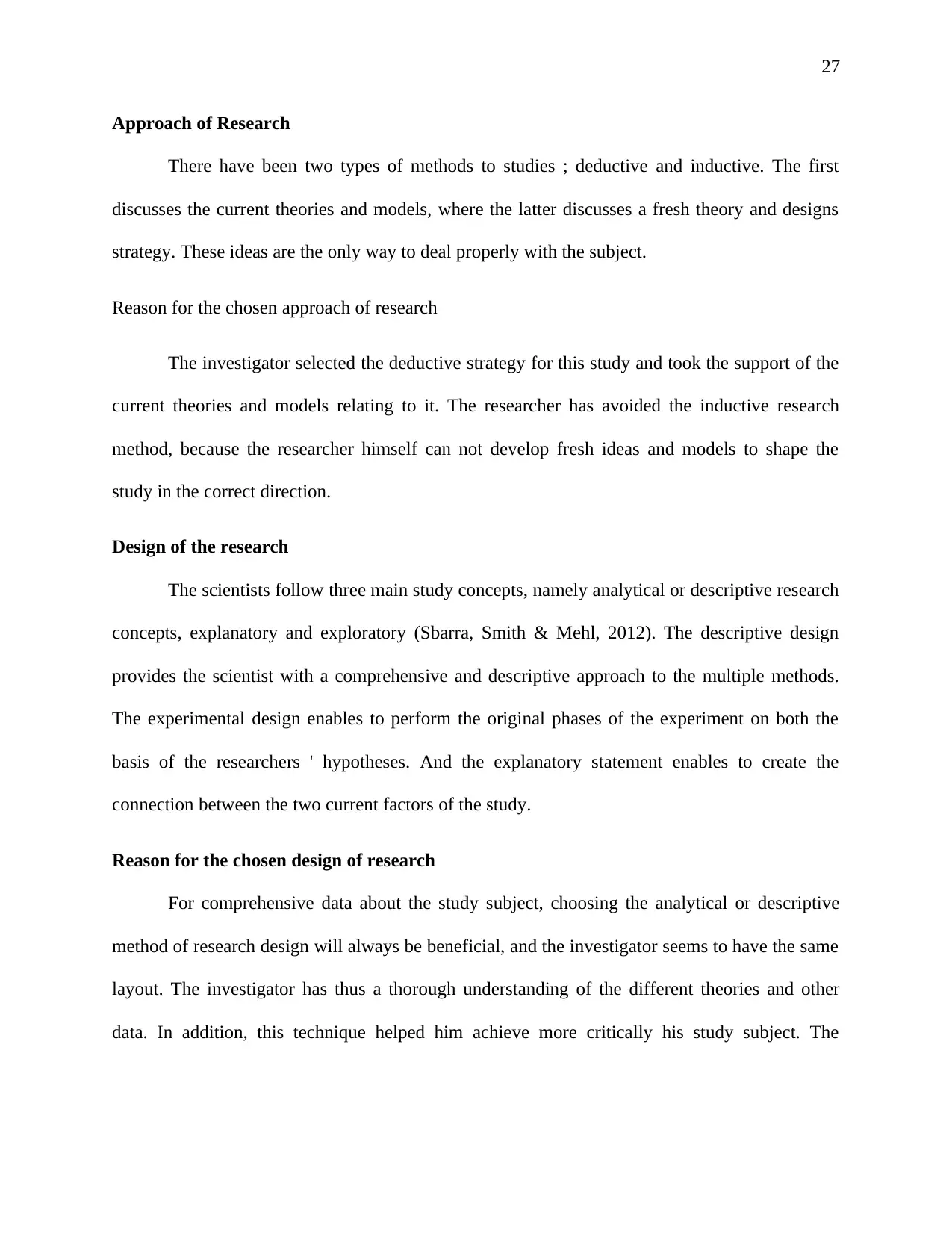
27
Approach of Research
There have been two types of methods to studies ; deductive and inductive. The first
discusses the current theories and models, where the latter discusses a fresh theory and designs
strategy. These ideas are the only way to deal properly with the subject.
Reason for the chosen approach of research
The investigator selected the deductive strategy for this study and took the support of the
current theories and models relating to it. The researcher has avoided the inductive research
method, because the researcher himself can not develop fresh ideas and models to shape the
study in the correct direction.
Design of the research
The scientists follow three main study concepts, namely analytical or descriptive research
concepts, explanatory and exploratory (Sbarra, Smith & Mehl, 2012). The descriptive design
provides the scientist with a comprehensive and descriptive approach to the multiple methods.
The experimental design enables to perform the original phases of the experiment on both the
basis of the researchers ' hypotheses. And the explanatory statement enables to create the
connection between the two current factors of the study.
Reason for the chosen design of research
For comprehensive data about the study subject, choosing the analytical or descriptive
method of research design will always be beneficial, and the investigator seems to have the same
layout. The investigator has thus a thorough understanding of the different theories and other
data. In addition, this technique helped him achieve more critically his study subject. The
Approach of Research
There have been two types of methods to studies ; deductive and inductive. The first
discusses the current theories and models, where the latter discusses a fresh theory and designs
strategy. These ideas are the only way to deal properly with the subject.
Reason for the chosen approach of research
The investigator selected the deductive strategy for this study and took the support of the
current theories and models relating to it. The researcher has avoided the inductive research
method, because the researcher himself can not develop fresh ideas and models to shape the
study in the correct direction.
Design of the research
The scientists follow three main study concepts, namely analytical or descriptive research
concepts, explanatory and exploratory (Sbarra, Smith & Mehl, 2012). The descriptive design
provides the scientist with a comprehensive and descriptive approach to the multiple methods.
The experimental design enables to perform the original phases of the experiment on both the
basis of the researchers ' hypotheses. And the explanatory statement enables to create the
connection between the two current factors of the study.
Reason for the chosen design of research
For comprehensive data about the study subject, choosing the analytical or descriptive
method of research design will always be beneficial, and the investigator seems to have the same
layout. The investigator has thus a thorough understanding of the different theories and other
data. In addition, this technique helped him achieve more critically his study subject. The
Secure Best Marks with AI Grader
Need help grading? Try our AI Grader for instant feedback on your assignments.
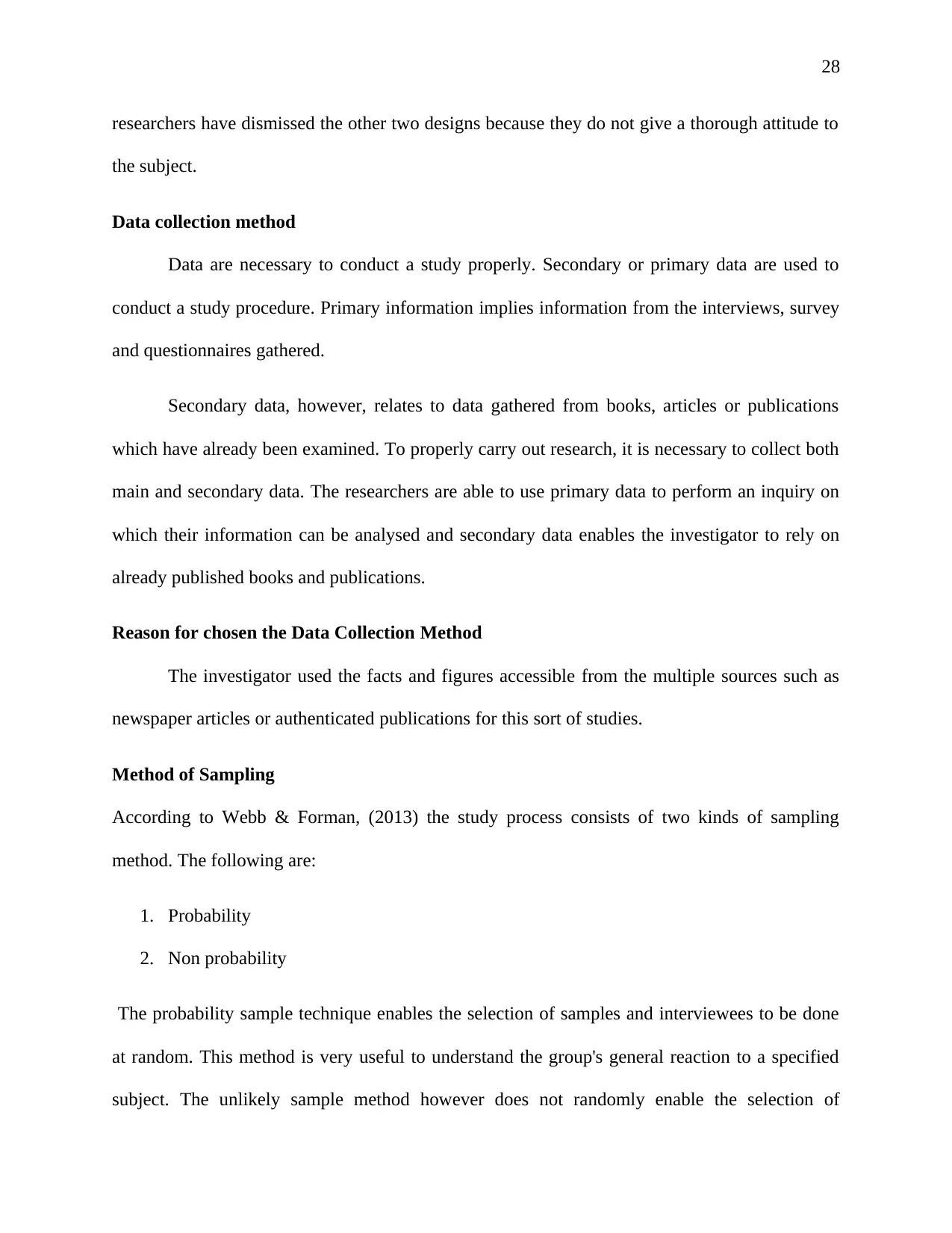
28
researchers have dismissed the other two designs because they do not give a thorough attitude to
the subject.
Data collection method
Data are necessary to conduct a study properly. Secondary or primary data are used to
conduct a study procedure. Primary information implies information from the interviews, survey
and questionnaires gathered.
Secondary data, however, relates to data gathered from books, articles or publications
which have already been examined. To properly carry out research, it is necessary to collect both
main and secondary data. The researchers are able to use primary data to perform an inquiry on
which their information can be analysed and secondary data enables the investigator to rely on
already published books and publications.
Reason for chosen the Data Collection Method
The investigator used the facts and figures accessible from the multiple sources such as
newspaper articles or authenticated publications for this sort of studies.
Method of Sampling
According to Webb & Forman, (2013) the study process consists of two kinds of sampling
method. The following are:
1. Probability
2. Non probability
The probability sample technique enables the selection of samples and interviewees to be done
at random. This method is very useful to understand the group's general reaction to a specified
subject. The unlikely sample method however does not randomly enable the selection of
researchers have dismissed the other two designs because they do not give a thorough attitude to
the subject.
Data collection method
Data are necessary to conduct a study properly. Secondary or primary data are used to
conduct a study procedure. Primary information implies information from the interviews, survey
and questionnaires gathered.
Secondary data, however, relates to data gathered from books, articles or publications
which have already been examined. To properly carry out research, it is necessary to collect both
main and secondary data. The researchers are able to use primary data to perform an inquiry on
which their information can be analysed and secondary data enables the investigator to rely on
already published books and publications.
Reason for chosen the Data Collection Method
The investigator used the facts and figures accessible from the multiple sources such as
newspaper articles or authenticated publications for this sort of studies.
Method of Sampling
According to Webb & Forman, (2013) the study process consists of two kinds of sampling
method. The following are:
1. Probability
2. Non probability
The probability sample technique enables the selection of samples and interviewees to be done
at random. This method is very useful to understand the group's general reaction to a specified
subject. The unlikely sample method however does not randomly enable the selection of
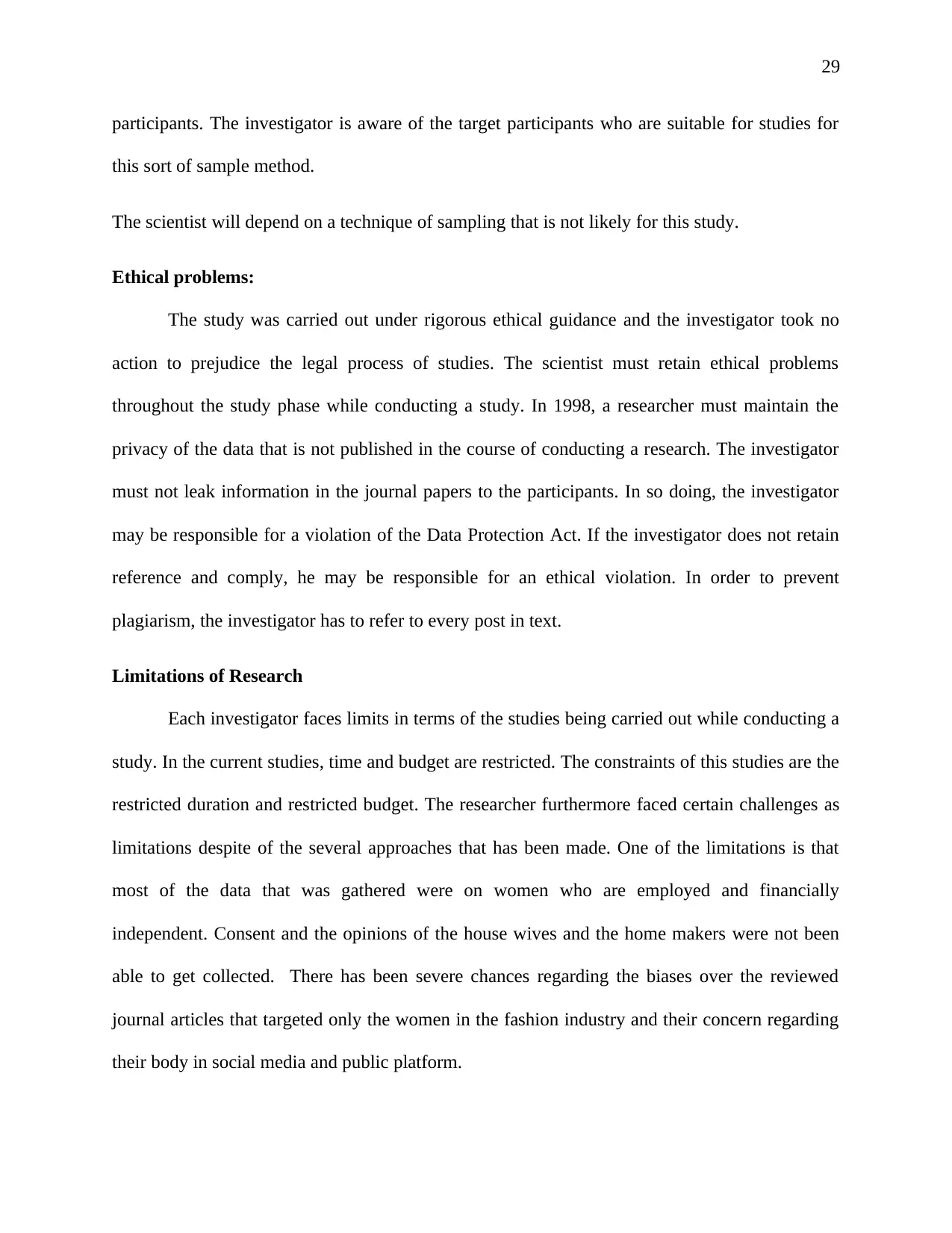
29
participants. The investigator is aware of the target participants who are suitable for studies for
this sort of sample method.
The scientist will depend on a technique of sampling that is not likely for this study.
Ethical problems:
The study was carried out under rigorous ethical guidance and the investigator took no
action to prejudice the legal process of studies. The scientist must retain ethical problems
throughout the study phase while conducting a study. In 1998, a researcher must maintain the
privacy of the data that is not published in the course of conducting a research. The investigator
must not leak information in the journal papers to the participants. In so doing, the investigator
may be responsible for a violation of the Data Protection Act. If the investigator does not retain
reference and comply, he may be responsible for an ethical violation. In order to prevent
plagiarism, the investigator has to refer to every post in text.
Limitations of Research
Each investigator faces limits in terms of the studies being carried out while conducting a
study. In the current studies, time and budget are restricted. The constraints of this studies are the
restricted duration and restricted budget. The researcher furthermore faced certain challenges as
limitations despite of the several approaches that has been made. One of the limitations is that
most of the data that was gathered were on women who are employed and financially
independent. Consent and the opinions of the house wives and the home makers were not been
able to get collected. There has been severe chances regarding the biases over the reviewed
journal articles that targeted only the women in the fashion industry and their concern regarding
their body in social media and public platform.
participants. The investigator is aware of the target participants who are suitable for studies for
this sort of sample method.
The scientist will depend on a technique of sampling that is not likely for this study.
Ethical problems:
The study was carried out under rigorous ethical guidance and the investigator took no
action to prejudice the legal process of studies. The scientist must retain ethical problems
throughout the study phase while conducting a study. In 1998, a researcher must maintain the
privacy of the data that is not published in the course of conducting a research. The investigator
must not leak information in the journal papers to the participants. In so doing, the investigator
may be responsible for a violation of the Data Protection Act. If the investigator does not retain
reference and comply, he may be responsible for an ethical violation. In order to prevent
plagiarism, the investigator has to refer to every post in text.
Limitations of Research
Each investigator faces limits in terms of the studies being carried out while conducting a
study. In the current studies, time and budget are restricted. The constraints of this studies are the
restricted duration and restricted budget. The researcher furthermore faced certain challenges as
limitations despite of the several approaches that has been made. One of the limitations is that
most of the data that was gathered were on women who are employed and financially
independent. Consent and the opinions of the house wives and the home makers were not been
able to get collected. There has been severe chances regarding the biases over the reviewed
journal articles that targeted only the women in the fashion industry and their concern regarding
their body in social media and public platform.
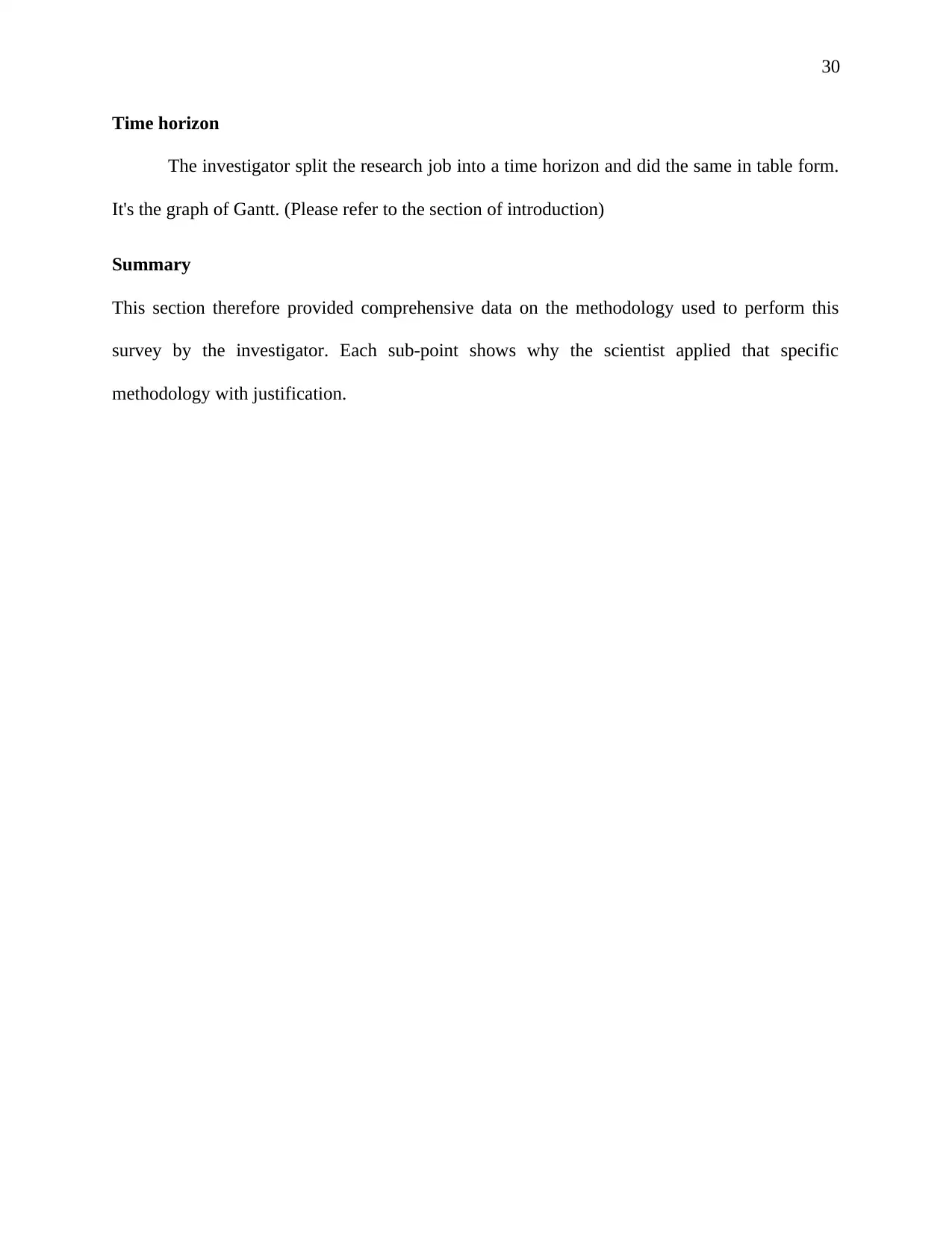
30
Time horizon
The investigator split the research job into a time horizon and did the same in table form.
It's the graph of Gantt. (Please refer to the section of introduction)
Summary
This section therefore provided comprehensive data on the methodology used to perform this
survey by the investigator. Each sub-point shows why the scientist applied that specific
methodology with justification.
Time horizon
The investigator split the research job into a time horizon and did the same in table form.
It's the graph of Gantt. (Please refer to the section of introduction)
Summary
This section therefore provided comprehensive data on the methodology used to perform this
survey by the investigator. Each sub-point shows why the scientist applied that specific
methodology with justification.
Paraphrase This Document
Need a fresh take? Get an instant paraphrase of this document with our AI Paraphraser
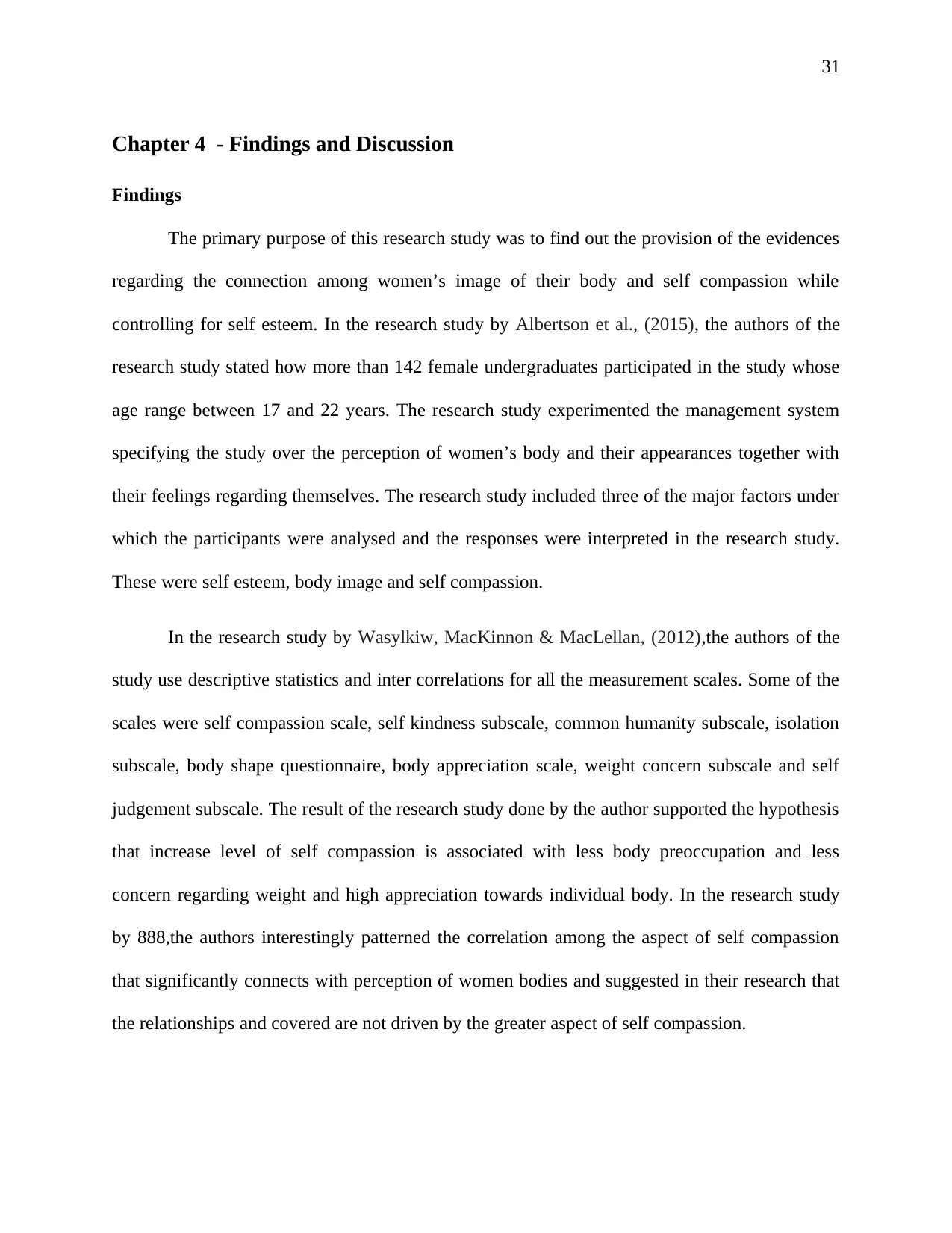
31
Chapter 4 - Findings and Discussion
Findings
The primary purpose of this research study was to find out the provision of the evidences
regarding the connection among women’s image of their body and self compassion while
controlling for self esteem. In the research study by Albertson et al., (2015), the authors of the
research study stated how more than 142 female undergraduates participated in the study whose
age range between 17 and 22 years. The research study experimented the management system
specifying the study over the perception of women’s body and their appearances together with
their feelings regarding themselves. The research study included three of the major factors under
which the participants were analysed and the responses were interpreted in the research study.
These were self esteem, body image and self compassion.
In the research study by Wasylkiw, MacKinnon & MacLellan, (2012),the authors of the
study use descriptive statistics and inter correlations for all the measurement scales. Some of the
scales were self compassion scale, self kindness subscale, common humanity subscale, isolation
subscale, body shape questionnaire, body appreciation scale, weight concern subscale and self
judgement subscale. The result of the research study done by the author supported the hypothesis
that increase level of self compassion is associated with less body preoccupation and less
concern regarding weight and high appreciation towards individual body. In the research study
by 888,the authors interestingly patterned the correlation among the aspect of self compassion
that significantly connects with perception of women bodies and suggested in their research that
the relationships and covered are not driven by the greater aspect of self compassion.
Chapter 4 - Findings and Discussion
Findings
The primary purpose of this research study was to find out the provision of the evidences
regarding the connection among women’s image of their body and self compassion while
controlling for self esteem. In the research study by Albertson et al., (2015), the authors of the
research study stated how more than 142 female undergraduates participated in the study whose
age range between 17 and 22 years. The research study experimented the management system
specifying the study over the perception of women’s body and their appearances together with
their feelings regarding themselves. The research study included three of the major factors under
which the participants were analysed and the responses were interpreted in the research study.
These were self esteem, body image and self compassion.
In the research study by Wasylkiw, MacKinnon & MacLellan, (2012),the authors of the
study use descriptive statistics and inter correlations for all the measurement scales. Some of the
scales were self compassion scale, self kindness subscale, common humanity subscale, isolation
subscale, body shape questionnaire, body appreciation scale, weight concern subscale and self
judgement subscale. The result of the research study done by the author supported the hypothesis
that increase level of self compassion is associated with less body preoccupation and less
concern regarding weight and high appreciation towards individual body. In the research study
by 888,the authors interestingly patterned the correlation among the aspect of self compassion
that significantly connects with perception of women bodies and suggested in their research that
the relationships and covered are not driven by the greater aspect of self compassion.
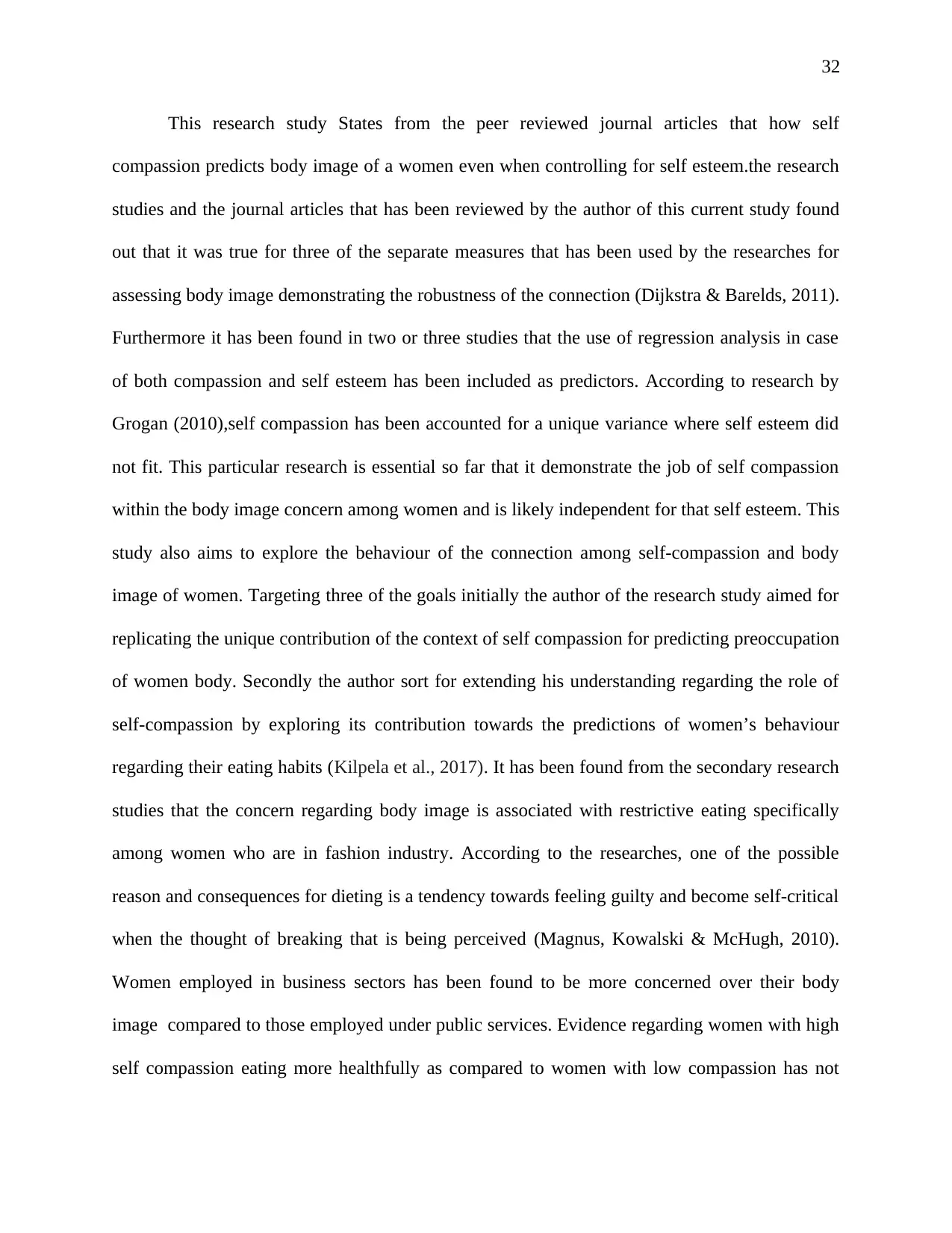
32
This research study States from the peer reviewed journal articles that how self
compassion predicts body image of a women even when controlling for self esteem.the research
studies and the journal articles that has been reviewed by the author of this current study found
out that it was true for three of the separate measures that has been used by the researches for
assessing body image demonstrating the robustness of the connection (Dijkstra & Barelds, 2011).
Furthermore it has been found in two or three studies that the use of regression analysis in case
of both compassion and self esteem has been included as predictors. According to research by
Grogan (2010),self compassion has been accounted for a unique variance where self esteem did
not fit. This particular research is essential so far that it demonstrate the job of self compassion
within the body image concern among women and is likely independent for that self esteem. This
study also aims to explore the behaviour of the connection among self-compassion and body
image of women. Targeting three of the goals initially the author of the research study aimed for
replicating the unique contribution of the context of self compassion for predicting preoccupation
of women body. Secondly the author sort for extending his understanding regarding the role of
self-compassion by exploring its contribution towards the predictions of women’s behaviour
regarding their eating habits (Kilpela et al., 2017). It has been found from the secondary research
studies that the concern regarding body image is associated with restrictive eating specifically
among women who are in fashion industry. According to the researches, one of the possible
reason and consequences for dieting is a tendency towards feeling guilty and become self-critical
when the thought of breaking that is being perceived (Magnus, Kowalski & McHugh, 2010).
Women employed in business sectors has been found to be more concerned over their body
image compared to those employed under public services. Evidence regarding women with high
self compassion eating more healthfully as compared to women with low compassion has not
This research study States from the peer reviewed journal articles that how self
compassion predicts body image of a women even when controlling for self esteem.the research
studies and the journal articles that has been reviewed by the author of this current study found
out that it was true for three of the separate measures that has been used by the researches for
assessing body image demonstrating the robustness of the connection (Dijkstra & Barelds, 2011).
Furthermore it has been found in two or three studies that the use of regression analysis in case
of both compassion and self esteem has been included as predictors. According to research by
Grogan (2010),self compassion has been accounted for a unique variance where self esteem did
not fit. This particular research is essential so far that it demonstrate the job of self compassion
within the body image concern among women and is likely independent for that self esteem. This
study also aims to explore the behaviour of the connection among self-compassion and body
image of women. Targeting three of the goals initially the author of the research study aimed for
replicating the unique contribution of the context of self compassion for predicting preoccupation
of women body. Secondly the author sort for extending his understanding regarding the role of
self-compassion by exploring its contribution towards the predictions of women’s behaviour
regarding their eating habits (Kilpela et al., 2017). It has been found from the secondary research
studies that the concern regarding body image is associated with restrictive eating specifically
among women who are in fashion industry. According to the researches, one of the possible
reason and consequences for dieting is a tendency towards feeling guilty and become self-critical
when the thought of breaking that is being perceived (Magnus, Kowalski & McHugh, 2010).
Women employed in business sectors has been found to be more concerned over their body
image compared to those employed under public services. Evidence regarding women with high
self compassion eating more healthfully as compared to women with low compassion has not
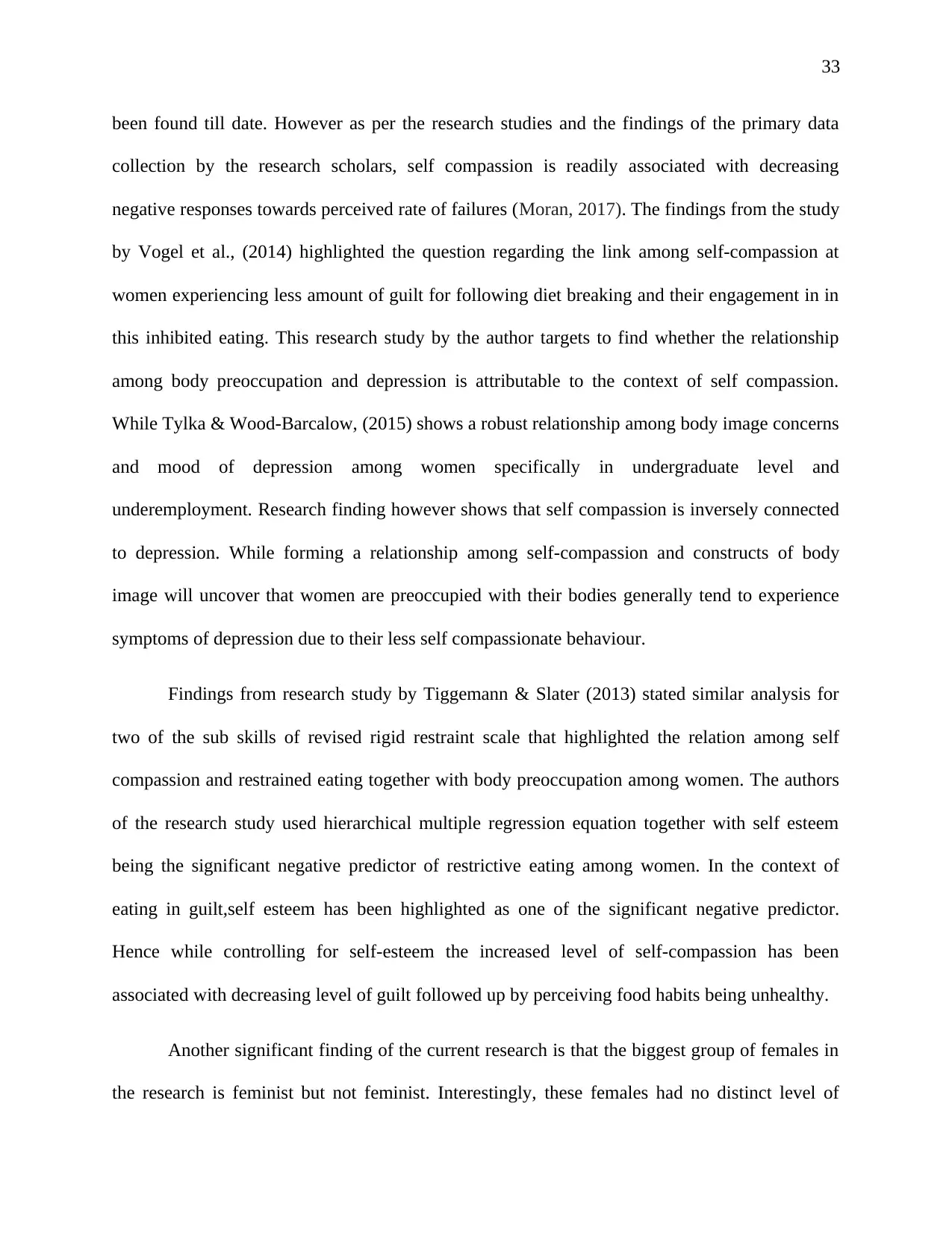
33
been found till date. However as per the research studies and the findings of the primary data
collection by the research scholars, self compassion is readily associated with decreasing
negative responses towards perceived rate of failures (Moran, 2017). The findings from the study
by Vogel et al., (2014) highlighted the question regarding the link among self-compassion at
women experiencing less amount of guilt for following diet breaking and their engagement in in
this inhibited eating. This research study by the author targets to find whether the relationship
among body preoccupation and depression is attributable to the context of self compassion.
While Tylka & Wood-Barcalow, (2015) shows a robust relationship among body image concerns
and mood of depression among women specifically in undergraduate level and
underemployment. Research finding however shows that self compassion is inversely connected
to depression. While forming a relationship among self-compassion and constructs of body
image will uncover that women are preoccupied with their bodies generally tend to experience
symptoms of depression due to their less self compassionate behaviour.
Findings from research study by Tiggemann & Slater (2013) stated similar analysis for
two of the sub skills of revised rigid restraint scale that highlighted the relation among self
compassion and restrained eating together with body preoccupation among women. The authors
of the research study used hierarchical multiple regression equation together with self esteem
being the significant negative predictor of restrictive eating among women. In the context of
eating in guilt,self esteem has been highlighted as one of the significant negative predictor.
Hence while controlling for self-esteem the increased level of self-compassion has been
associated with decreasing level of guilt followed up by perceiving food habits being unhealthy.
Another significant finding of the current research is that the biggest group of females in
the research is feminist but not feminist. Interestingly, these females had no distinct level of
been found till date. However as per the research studies and the findings of the primary data
collection by the research scholars, self compassion is readily associated with decreasing
negative responses towards perceived rate of failures (Moran, 2017). The findings from the study
by Vogel et al., (2014) highlighted the question regarding the link among self-compassion at
women experiencing less amount of guilt for following diet breaking and their engagement in in
this inhibited eating. This research study by the author targets to find whether the relationship
among body preoccupation and depression is attributable to the context of self compassion.
While Tylka & Wood-Barcalow, (2015) shows a robust relationship among body image concerns
and mood of depression among women specifically in undergraduate level and
underemployment. Research finding however shows that self compassion is inversely connected
to depression. While forming a relationship among self-compassion and constructs of body
image will uncover that women are preoccupied with their bodies generally tend to experience
symptoms of depression due to their less self compassionate behaviour.
Findings from research study by Tiggemann & Slater (2013) stated similar analysis for
two of the sub skills of revised rigid restraint scale that highlighted the relation among self
compassion and restrained eating together with body preoccupation among women. The authors
of the research study used hierarchical multiple regression equation together with self esteem
being the significant negative predictor of restrictive eating among women. In the context of
eating in guilt,self esteem has been highlighted as one of the significant negative predictor.
Hence while controlling for self-esteem the increased level of self-compassion has been
associated with decreasing level of guilt followed up by perceiving food habits being unhealthy.
Another significant finding of the current research is that the biggest group of females in
the research is feminist but not feminist. Interestingly, these females had no distinct level of
Secure Best Marks with AI Grader
Need help grading? Try our AI Grader for instant feedback on your assignments.
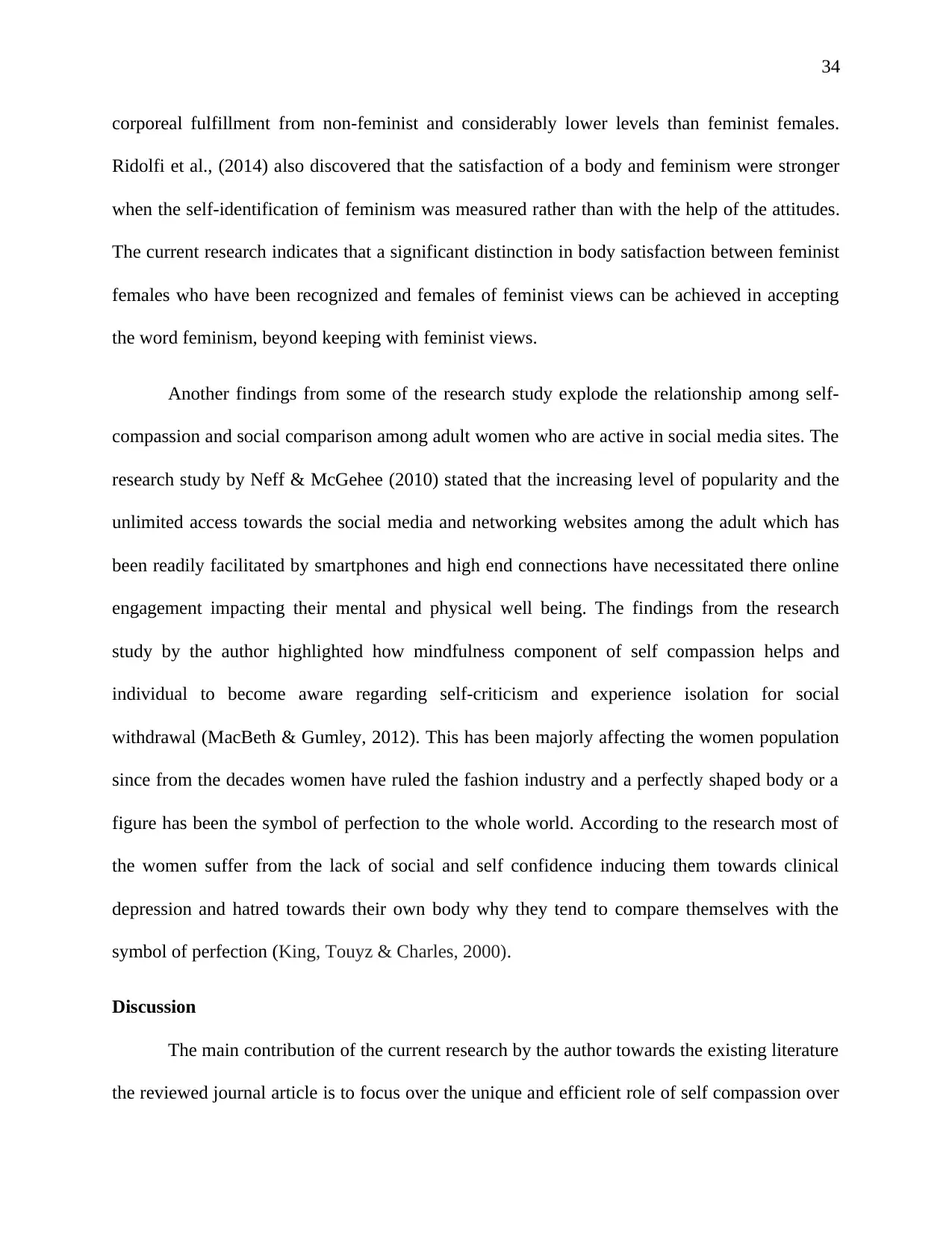
34
corporeal fulfillment from non-feminist and considerably lower levels than feminist females.
Ridolfi et al., (2014) also discovered that the satisfaction of a body and feminism were stronger
when the self-identification of feminism was measured rather than with the help of the attitudes.
The current research indicates that a significant distinction in body satisfaction between feminist
females who have been recognized and females of feminist views can be achieved in accepting
the word feminism, beyond keeping with feminist views.
Another findings from some of the research study explode the relationship among self-
compassion and social comparison among adult women who are active in social media sites. The
research study by Neff & McGehee (2010) stated that the increasing level of popularity and the
unlimited access towards the social media and networking websites among the adult which has
been readily facilitated by smartphones and high end connections have necessitated there online
engagement impacting their mental and physical well being. The findings from the research
study by the author highlighted how mindfulness component of self compassion helps and
individual to become aware regarding self-criticism and experience isolation for social
withdrawal (MacBeth & Gumley, 2012). This has been majorly affecting the women population
since from the decades women have ruled the fashion industry and a perfectly shaped body or a
figure has been the symbol of perfection to the whole world. According to the research most of
the women suffer from the lack of social and self confidence inducing them towards clinical
depression and hatred towards their own body why they tend to compare themselves with the
symbol of perfection (King, Touyz & Charles, 2000).
Discussion
The main contribution of the current research by the author towards the existing literature
the reviewed journal article is to focus over the unique and efficient role of self compassion over
corporeal fulfillment from non-feminist and considerably lower levels than feminist females.
Ridolfi et al., (2014) also discovered that the satisfaction of a body and feminism were stronger
when the self-identification of feminism was measured rather than with the help of the attitudes.
The current research indicates that a significant distinction in body satisfaction between feminist
females who have been recognized and females of feminist views can be achieved in accepting
the word feminism, beyond keeping with feminist views.
Another findings from some of the research study explode the relationship among self-
compassion and social comparison among adult women who are active in social media sites. The
research study by Neff & McGehee (2010) stated that the increasing level of popularity and the
unlimited access towards the social media and networking websites among the adult which has
been readily facilitated by smartphones and high end connections have necessitated there online
engagement impacting their mental and physical well being. The findings from the research
study by the author highlighted how mindfulness component of self compassion helps and
individual to become aware regarding self-criticism and experience isolation for social
withdrawal (MacBeth & Gumley, 2012). This has been majorly affecting the women population
since from the decades women have ruled the fashion industry and a perfectly shaped body or a
figure has been the symbol of perfection to the whole world. According to the research most of
the women suffer from the lack of social and self confidence inducing them towards clinical
depression and hatred towards their own body why they tend to compare themselves with the
symbol of perfection (King, Touyz & Charles, 2000).
Discussion
The main contribution of the current research by the author towards the existing literature
the reviewed journal article is to focus over the unique and efficient role of self compassion over
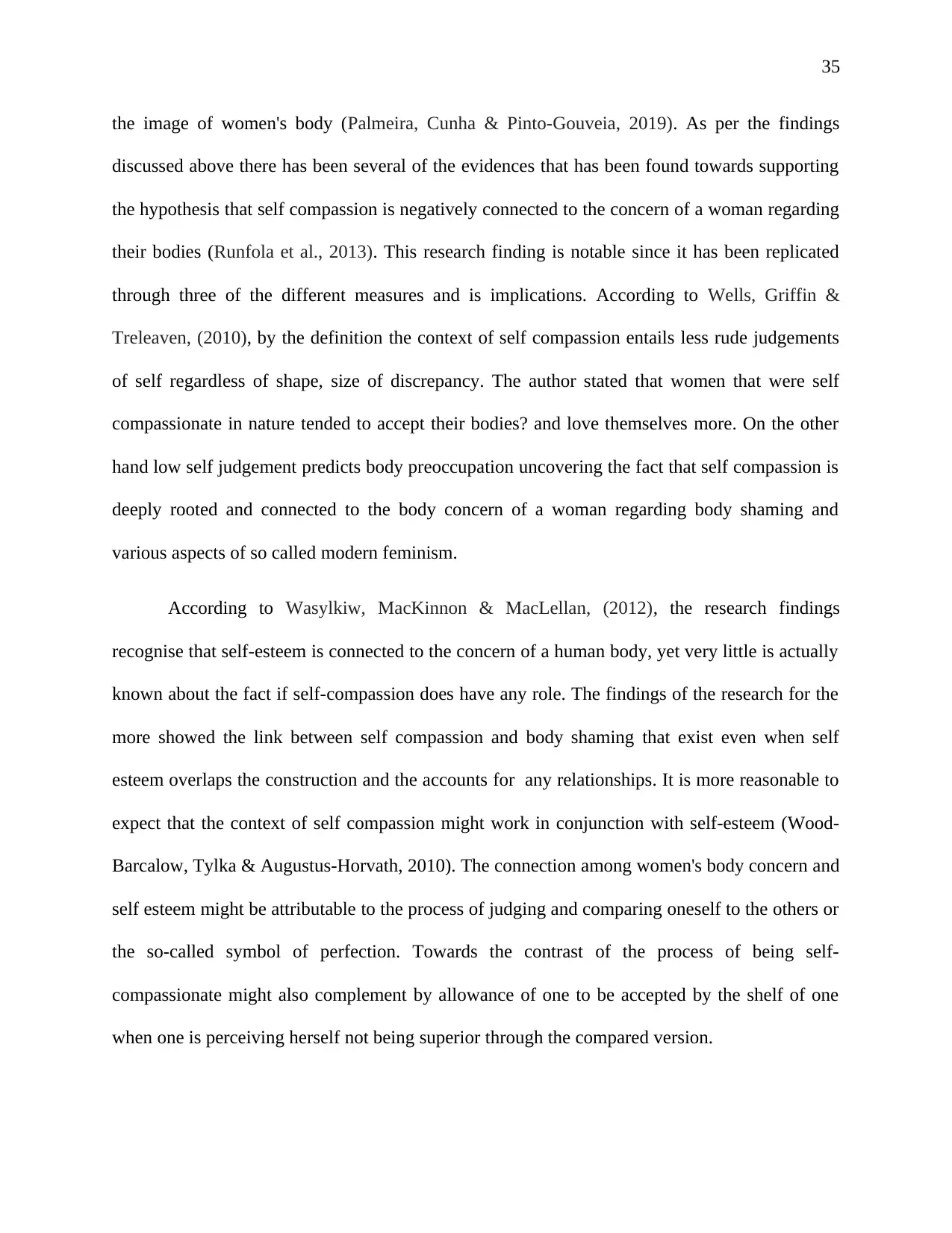
35
the image of women's body (Palmeira, Cunha & Pinto-Gouveia, 2019). As per the findings
discussed above there has been several of the evidences that has been found towards supporting
the hypothesis that self compassion is negatively connected to the concern of a woman regarding
their bodies (Runfola et al., 2013). This research finding is notable since it has been replicated
through three of the different measures and is implications. According to Wells, Griffin &
Treleaven, (2010), by the definition the context of self compassion entails less rude judgements
of self regardless of shape, size of discrepancy. The author stated that women that were self
compassionate in nature tended to accept their bodies? and love themselves more. On the other
hand low self judgement predicts body preoccupation uncovering the fact that self compassion is
deeply rooted and connected to the body concern of a woman regarding body shaming and
various aspects of so called modern feminism.
According to Wasylkiw, MacKinnon & MacLellan, (2012), the research findings
recognise that self-esteem is connected to the concern of a human body, yet very little is actually
known about the fact if self-compassion does have any role. The findings of the research for the
more showed the link between self compassion and body shaming that exist even when self
esteem overlaps the construction and the accounts for any relationships. It is more reasonable to
expect that the context of self compassion might work in conjunction with self-esteem (Wood-
Barcalow, Tylka & Augustus-Horvath, 2010). The connection among women's body concern and
self esteem might be attributable to the process of judging and comparing oneself to the others or
the so-called symbol of perfection. Towards the contrast of the process of being self-
compassionate might also complement by allowance of one to be accepted by the shelf of one
when one is perceiving herself not being superior through the compared version.
the image of women's body (Palmeira, Cunha & Pinto-Gouveia, 2019). As per the findings
discussed above there has been several of the evidences that has been found towards supporting
the hypothesis that self compassion is negatively connected to the concern of a woman regarding
their bodies (Runfola et al., 2013). This research finding is notable since it has been replicated
through three of the different measures and is implications. According to Wells, Griffin &
Treleaven, (2010), by the definition the context of self compassion entails less rude judgements
of self regardless of shape, size of discrepancy. The author stated that women that were self
compassionate in nature tended to accept their bodies? and love themselves more. On the other
hand low self judgement predicts body preoccupation uncovering the fact that self compassion is
deeply rooted and connected to the body concern of a woman regarding body shaming and
various aspects of so called modern feminism.
According to Wasylkiw, MacKinnon & MacLellan, (2012), the research findings
recognise that self-esteem is connected to the concern of a human body, yet very little is actually
known about the fact if self-compassion does have any role. The findings of the research for the
more showed the link between self compassion and body shaming that exist even when self
esteem overlaps the construction and the accounts for any relationships. It is more reasonable to
expect that the context of self compassion might work in conjunction with self-esteem (Wood-
Barcalow, Tylka & Augustus-Horvath, 2010). The connection among women's body concern and
self esteem might be attributable to the process of judging and comparing oneself to the others or
the so-called symbol of perfection. Towards the contrast of the process of being self-
compassionate might also complement by allowance of one to be accepted by the shelf of one
when one is perceiving herself not being superior through the compared version.
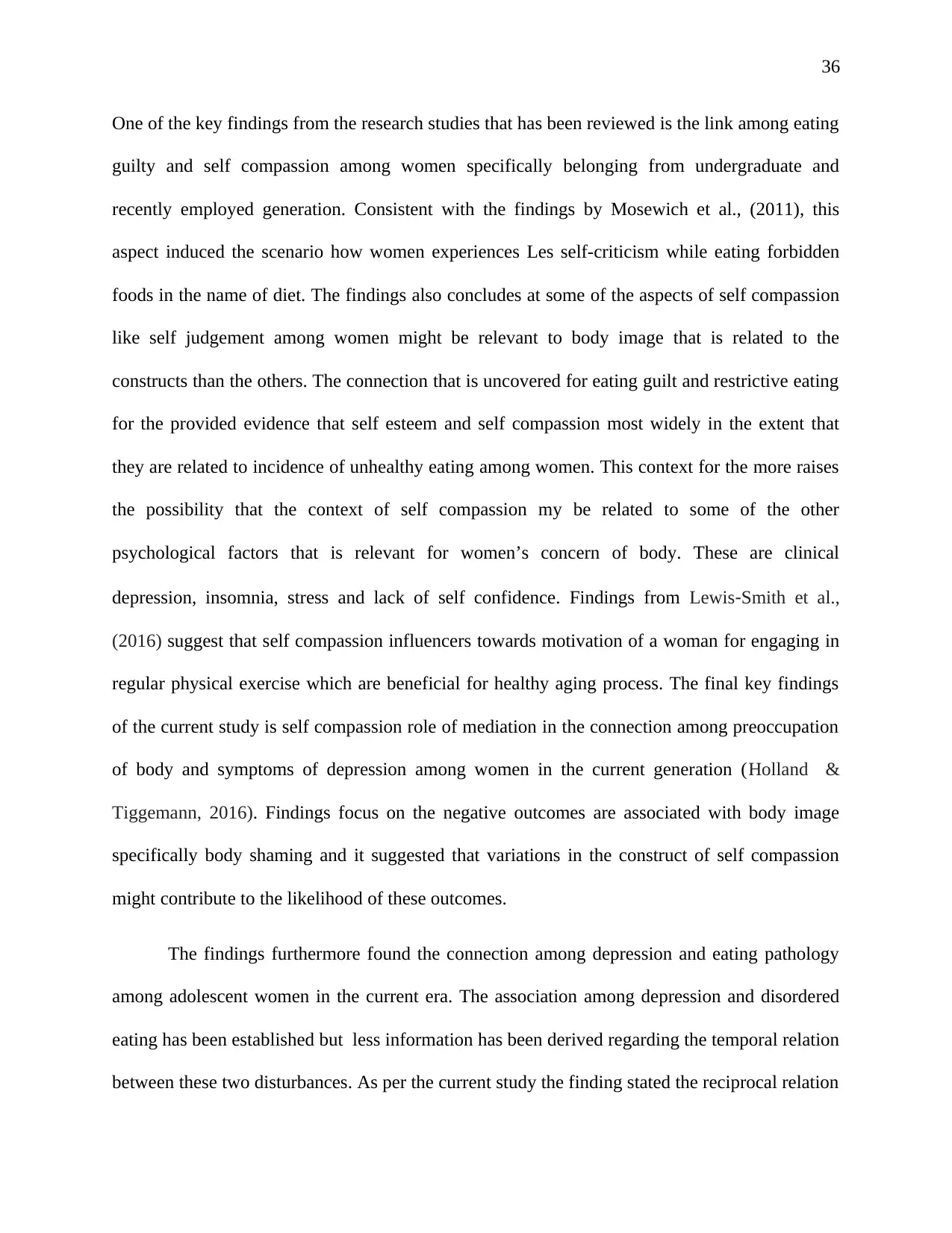
36
One of the key findings from the research studies that has been reviewed is the link among eating
guilty and self compassion among women specifically belonging from undergraduate and
recently employed generation. Consistent with the findings by Mosewich et al., (2011), this
aspect induced the scenario how women experiences Les self-criticism while eating forbidden
foods in the name of diet. The findings also concludes at some of the aspects of self compassion
like self judgement among women might be relevant to body image that is related to the
constructs than the others. The connection that is uncovered for eating guilt and restrictive eating
for the provided evidence that self esteem and self compassion most widely in the extent that
they are related to incidence of unhealthy eating among women. This context for the more raises
the possibility that the context of self compassion my be related to some of the other
psychological factors that is relevant for women’s concern of body. These are clinical
depression, insomnia, stress and lack of self confidence. Findings from Lewis‐Smith et al.,
(2016) suggest that self compassion influencers towards motivation of a woman for engaging in
regular physical exercise which are beneficial for healthy aging process. The final key findings
of the current study is self compassion role of mediation in the connection among preoccupation
of body and symptoms of depression among women in the current generation (Holland &
Tiggemann, 2016). Findings focus on the negative outcomes are associated with body image
specifically body shaming and it suggested that variations in the construct of self compassion
might contribute to the likelihood of these outcomes.
The findings furthermore found the connection among depression and eating pathology
among adolescent women in the current era. The association among depression and disordered
eating has been established but less information has been derived regarding the temporal relation
between these two disturbances. As per the current study the finding stated the reciprocal relation
One of the key findings from the research studies that has been reviewed is the link among eating
guilty and self compassion among women specifically belonging from undergraduate and
recently employed generation. Consistent with the findings by Mosewich et al., (2011), this
aspect induced the scenario how women experiences Les self-criticism while eating forbidden
foods in the name of diet. The findings also concludes at some of the aspects of self compassion
like self judgement among women might be relevant to body image that is related to the
constructs than the others. The connection that is uncovered for eating guilt and restrictive eating
for the provided evidence that self esteem and self compassion most widely in the extent that
they are related to incidence of unhealthy eating among women. This context for the more raises
the possibility that the context of self compassion my be related to some of the other
psychological factors that is relevant for women’s concern of body. These are clinical
depression, insomnia, stress and lack of self confidence. Findings from Lewis‐Smith et al.,
(2016) suggest that self compassion influencers towards motivation of a woman for engaging in
regular physical exercise which are beneficial for healthy aging process. The final key findings
of the current study is self compassion role of mediation in the connection among preoccupation
of body and symptoms of depression among women in the current generation (Holland &
Tiggemann, 2016). Findings focus on the negative outcomes are associated with body image
specifically body shaming and it suggested that variations in the construct of self compassion
might contribute to the likelihood of these outcomes.
The findings furthermore found the connection among depression and eating pathology
among adolescent women in the current era. The association among depression and disordered
eating has been established but less information has been derived regarding the temporal relation
between these two disturbances. As per the current study the finding stated the reciprocal relation
Paraphrase This Document
Need a fresh take? Get an instant paraphrase of this document with our AI Paraphraser
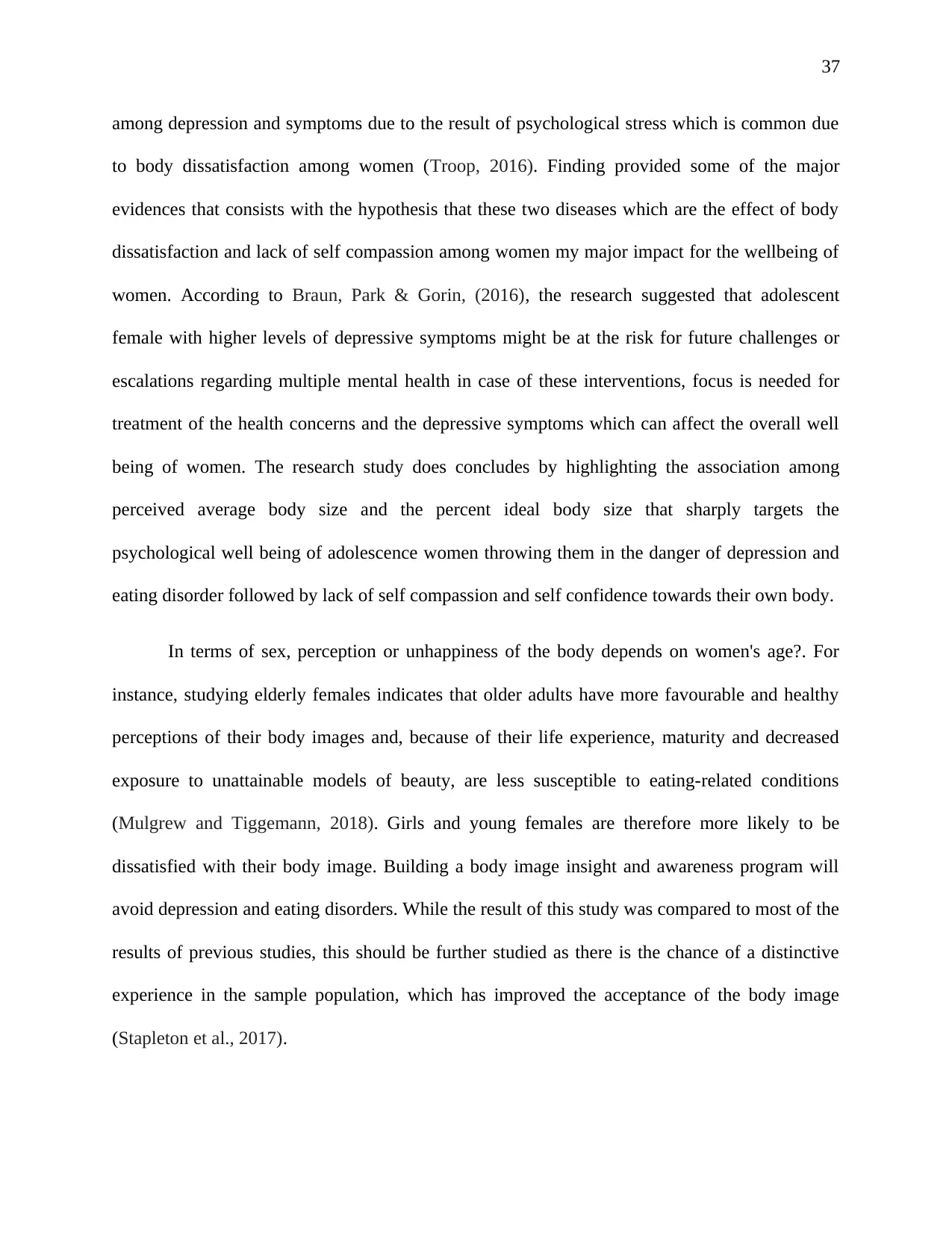
37
among depression and symptoms due to the result of psychological stress which is common due
to body dissatisfaction among women (Troop, 2016). Finding provided some of the major
evidences that consists with the hypothesis that these two diseases which are the effect of body
dissatisfaction and lack of self compassion among women my major impact for the wellbeing of
women. According to Braun, Park & Gorin, (2016), the research suggested that adolescent
female with higher levels of depressive symptoms might be at the risk for future challenges or
escalations regarding multiple mental health in case of these interventions, focus is needed for
treatment of the health concerns and the depressive symptoms which can affect the overall well
being of women. The research study does concludes by highlighting the association among
perceived average body size and the percent ideal body size that sharply targets the
psychological well being of adolescence women throwing them in the danger of depression and
eating disorder followed by lack of self compassion and self confidence towards their own body.
In terms of sex, perception or unhappiness of the body depends on women's age?. For
instance, studying elderly females indicates that older adults have more favourable and healthy
perceptions of their body images and, because of their life experience, maturity and decreased
exposure to unattainable models of beauty, are less susceptible to eating-related conditions
(Mulgrew and Tiggemann, 2018). Girls and young females are therefore more likely to be
dissatisfied with their body image. Building a body image insight and awareness program will
avoid depression and eating disorders. While the result of this study was compared to most of the
results of previous studies, this should be further studied as there is the chance of a distinctive
experience in the sample population, which has improved the acceptance of the body image
(Stapleton et al., 2017).
among depression and symptoms due to the result of psychological stress which is common due
to body dissatisfaction among women (Troop, 2016). Finding provided some of the major
evidences that consists with the hypothesis that these two diseases which are the effect of body
dissatisfaction and lack of self compassion among women my major impact for the wellbeing of
women. According to Braun, Park & Gorin, (2016), the research suggested that adolescent
female with higher levels of depressive symptoms might be at the risk for future challenges or
escalations regarding multiple mental health in case of these interventions, focus is needed for
treatment of the health concerns and the depressive symptoms which can affect the overall well
being of women. The research study does concludes by highlighting the association among
perceived average body size and the percent ideal body size that sharply targets the
psychological well being of adolescence women throwing them in the danger of depression and
eating disorder followed by lack of self compassion and self confidence towards their own body.
In terms of sex, perception or unhappiness of the body depends on women's age?. For
instance, studying elderly females indicates that older adults have more favourable and healthy
perceptions of their body images and, because of their life experience, maturity and decreased
exposure to unattainable models of beauty, are less susceptible to eating-related conditions
(Mulgrew and Tiggemann, 2018). Girls and young females are therefore more likely to be
dissatisfied with their body image. Building a body image insight and awareness program will
avoid depression and eating disorders. While the result of this study was compared to most of the
results of previous studies, this should be further studied as there is the chance of a distinctive
experience in the sample population, which has improved the acceptance of the body image
(Stapleton et al., 2017).
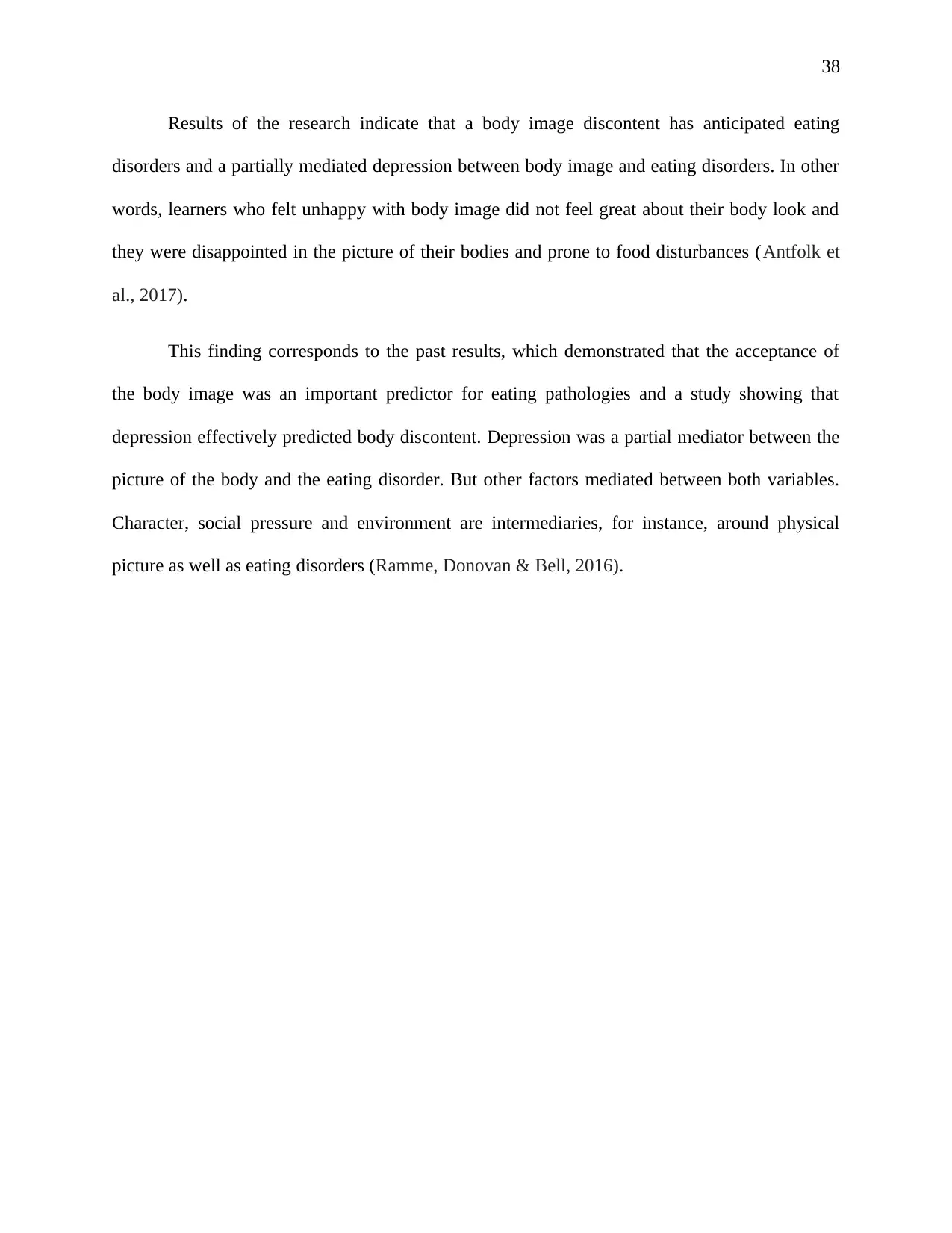
38
Results of the research indicate that a body image discontent has anticipated eating
disorders and a partially mediated depression between body image and eating disorders. In other
words, learners who felt unhappy with body image did not feel great about their body look and
they were disappointed in the picture of their bodies and prone to food disturbances (Antfolk et
al., 2017).
This finding corresponds to the past results, which demonstrated that the acceptance of
the body image was an important predictor for eating pathologies and a study showing that
depression effectively predicted body discontent. Depression was a partial mediator between the
picture of the body and the eating disorder. But other factors mediated between both variables.
Character, social pressure and environment are intermediaries, for instance, around physical
picture as well as eating disorders (Ramme, Donovan & Bell, 2016).
Results of the research indicate that a body image discontent has anticipated eating
disorders and a partially mediated depression between body image and eating disorders. In other
words, learners who felt unhappy with body image did not feel great about their body look and
they were disappointed in the picture of their bodies and prone to food disturbances (Antfolk et
al., 2017).
This finding corresponds to the past results, which demonstrated that the acceptance of
the body image was an important predictor for eating pathologies and a study showing that
depression effectively predicted body discontent. Depression was a partial mediator between the
picture of the body and the eating disorder. But other factors mediated between both variables.
Character, social pressure and environment are intermediaries, for instance, around physical
picture as well as eating disorders (Ramme, Donovan & Bell, 2016).
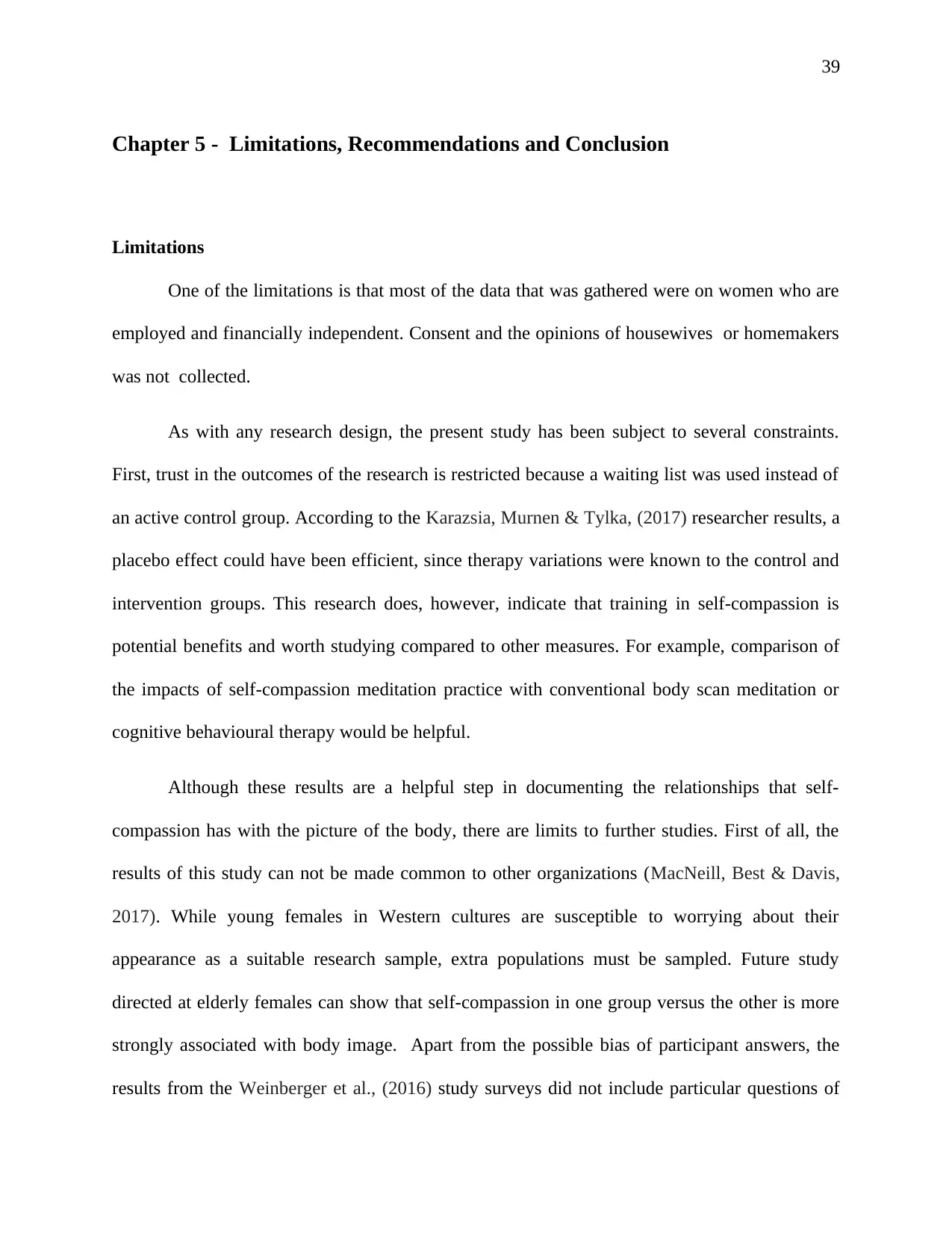
39
Chapter 5 - Limitations, Recommendations and Conclusion
Limitations
One of the limitations is that most of the data that was gathered were on women who are
employed and financially independent. Consent and the opinions of housewives or homemakers
was not collected.
As with any research design, the present study has been subject to several constraints.
First, trust in the outcomes of the research is restricted because a waiting list was used instead of
an active control group. According to the Karazsia, Murnen & Tylka, (2017) researcher results, a
placebo effect could have been efficient, since therapy variations were known to the control and
intervention groups. This research does, however, indicate that training in self-compassion is
potential benefits and worth studying compared to other measures. For example, comparison of
the impacts of self-compassion meditation practice with conventional body scan meditation or
cognitive behavioural therapy would be helpful.
Although these results are a helpful step in documenting the relationships that self-
compassion has with the picture of the body, there are limits to further studies. First of all, the
results of this study can not be made common to other organizations (MacNeill, Best & Davis,
2017). While young females in Western cultures are susceptible to worrying about their
appearance as a suitable research sample, extra populations must be sampled. Future study
directed at elderly females can show that self-compassion in one group versus the other is more
strongly associated with body image. Apart from the possible bias of participant answers, the
results from the Weinberger et al., (2016) study surveys did not include particular questions of
Chapter 5 - Limitations, Recommendations and Conclusion
Limitations
One of the limitations is that most of the data that was gathered were on women who are
employed and financially independent. Consent and the opinions of housewives or homemakers
was not collected.
As with any research design, the present study has been subject to several constraints.
First, trust in the outcomes of the research is restricted because a waiting list was used instead of
an active control group. According to the Karazsia, Murnen & Tylka, (2017) researcher results, a
placebo effect could have been efficient, since therapy variations were known to the control and
intervention groups. This research does, however, indicate that training in self-compassion is
potential benefits and worth studying compared to other measures. For example, comparison of
the impacts of self-compassion meditation practice with conventional body scan meditation or
cognitive behavioural therapy would be helpful.
Although these results are a helpful step in documenting the relationships that self-
compassion has with the picture of the body, there are limits to further studies. First of all, the
results of this study can not be made common to other organizations (MacNeill, Best & Davis,
2017). While young females in Western cultures are susceptible to worrying about their
appearance as a suitable research sample, extra populations must be sampled. Future study
directed at elderly females can show that self-compassion in one group versus the other is more
strongly associated with body image. Apart from the possible bias of participant answers, the
results from the Weinberger et al., (2016) study surveys did not include particular questions of
Secure Best Marks with AI Grader
Need help grading? Try our AI Grader for instant feedback on your assignments.
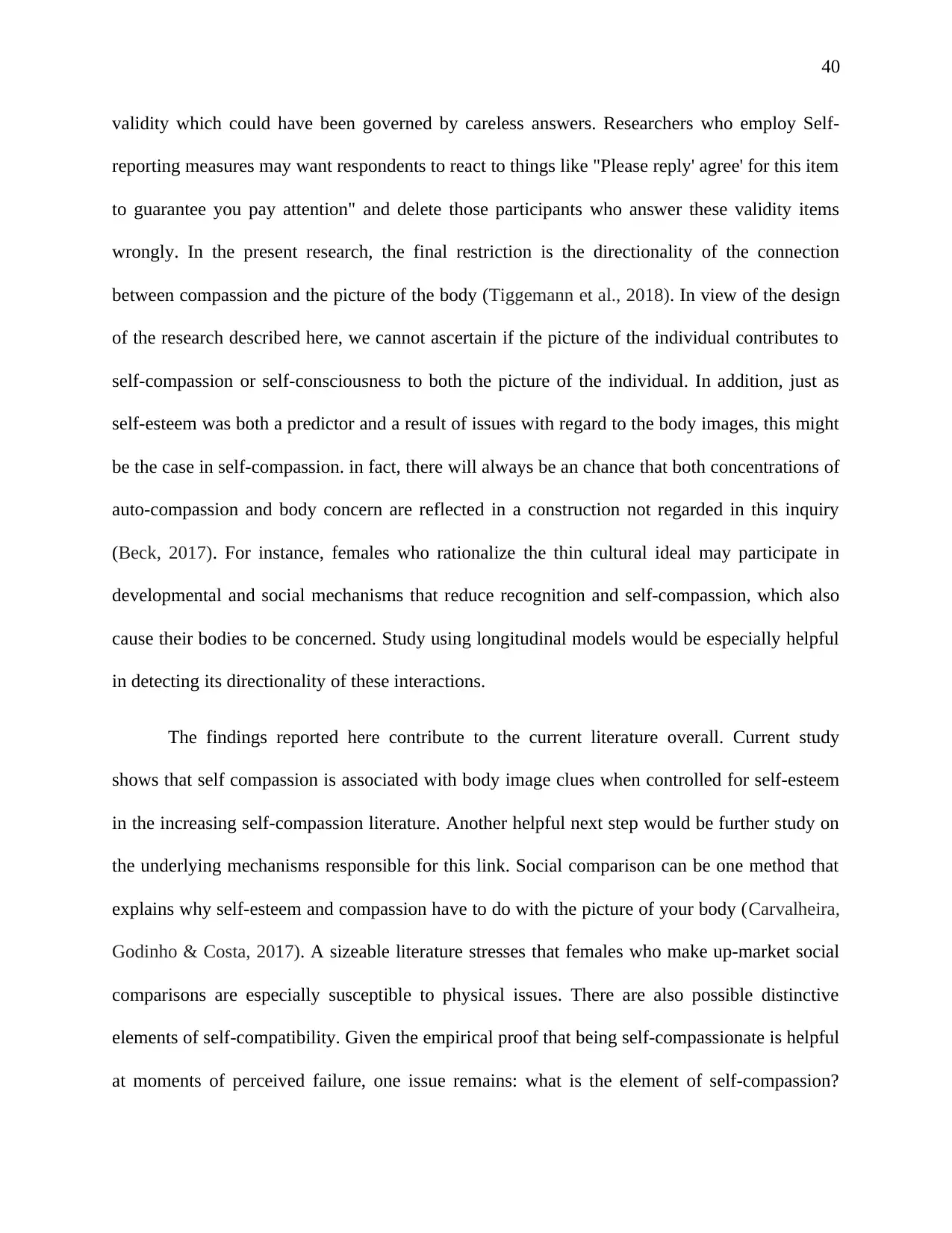
40
validity which could have been governed by careless answers. Researchers who employ Self-
reporting measures may want respondents to react to things like "Please reply' agree' for this item
to guarantee you pay attention" and delete those participants who answer these validity items
wrongly. In the present research, the final restriction is the directionality of the connection
between compassion and the picture of the body (Tiggemann et al., 2018). In view of the design
of the research described here, we cannot ascertain if the picture of the individual contributes to
self-compassion or self-consciousness to both the picture of the individual. In addition, just as
self-esteem was both a predictor and a result of issues with regard to the body images, this might
be the case in self-compassion. in fact, there will always be an chance that both concentrations of
auto-compassion and body concern are reflected in a construction not regarded in this inquiry
(Beck, 2017). For instance, females who rationalize the thin cultural ideal may participate in
developmental and social mechanisms that reduce recognition and self-compassion, which also
cause their bodies to be concerned. Study using longitudinal models would be especially helpful
in detecting its directionality of these interactions.
The findings reported here contribute to the current literature overall. Current study
shows that self compassion is associated with body image clues when controlled for self-esteem
in the increasing self-compassion literature. Another helpful next step would be further study on
the underlying mechanisms responsible for this link. Social comparison can be one method that
explains why self-esteem and compassion have to do with the picture of your body (Carvalheira,
Godinho & Costa, 2017). A sizeable literature stresses that females who make up-market social
comparisons are especially susceptible to physical issues. There are also possible distinctive
elements of self-compatibility. Given the empirical proof that being self-compassionate is helpful
at moments of perceived failure, one issue remains: what is the element of self-compassion?
validity which could have been governed by careless answers. Researchers who employ Self-
reporting measures may want respondents to react to things like "Please reply' agree' for this item
to guarantee you pay attention" and delete those participants who answer these validity items
wrongly. In the present research, the final restriction is the directionality of the connection
between compassion and the picture of the body (Tiggemann et al., 2018). In view of the design
of the research described here, we cannot ascertain if the picture of the individual contributes to
self-compassion or self-consciousness to both the picture of the individual. In addition, just as
self-esteem was both a predictor and a result of issues with regard to the body images, this might
be the case in self-compassion. in fact, there will always be an chance that both concentrations of
auto-compassion and body concern are reflected in a construction not regarded in this inquiry
(Beck, 2017). For instance, females who rationalize the thin cultural ideal may participate in
developmental and social mechanisms that reduce recognition and self-compassion, which also
cause their bodies to be concerned. Study using longitudinal models would be especially helpful
in detecting its directionality of these interactions.
The findings reported here contribute to the current literature overall. Current study
shows that self compassion is associated with body image clues when controlled for self-esteem
in the increasing self-compassion literature. Another helpful next step would be further study on
the underlying mechanisms responsible for this link. Social comparison can be one method that
explains why self-esteem and compassion have to do with the picture of your body (Carvalheira,
Godinho & Costa, 2017). A sizeable literature stresses that females who make up-market social
comparisons are especially susceptible to physical issues. There are also possible distinctive
elements of self-compatibility. Given the empirical proof that being self-compassionate is helpful
at moments of perceived failure, one issue remains: what is the element of self-compassion?
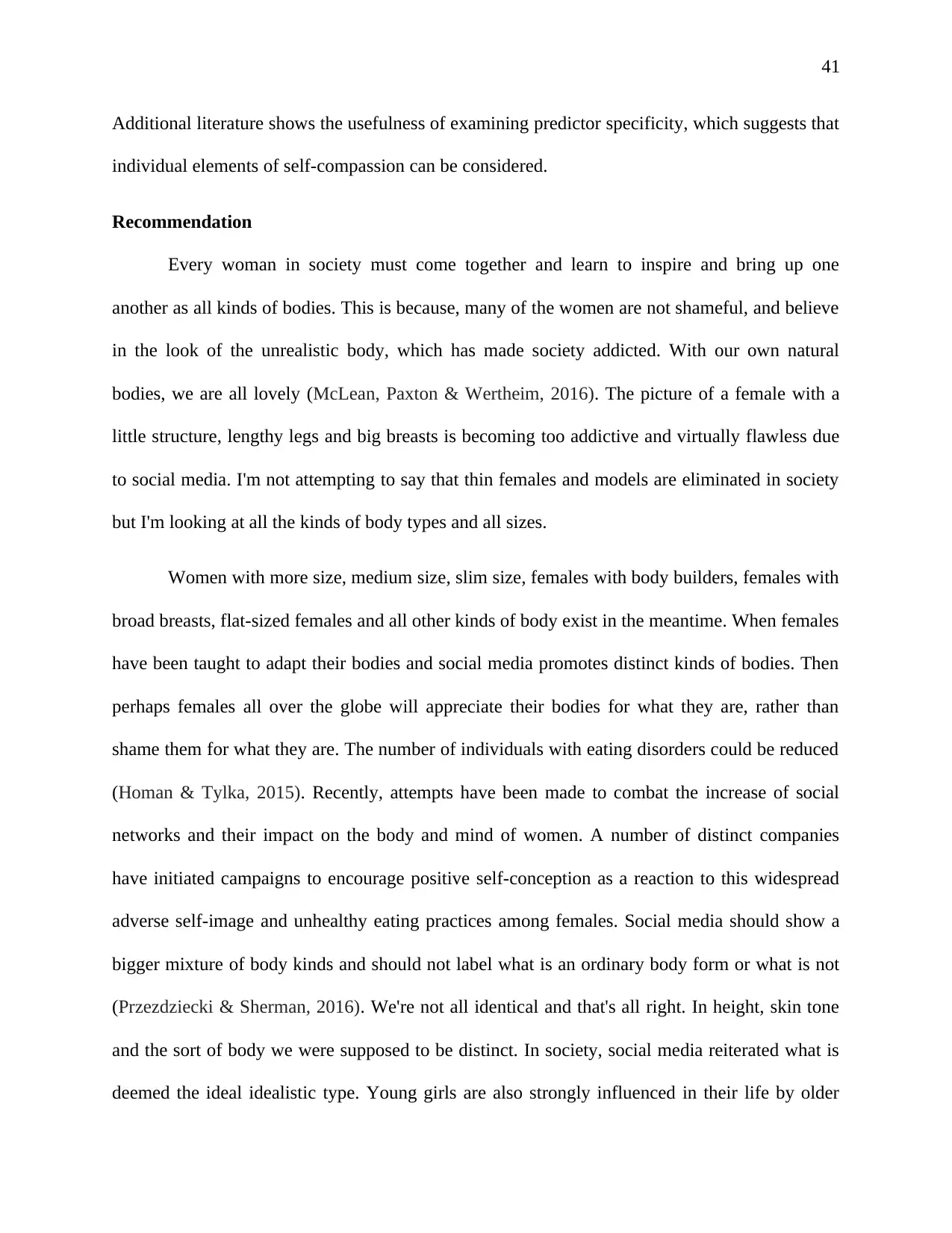
41
Additional literature shows the usefulness of examining predictor specificity, which suggests that
individual elements of self-compassion can be considered.
Recommendation
Every woman in society must come together and learn to inspire and bring up one
another as all kinds of bodies. This is because, many of the women are not shameful, and believe
in the look of the unrealistic body, which has made society addicted. With our own natural
bodies, we are all lovely (McLean, Paxton & Wertheim, 2016). The picture of a female with a
little structure, lengthy legs and big breasts is becoming too addictive and virtually flawless due
to social media. I'm not attempting to say that thin females and models are eliminated in society
but I'm looking at all the kinds of body types and all sizes.
Women with more size, medium size, slim size, females with body builders, females with
broad breasts, flat-sized females and all other kinds of body exist in the meantime. When females
have been taught to adapt their bodies and social media promotes distinct kinds of bodies. Then
perhaps females all over the globe will appreciate their bodies for what they are, rather than
shame them for what they are. The number of individuals with eating disorders could be reduced
(Homan & Tylka, 2015). Recently, attempts have been made to combat the increase of social
networks and their impact on the body and mind of women. A number of distinct companies
have initiated campaigns to encourage positive self-conception as a reaction to this widespread
adverse self-image and unhealthy eating practices among females. Social media should show a
bigger mixture of body kinds and should not label what is an ordinary body form or what is not
(Przezdziecki & Sherman, 2016). We're not all identical and that's all right. In height, skin tone
and the sort of body we were supposed to be distinct. In society, social media reiterated what is
deemed the ideal idealistic type. Young girls are also strongly influenced in their life by older
Additional literature shows the usefulness of examining predictor specificity, which suggests that
individual elements of self-compassion can be considered.
Recommendation
Every woman in society must come together and learn to inspire and bring up one
another as all kinds of bodies. This is because, many of the women are not shameful, and believe
in the look of the unrealistic body, which has made society addicted. With our own natural
bodies, we are all lovely (McLean, Paxton & Wertheim, 2016). The picture of a female with a
little structure, lengthy legs and big breasts is becoming too addictive and virtually flawless due
to social media. I'm not attempting to say that thin females and models are eliminated in society
but I'm looking at all the kinds of body types and all sizes.
Women with more size, medium size, slim size, females with body builders, females with
broad breasts, flat-sized females and all other kinds of body exist in the meantime. When females
have been taught to adapt their bodies and social media promotes distinct kinds of bodies. Then
perhaps females all over the globe will appreciate their bodies for what they are, rather than
shame them for what they are. The number of individuals with eating disorders could be reduced
(Homan & Tylka, 2015). Recently, attempts have been made to combat the increase of social
networks and their impact on the body and mind of women. A number of distinct companies
have initiated campaigns to encourage positive self-conception as a reaction to this widespread
adverse self-image and unhealthy eating practices among females. Social media should show a
bigger mixture of body kinds and should not label what is an ordinary body form or what is not
(Przezdziecki & Sherman, 2016). We're not all identical and that's all right. In height, skin tone
and the sort of body we were supposed to be distinct. In society, social media reiterated what is
deemed the ideal idealistic type. Young girls are also strongly influenced in their life by older
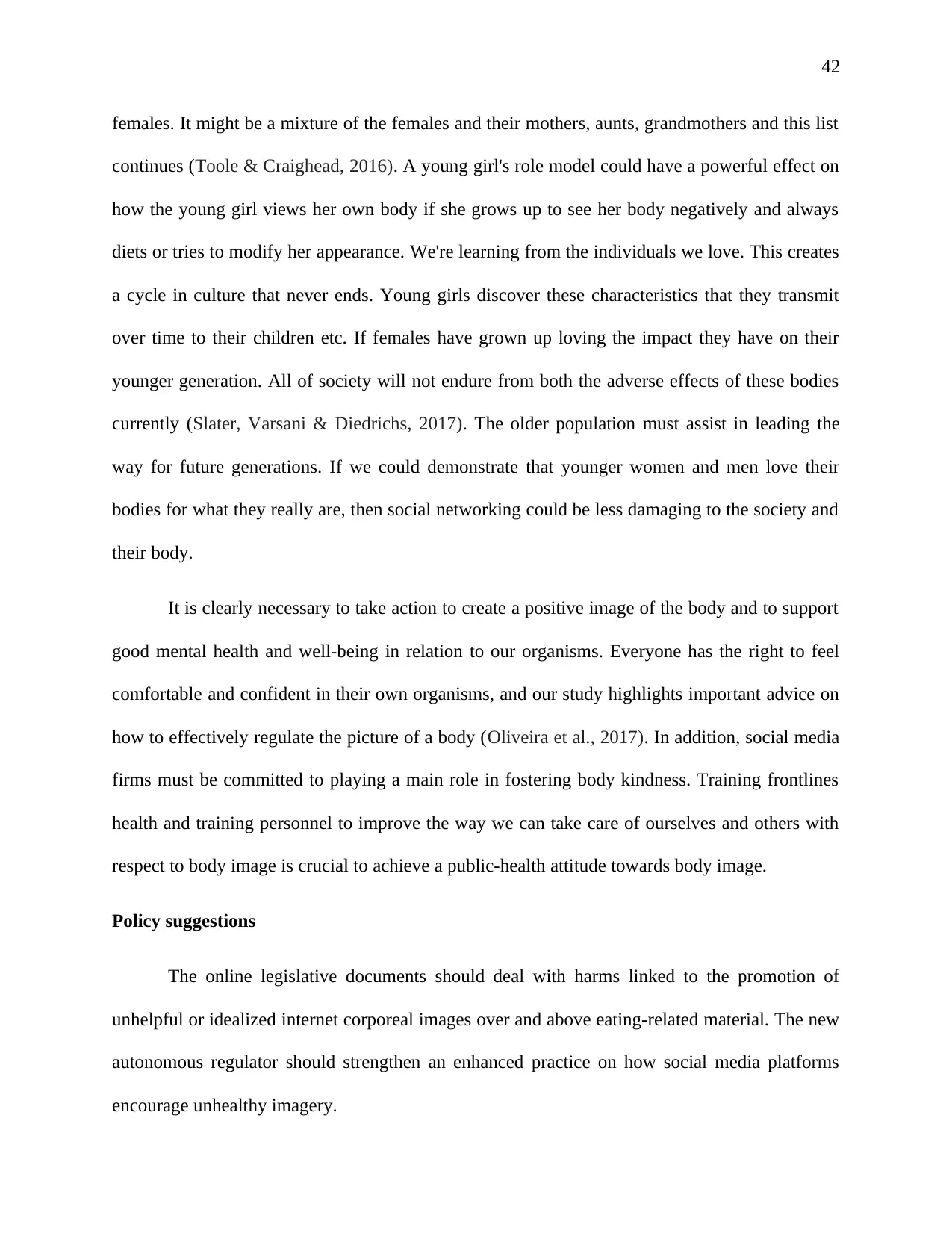
42
females. It might be a mixture of the females and their mothers, aunts, grandmothers and this list
continues (Toole & Craighead, 2016). A young girl's role model could have a powerful effect on
how the young girl views her own body if she grows up to see her body negatively and always
diets or tries to modify her appearance. We're learning from the individuals we love. This creates
a cycle in culture that never ends. Young girls discover these characteristics that they transmit
over time to their children etc. If females have grown up loving the impact they have on their
younger generation. All of society will not endure from both the adverse effects of these bodies
currently (Slater, Varsani & Diedrichs, 2017). The older population must assist in leading the
way for future generations. If we could demonstrate that younger women and men love their
bodies for what they really are, then social networking could be less damaging to the society and
their body.
It is clearly necessary to take action to create a positive image of the body and to support
good mental health and well-being in relation to our organisms. Everyone has the right to feel
comfortable and confident in their own organisms, and our study highlights important advice on
how to effectively regulate the picture of a body (Oliveira et al., 2017). In addition, social media
firms must be committed to playing a main role in fostering body kindness. Training frontlines
health and training personnel to improve the way we can take care of ourselves and others with
respect to body image is crucial to achieve a public-health attitude towards body image.
Policy suggestions
The online legislative documents should deal with harms linked to the promotion of
unhelpful or idealized internet corporeal images over and above eating-related material. The new
autonomous regulator should strengthen an enhanced practice on how social media platforms
encourage unhealthy imagery.
females. It might be a mixture of the females and their mothers, aunts, grandmothers and this list
continues (Toole & Craighead, 2016). A young girl's role model could have a powerful effect on
how the young girl views her own body if she grows up to see her body negatively and always
diets or tries to modify her appearance. We're learning from the individuals we love. This creates
a cycle in culture that never ends. Young girls discover these characteristics that they transmit
over time to their children etc. If females have grown up loving the impact they have on their
younger generation. All of society will not endure from both the adverse effects of these bodies
currently (Slater, Varsani & Diedrichs, 2017). The older population must assist in leading the
way for future generations. If we could demonstrate that younger women and men love their
bodies for what they really are, then social networking could be less damaging to the society and
their body.
It is clearly necessary to take action to create a positive image of the body and to support
good mental health and well-being in relation to our organisms. Everyone has the right to feel
comfortable and confident in their own organisms, and our study highlights important advice on
how to effectively regulate the picture of a body (Oliveira et al., 2017). In addition, social media
firms must be committed to playing a main role in fostering body kindness. Training frontlines
health and training personnel to improve the way we can take care of ourselves and others with
respect to body image is crucial to achieve a public-health attitude towards body image.
Policy suggestions
The online legislative documents should deal with harms linked to the promotion of
unhelpful or idealized internet corporeal images over and above eating-related material. The new
autonomous regulator should strengthen an enhanced practice on how social media platforms
encourage unhealthy imagery.
Paraphrase This Document
Need a fresh take? Get an instant paraphrase of this document with our AI Paraphraser
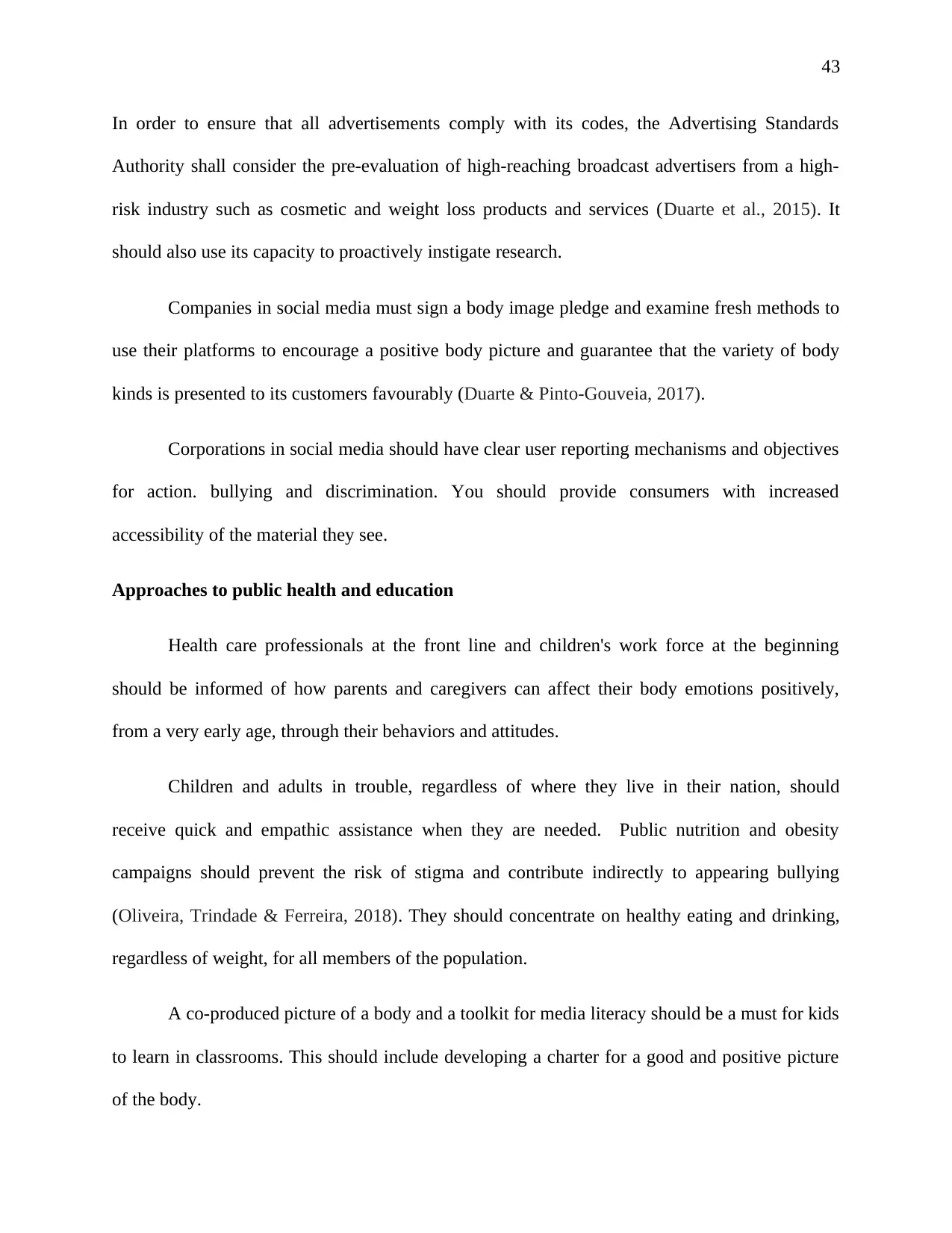
43
In order to ensure that all advertisements comply with its codes, the Advertising Standards
Authority shall consider the pre-evaluation of high-reaching broadcast advertisers from a high-
risk industry such as cosmetic and weight loss products and services (Duarte et al., 2015). It
should also use its capacity to proactively instigate research.
Companies in social media must sign a body image pledge and examine fresh methods to
use their platforms to encourage a positive body picture and guarantee that the variety of body
kinds is presented to its customers favourably (Duarte & Pinto-Gouveia, 2017).
Corporations in social media should have clear user reporting mechanisms and objectives
for action. bullying and discrimination. You should provide consumers with increased
accessibility of the material they see.
Approaches to public health and education
Health care professionals at the front line and children's work force at the beginning
should be informed of how parents and caregivers can affect their body emotions positively,
from a very early age, through their behaviors and attitudes.
Children and adults in trouble, regardless of where they live in their nation, should
receive quick and empathic assistance when they are needed. Public nutrition and obesity
campaigns should prevent the risk of stigma and contribute indirectly to appearing bullying
(Oliveira, Trindade & Ferreira, 2018). They should concentrate on healthy eating and drinking,
regardless of weight, for all members of the population.
A co-produced picture of a body and a toolkit for media literacy should be a must for kids
to learn in classrooms. This should include developing a charter for a good and positive picture
of the body.
In order to ensure that all advertisements comply with its codes, the Advertising Standards
Authority shall consider the pre-evaluation of high-reaching broadcast advertisers from a high-
risk industry such as cosmetic and weight loss products and services (Duarte et al., 2015). It
should also use its capacity to proactively instigate research.
Companies in social media must sign a body image pledge and examine fresh methods to
use their platforms to encourage a positive body picture and guarantee that the variety of body
kinds is presented to its customers favourably (Duarte & Pinto-Gouveia, 2017).
Corporations in social media should have clear user reporting mechanisms and objectives
for action. bullying and discrimination. You should provide consumers with increased
accessibility of the material they see.
Approaches to public health and education
Health care professionals at the front line and children's work force at the beginning
should be informed of how parents and caregivers can affect their body emotions positively,
from a very early age, through their behaviors and attitudes.
Children and adults in trouble, regardless of where they live in their nation, should
receive quick and empathic assistance when they are needed. Public nutrition and obesity
campaigns should prevent the risk of stigma and contribute indirectly to appearing bullying
(Oliveira, Trindade & Ferreira, 2018). They should concentrate on healthy eating and drinking,
regardless of weight, for all members of the population.
A co-produced picture of a body and a toolkit for media literacy should be a must for kids
to learn in classrooms. This should include developing a charter for a good and positive picture
of the body.
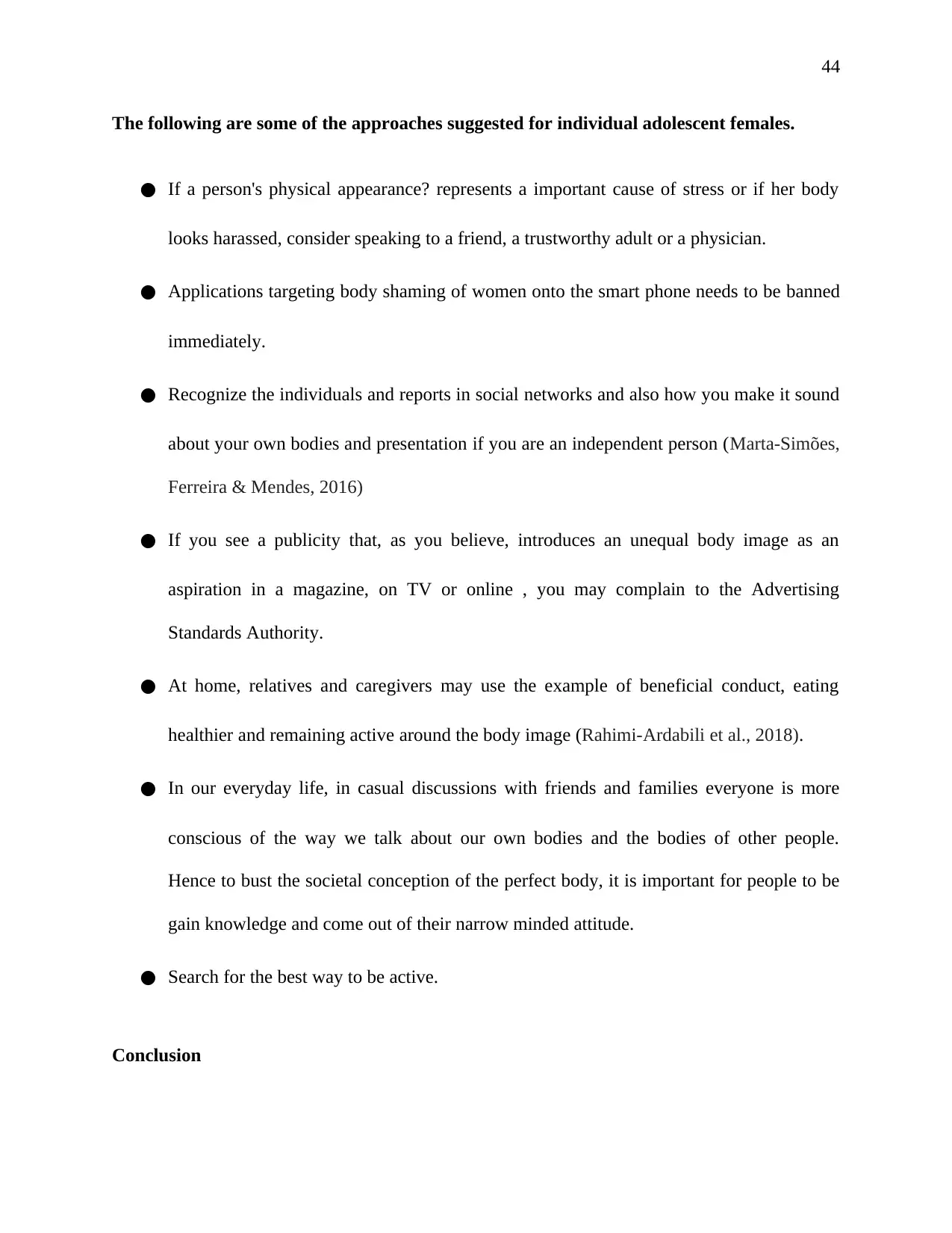
44
The following are some of the approaches suggested for individual adolescent females.
● If a person's physical appearance? represents a important cause of stress or if her body
looks harassed, consider speaking to a friend, a trustworthy adult or a physician.
● Applications targeting body shaming of women onto the smart phone needs to be banned
immediately.
● Recognize the individuals and reports in social networks and also how you make it sound
about your own bodies and presentation if you are an independent person (Marta-Simões,
Ferreira & Mendes, 2016)
● If you see a publicity that, as you believe, introduces an unequal body image as an
aspiration in a magazine, on TV or online , you may complain to the Advertising
Standards Authority.
● At home, relatives and caregivers may use the example of beneficial conduct, eating
healthier and remaining active around the body image (Rahimi-Ardabili et al., 2018).
● In our everyday life, in casual discussions with friends and families everyone is more
conscious of the way we talk about our own bodies and the bodies of other people.
Hence to bust the societal conception of the perfect body, it is important for people to be
gain knowledge and come out of their narrow minded attitude.
● Search for the best way to be active.
Conclusion
The following are some of the approaches suggested for individual adolescent females.
● If a person's physical appearance? represents a important cause of stress or if her body
looks harassed, consider speaking to a friend, a trustworthy adult or a physician.
● Applications targeting body shaming of women onto the smart phone needs to be banned
immediately.
● Recognize the individuals and reports in social networks and also how you make it sound
about your own bodies and presentation if you are an independent person (Marta-Simões,
Ferreira & Mendes, 2016)
● If you see a publicity that, as you believe, introduces an unequal body image as an
aspiration in a magazine, on TV or online , you may complain to the Advertising
Standards Authority.
● At home, relatives and caregivers may use the example of beneficial conduct, eating
healthier and remaining active around the body image (Rahimi-Ardabili et al., 2018).
● In our everyday life, in casual discussions with friends and families everyone is more
conscious of the way we talk about our own bodies and the bodies of other people.
Hence to bust the societal conception of the perfect body, it is important for people to be
gain knowledge and come out of their narrow minded attitude.
● Search for the best way to be active.
Conclusion
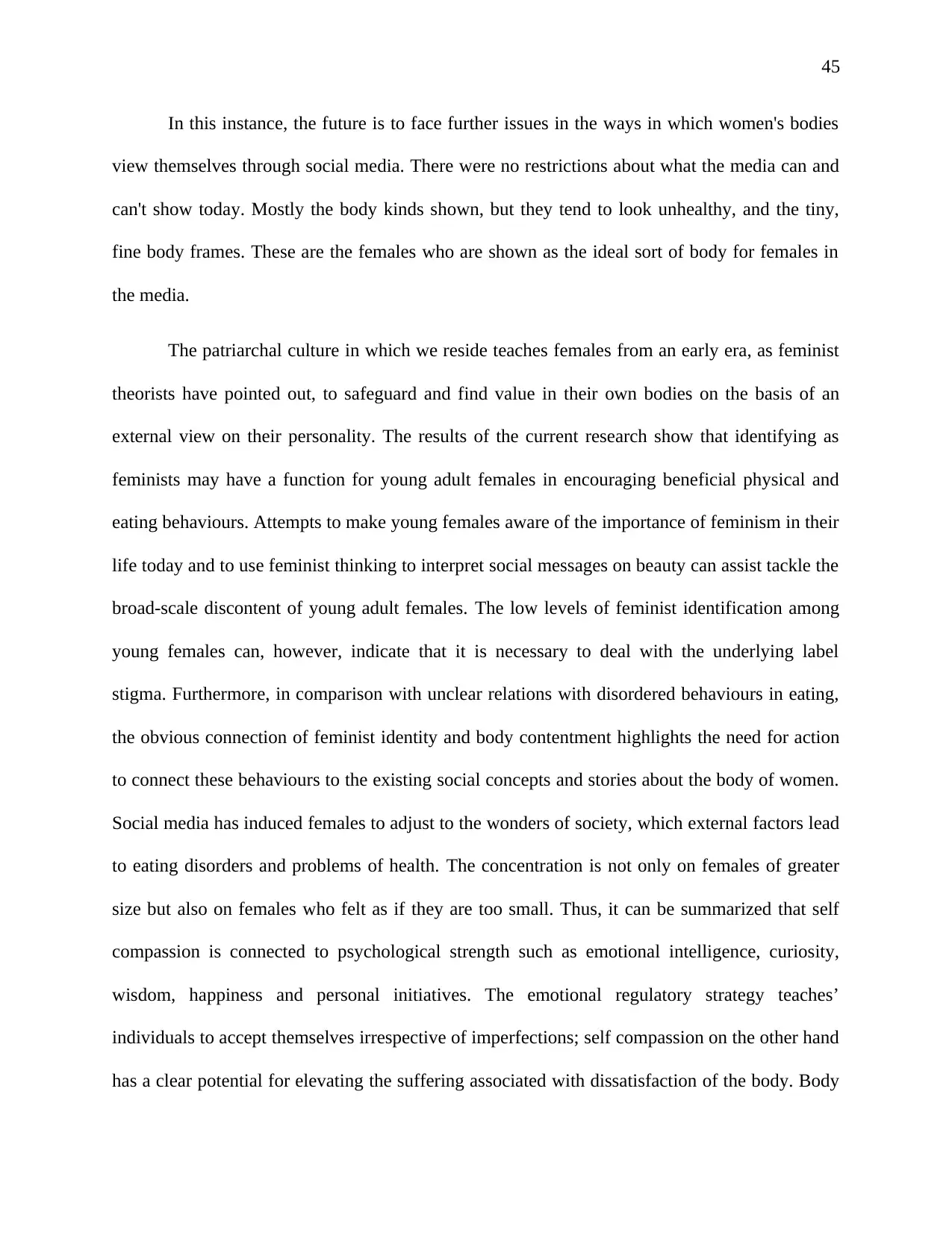
45
In this instance, the future is to face further issues in the ways in which women's bodies
view themselves through social media. There were no restrictions about what the media can and
can't show today. Mostly the body kinds shown, but they tend to look unhealthy, and the tiny,
fine body frames. These are the females who are shown as the ideal sort of body for females in
the media.
The patriarchal culture in which we reside teaches females from an early era, as feminist
theorists have pointed out, to safeguard and find value in their own bodies on the basis of an
external view on their personality. The results of the current research show that identifying as
feminists may have a function for young adult females in encouraging beneficial physical and
eating behaviours. Attempts to make young females aware of the importance of feminism in their
life today and to use feminist thinking to interpret social messages on beauty can assist tackle the
broad-scale discontent of young adult females. The low levels of feminist identification among
young females can, however, indicate that it is necessary to deal with the underlying label
stigma. Furthermore, in comparison with unclear relations with disordered behaviours in eating,
the obvious connection of feminist identity and body contentment highlights the need for action
to connect these behaviours to the existing social concepts and stories about the body of women.
Social media has induced females to adjust to the wonders of society, which external factors lead
to eating disorders and problems of health. The concentration is not only on females of greater
size but also on females who felt as if they are too small. Thus, it can be summarized that self
compassion is connected to psychological strength such as emotional intelligence, curiosity,
wisdom, happiness and personal initiatives. The emotional regulatory strategy teaches’
individuals to accept themselves irrespective of imperfections; self compassion on the other hand
has a clear potential for elevating the suffering associated with dissatisfaction of the body. Body
In this instance, the future is to face further issues in the ways in which women's bodies
view themselves through social media. There were no restrictions about what the media can and
can't show today. Mostly the body kinds shown, but they tend to look unhealthy, and the tiny,
fine body frames. These are the females who are shown as the ideal sort of body for females in
the media.
The patriarchal culture in which we reside teaches females from an early era, as feminist
theorists have pointed out, to safeguard and find value in their own bodies on the basis of an
external view on their personality. The results of the current research show that identifying as
feminists may have a function for young adult females in encouraging beneficial physical and
eating behaviours. Attempts to make young females aware of the importance of feminism in their
life today and to use feminist thinking to interpret social messages on beauty can assist tackle the
broad-scale discontent of young adult females. The low levels of feminist identification among
young females can, however, indicate that it is necessary to deal with the underlying label
stigma. Furthermore, in comparison with unclear relations with disordered behaviours in eating,
the obvious connection of feminist identity and body contentment highlights the need for action
to connect these behaviours to the existing social concepts and stories about the body of women.
Social media has induced females to adjust to the wonders of society, which external factors lead
to eating disorders and problems of health. The concentration is not only on females of greater
size but also on females who felt as if they are too small. Thus, it can be summarized that self
compassion is connected to psychological strength such as emotional intelligence, curiosity,
wisdom, happiness and personal initiatives. The emotional regulatory strategy teaches’
individuals to accept themselves irrespective of imperfections; self compassion on the other hand
has a clear potential for elevating the suffering associated with dissatisfaction of the body. Body
Secure Best Marks with AI Grader
Need help grading? Try our AI Grader for instant feedback on your assignments.
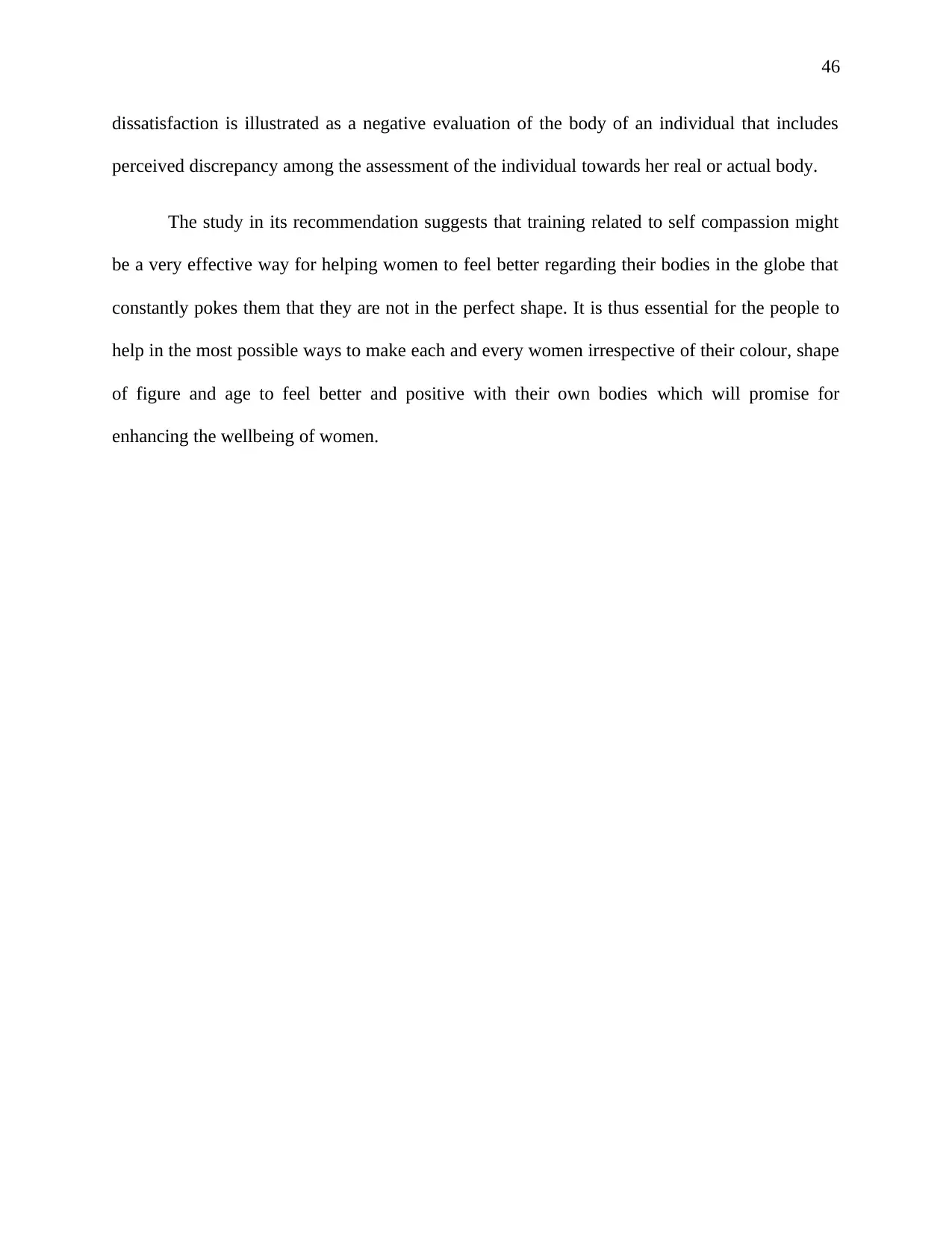
46
dissatisfaction is illustrated as a negative evaluation of the body of an individual that includes
perceived discrepancy among the assessment of the individual towards her real or actual body.
The study in its recommendation suggests that training related to self compassion might
be a very effective way for helping women to feel better regarding their bodies in the globe that
constantly pokes them that they are not in the perfect shape. It is thus essential for the people to
help in the most possible ways to make each and every women irrespective of their colour, shape
of figure and age to feel better and positive with their own bodies which will promise for
enhancing the wellbeing of women.
dissatisfaction is illustrated as a negative evaluation of the body of an individual that includes
perceived discrepancy among the assessment of the individual towards her real or actual body.
The study in its recommendation suggests that training related to self compassion might
be a very effective way for helping women to feel better regarding their bodies in the globe that
constantly pokes them that they are not in the perfect shape. It is thus essential for the people to
help in the most possible ways to make each and every women irrespective of their colour, shape
of figure and age to feel better and positive with their own bodies which will promise for
enhancing the wellbeing of women.
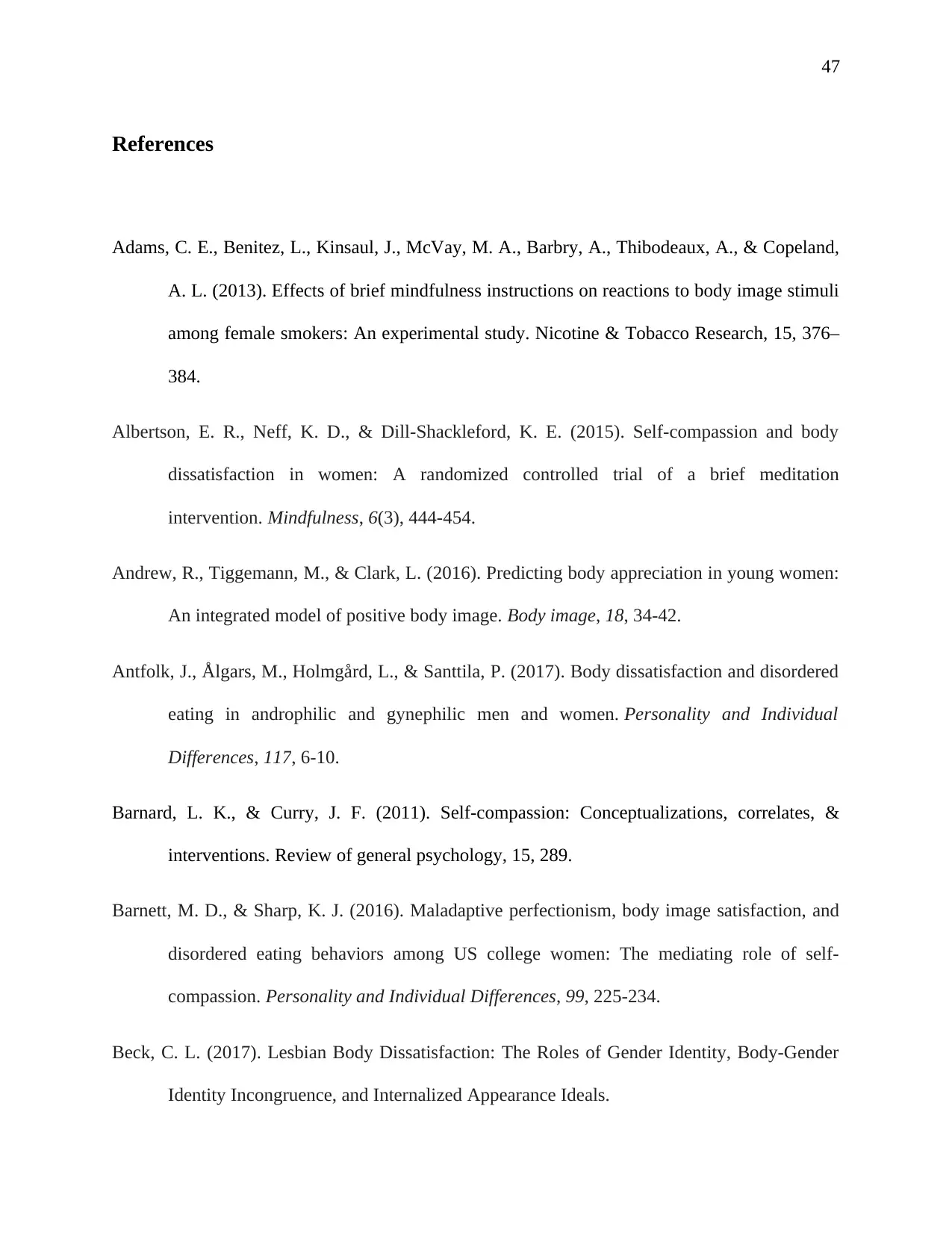
47
References
Adams, C. E., Benitez, L., Kinsaul, J., McVay, M. A., Barbry, A., Thibodeaux, A., & Copeland,
A. L. (2013). Effects of brief mindfulness instructions on reactions to body image stimuli
among female smokers: An experimental study. Nicotine & Tobacco Research, 15, 376–
384.
Albertson, E. R., Neff, K. D., & Dill-Shackleford, K. E. (2015). Self-compassion and body
dissatisfaction in women: A randomized controlled trial of a brief meditation
intervention. Mindfulness, 6(3), 444-454.
Andrew, R., Tiggemann, M., & Clark, L. (2016). Predicting body appreciation in young women:
An integrated model of positive body image. Body image, 18, 34-42.
Antfolk, J., Ålgars, M., Holmgård, L., & Santtila, P. (2017). Body dissatisfaction and disordered
eating in androphilic and gynephilic men and women. Personality and Individual
Differences, 117, 6-10.
Barnard, L. K., & Curry, J. F. (2011). Self-compassion: Conceptualizations, correlates, &
interventions. Review of general psychology, 15, 289.
Barnett, M. D., & Sharp, K. J. (2016). Maladaptive perfectionism, body image satisfaction, and
disordered eating behaviors among US college women: The mediating role of self-
compassion. Personality and Individual Differences, 99, 225-234.
Beck, C. L. (2017). Lesbian Body Dissatisfaction: The Roles of Gender Identity, Body-Gender
Identity Incongruence, and Internalized Appearance Ideals.
References
Adams, C. E., Benitez, L., Kinsaul, J., McVay, M. A., Barbry, A., Thibodeaux, A., & Copeland,
A. L. (2013). Effects of brief mindfulness instructions on reactions to body image stimuli
among female smokers: An experimental study. Nicotine & Tobacco Research, 15, 376–
384.
Albertson, E. R., Neff, K. D., & Dill-Shackleford, K. E. (2015). Self-compassion and body
dissatisfaction in women: A randomized controlled trial of a brief meditation
intervention. Mindfulness, 6(3), 444-454.
Andrew, R., Tiggemann, M., & Clark, L. (2016). Predicting body appreciation in young women:
An integrated model of positive body image. Body image, 18, 34-42.
Antfolk, J., Ålgars, M., Holmgård, L., & Santtila, P. (2017). Body dissatisfaction and disordered
eating in androphilic and gynephilic men and women. Personality and Individual
Differences, 117, 6-10.
Barnard, L. K., & Curry, J. F. (2011). Self-compassion: Conceptualizations, correlates, &
interventions. Review of general psychology, 15, 289.
Barnett, M. D., & Sharp, K. J. (2016). Maladaptive perfectionism, body image satisfaction, and
disordered eating behaviors among US college women: The mediating role of self-
compassion. Personality and Individual Differences, 99, 225-234.
Beck, C. L. (2017). Lesbian Body Dissatisfaction: The Roles of Gender Identity, Body-Gender
Identity Incongruence, and Internalized Appearance Ideals.
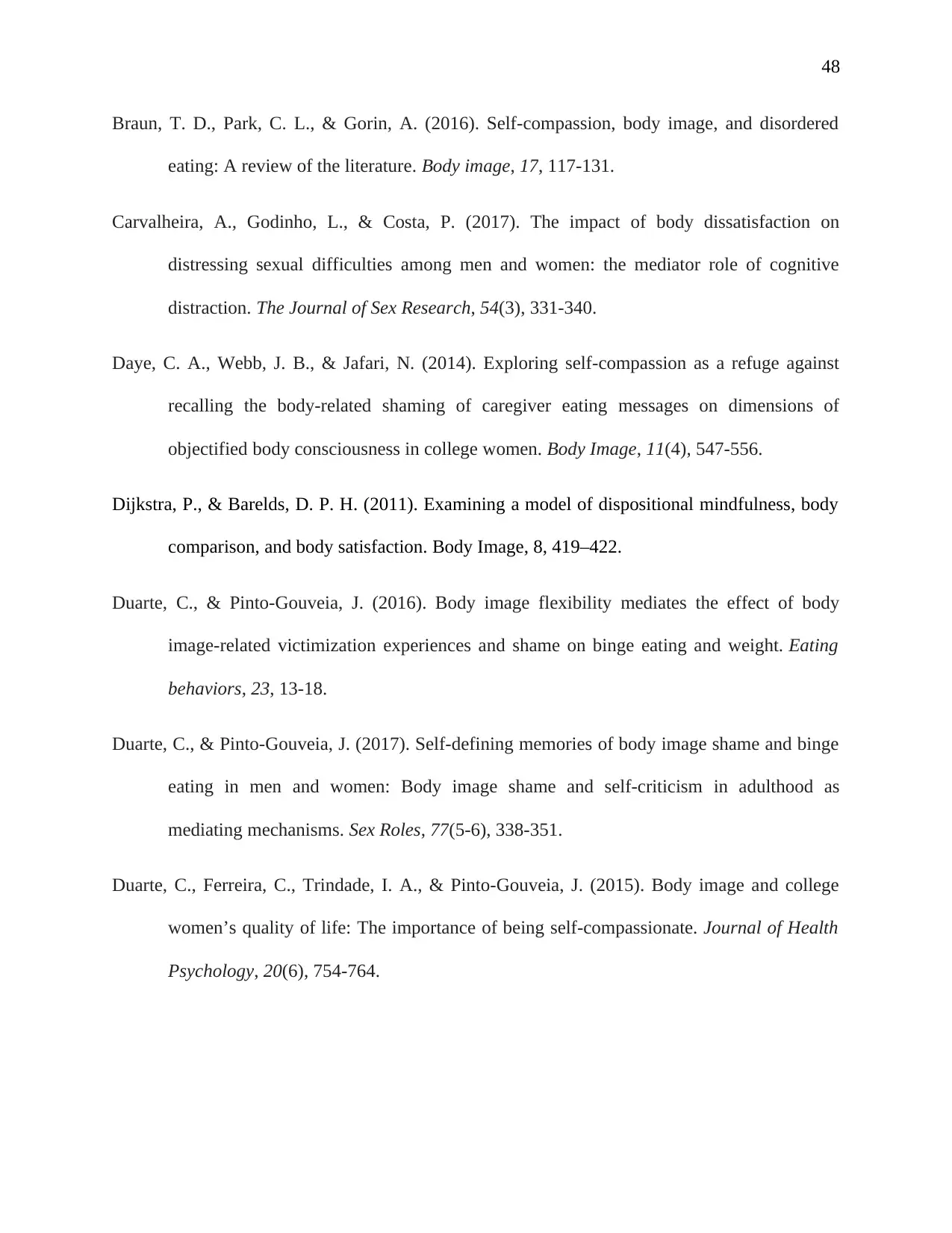
48
Braun, T. D., Park, C. L., & Gorin, A. (2016). Self-compassion, body image, and disordered
eating: A review of the literature. Body image, 17, 117-131.
Carvalheira, A., Godinho, L., & Costa, P. (2017). The impact of body dissatisfaction on
distressing sexual difficulties among men and women: the mediator role of cognitive
distraction. The Journal of Sex Research, 54(3), 331-340.
Daye, C. A., Webb, J. B., & Jafari, N. (2014). Exploring self-compassion as a refuge against
recalling the body-related shaming of caregiver eating messages on dimensions of
objectified body consciousness in college women. Body Image, 11(4), 547-556.
Dijkstra, P., & Barelds, D. P. H. (2011). Examining a model of dispositional mindfulness, body
comparison, and body satisfaction. Body Image, 8, 419–422.
Duarte, C., & Pinto-Gouveia, J. (2016). Body image flexibility mediates the effect of body
image-related victimization experiences and shame on binge eating and weight. Eating
behaviors, 23, 13-18.
Duarte, C., & Pinto-Gouveia, J. (2017). Self-defining memories of body image shame and binge
eating in men and women: Body image shame and self-criticism in adulthood as
mediating mechanisms. Sex Roles, 77(5-6), 338-351.
Duarte, C., Ferreira, C., Trindade, I. A., & Pinto-Gouveia, J. (2015). Body image and college
women’s quality of life: The importance of being self-compassionate. Journal of Health
Psychology, 20(6), 754-764.
Braun, T. D., Park, C. L., & Gorin, A. (2016). Self-compassion, body image, and disordered
eating: A review of the literature. Body image, 17, 117-131.
Carvalheira, A., Godinho, L., & Costa, P. (2017). The impact of body dissatisfaction on
distressing sexual difficulties among men and women: the mediator role of cognitive
distraction. The Journal of Sex Research, 54(3), 331-340.
Daye, C. A., Webb, J. B., & Jafari, N. (2014). Exploring self-compassion as a refuge against
recalling the body-related shaming of caregiver eating messages on dimensions of
objectified body consciousness in college women. Body Image, 11(4), 547-556.
Dijkstra, P., & Barelds, D. P. H. (2011). Examining a model of dispositional mindfulness, body
comparison, and body satisfaction. Body Image, 8, 419–422.
Duarte, C., & Pinto-Gouveia, J. (2016). Body image flexibility mediates the effect of body
image-related victimization experiences and shame on binge eating and weight. Eating
behaviors, 23, 13-18.
Duarte, C., & Pinto-Gouveia, J. (2017). Self-defining memories of body image shame and binge
eating in men and women: Body image shame and self-criticism in adulthood as
mediating mechanisms. Sex Roles, 77(5-6), 338-351.
Duarte, C., Ferreira, C., Trindade, I. A., & Pinto-Gouveia, J. (2015). Body image and college
women’s quality of life: The importance of being self-compassionate. Journal of Health
Psychology, 20(6), 754-764.
Paraphrase This Document
Need a fresh take? Get an instant paraphrase of this document with our AI Paraphraser
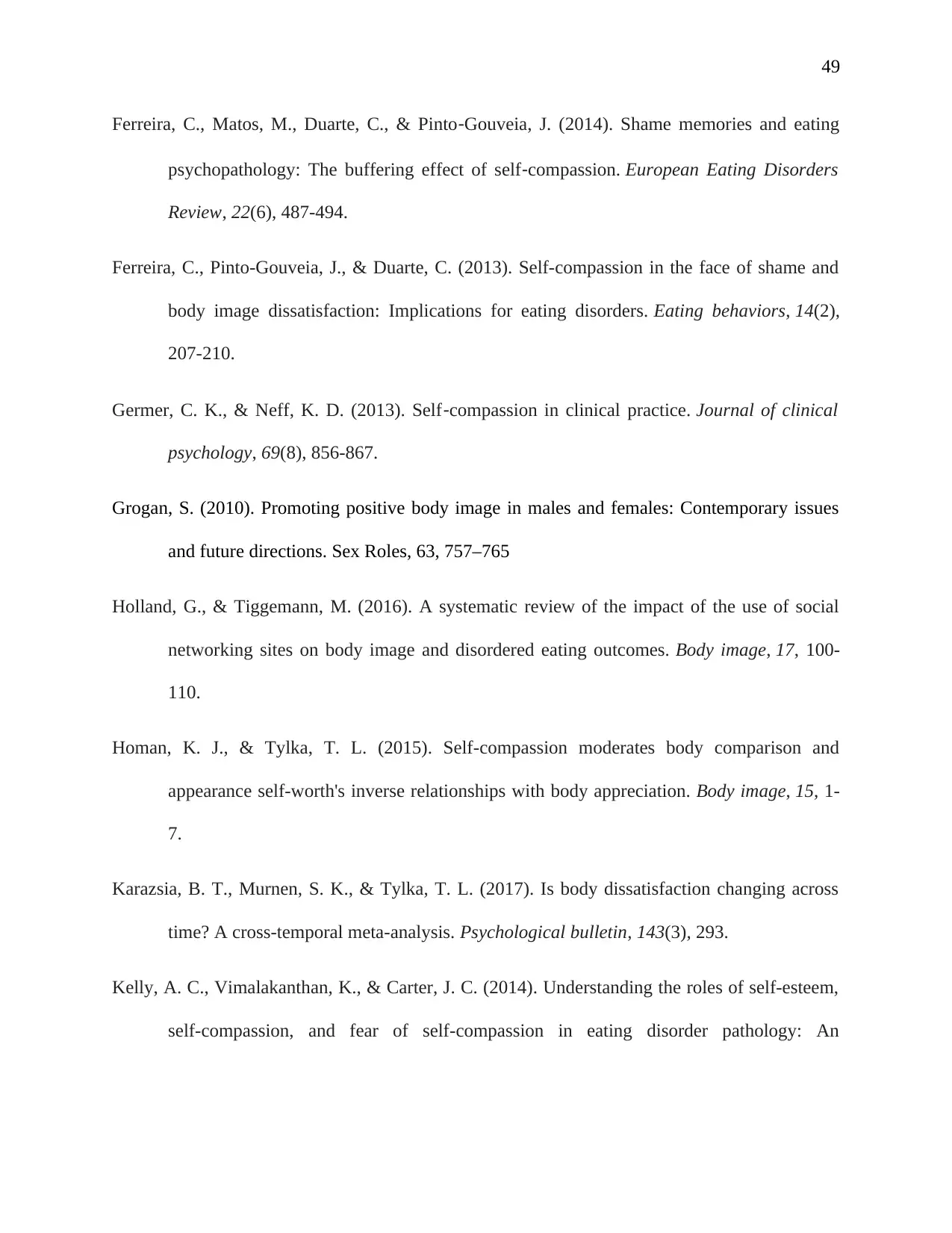
49
Ferreira, C., Matos, M., Duarte, C., & Pinto‐Gouveia, J. (2014). Shame memories and eating
psychopathology: The buffering effect of self‐compassion. European Eating Disorders
Review, 22(6), 487-494.
Ferreira, C., Pinto-Gouveia, J., & Duarte, C. (2013). Self-compassion in the face of shame and
body image dissatisfaction: Implications for eating disorders. Eating behaviors, 14(2),
207-210.
Germer, C. K., & Neff, K. D. (2013). Self‐compassion in clinical practice. Journal of clinical
psychology, 69(8), 856-867.
Grogan, S. (2010). Promoting positive body image in males and females: Contemporary issues
and future directions. Sex Roles, 63, 757–765
Holland, G., & Tiggemann, M. (2016). A systematic review of the impact of the use of social
networking sites on body image and disordered eating outcomes. Body image, 17, 100-
110.
Homan, K. J., & Tylka, T. L. (2015). Self-compassion moderates body comparison and
appearance self-worth's inverse relationships with body appreciation. Body image, 15, 1-
7.
Karazsia, B. T., Murnen, S. K., & Tylka, T. L. (2017). Is body dissatisfaction changing across
time? A cross-temporal meta-analysis. Psychological bulletin, 143(3), 293.
Kelly, A. C., Vimalakanthan, K., & Carter, J. C. (2014). Understanding the roles of self-esteem,
self-compassion, and fear of self-compassion in eating disorder pathology: An
Ferreira, C., Matos, M., Duarte, C., & Pinto‐Gouveia, J. (2014). Shame memories and eating
psychopathology: The buffering effect of self‐compassion. European Eating Disorders
Review, 22(6), 487-494.
Ferreira, C., Pinto-Gouveia, J., & Duarte, C. (2013). Self-compassion in the face of shame and
body image dissatisfaction: Implications for eating disorders. Eating behaviors, 14(2),
207-210.
Germer, C. K., & Neff, K. D. (2013). Self‐compassion in clinical practice. Journal of clinical
psychology, 69(8), 856-867.
Grogan, S. (2010). Promoting positive body image in males and females: Contemporary issues
and future directions. Sex Roles, 63, 757–765
Holland, G., & Tiggemann, M. (2016). A systematic review of the impact of the use of social
networking sites on body image and disordered eating outcomes. Body image, 17, 100-
110.
Homan, K. J., & Tylka, T. L. (2015). Self-compassion moderates body comparison and
appearance self-worth's inverse relationships with body appreciation. Body image, 15, 1-
7.
Karazsia, B. T., Murnen, S. K., & Tylka, T. L. (2017). Is body dissatisfaction changing across
time? A cross-temporal meta-analysis. Psychological bulletin, 143(3), 293.
Kelly, A. C., Vimalakanthan, K., & Carter, J. C. (2014). Understanding the roles of self-esteem,
self-compassion, and fear of self-compassion in eating disorder pathology: An
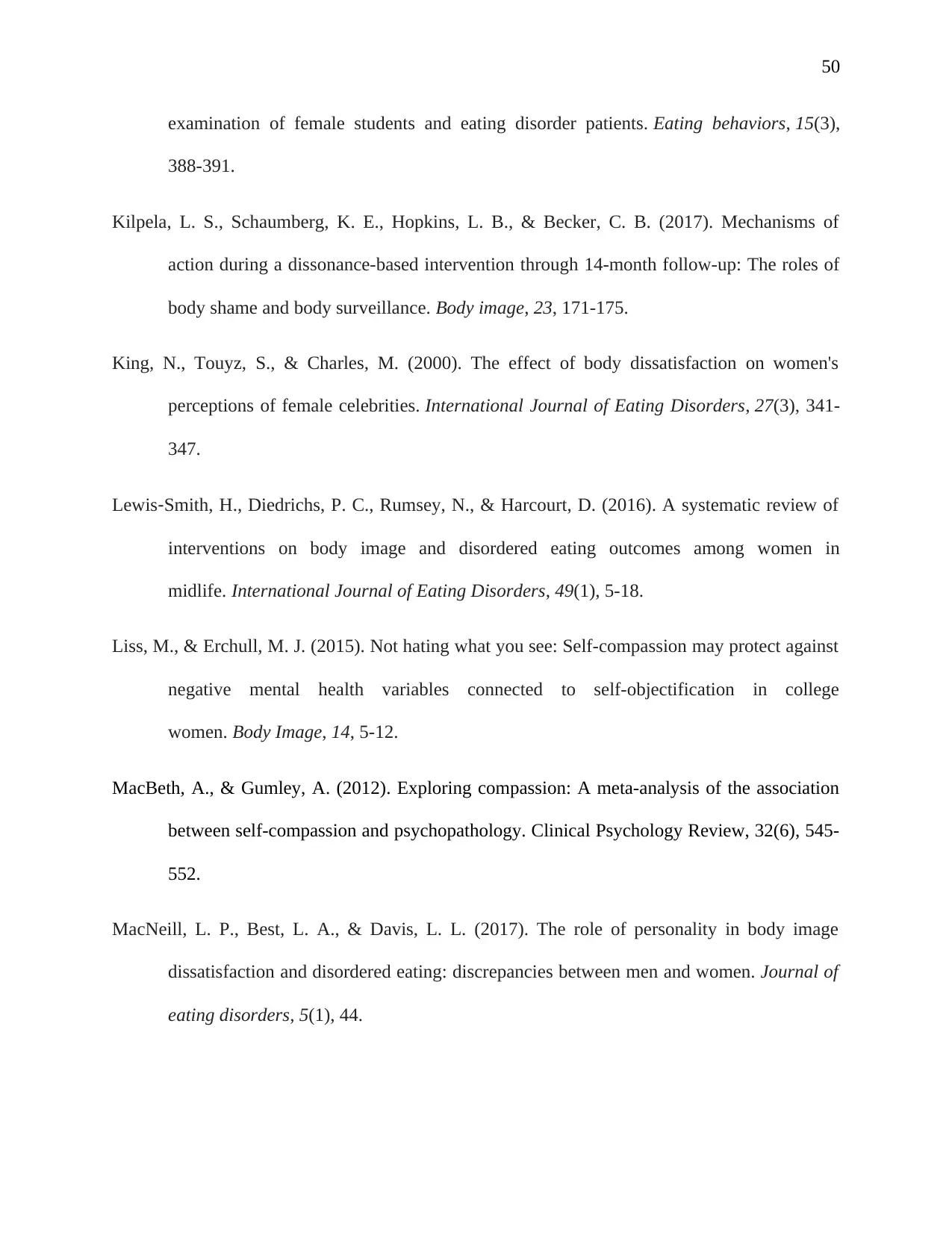
50
examination of female students and eating disorder patients. Eating behaviors, 15(3),
388-391.
Kilpela, L. S., Schaumberg, K. E., Hopkins, L. B., & Becker, C. B. (2017). Mechanisms of
action during a dissonance-based intervention through 14-month follow-up: The roles of
body shame and body surveillance. Body image, 23, 171-175.
King, N., Touyz, S., & Charles, M. (2000). The effect of body dissatisfaction on women's
perceptions of female celebrities. International Journal of Eating Disorders, 27(3), 341-
347.
Lewis‐Smith, H., Diedrichs, P. C., Rumsey, N., & Harcourt, D. (2016). A systematic review of
interventions on body image and disordered eating outcomes among women in
midlife. International Journal of Eating Disorders, 49(1), 5-18.
Liss, M., & Erchull, M. J. (2015). Not hating what you see: Self-compassion may protect against
negative mental health variables connected to self-objectification in college
women. Body Image, 14, 5-12.
MacBeth, A., & Gumley, A. (2012). Exploring compassion: A meta-analysis of the association
between self-compassion and psychopathology. Clinical Psychology Review, 32(6), 545-
552.
MacNeill, L. P., Best, L. A., & Davis, L. L. (2017). The role of personality in body image
dissatisfaction and disordered eating: discrepancies between men and women. Journal of
eating disorders, 5(1), 44.
examination of female students and eating disorder patients. Eating behaviors, 15(3),
388-391.
Kilpela, L. S., Schaumberg, K. E., Hopkins, L. B., & Becker, C. B. (2017). Mechanisms of
action during a dissonance-based intervention through 14-month follow-up: The roles of
body shame and body surveillance. Body image, 23, 171-175.
King, N., Touyz, S., & Charles, M. (2000). The effect of body dissatisfaction on women's
perceptions of female celebrities. International Journal of Eating Disorders, 27(3), 341-
347.
Lewis‐Smith, H., Diedrichs, P. C., Rumsey, N., & Harcourt, D. (2016). A systematic review of
interventions on body image and disordered eating outcomes among women in
midlife. International Journal of Eating Disorders, 49(1), 5-18.
Liss, M., & Erchull, M. J. (2015). Not hating what you see: Self-compassion may protect against
negative mental health variables connected to self-objectification in college
women. Body Image, 14, 5-12.
MacBeth, A., & Gumley, A. (2012). Exploring compassion: A meta-analysis of the association
between self-compassion and psychopathology. Clinical Psychology Review, 32(6), 545-
552.
MacNeill, L. P., Best, L. A., & Davis, L. L. (2017). The role of personality in body image
dissatisfaction and disordered eating: discrepancies between men and women. Journal of
eating disorders, 5(1), 44.
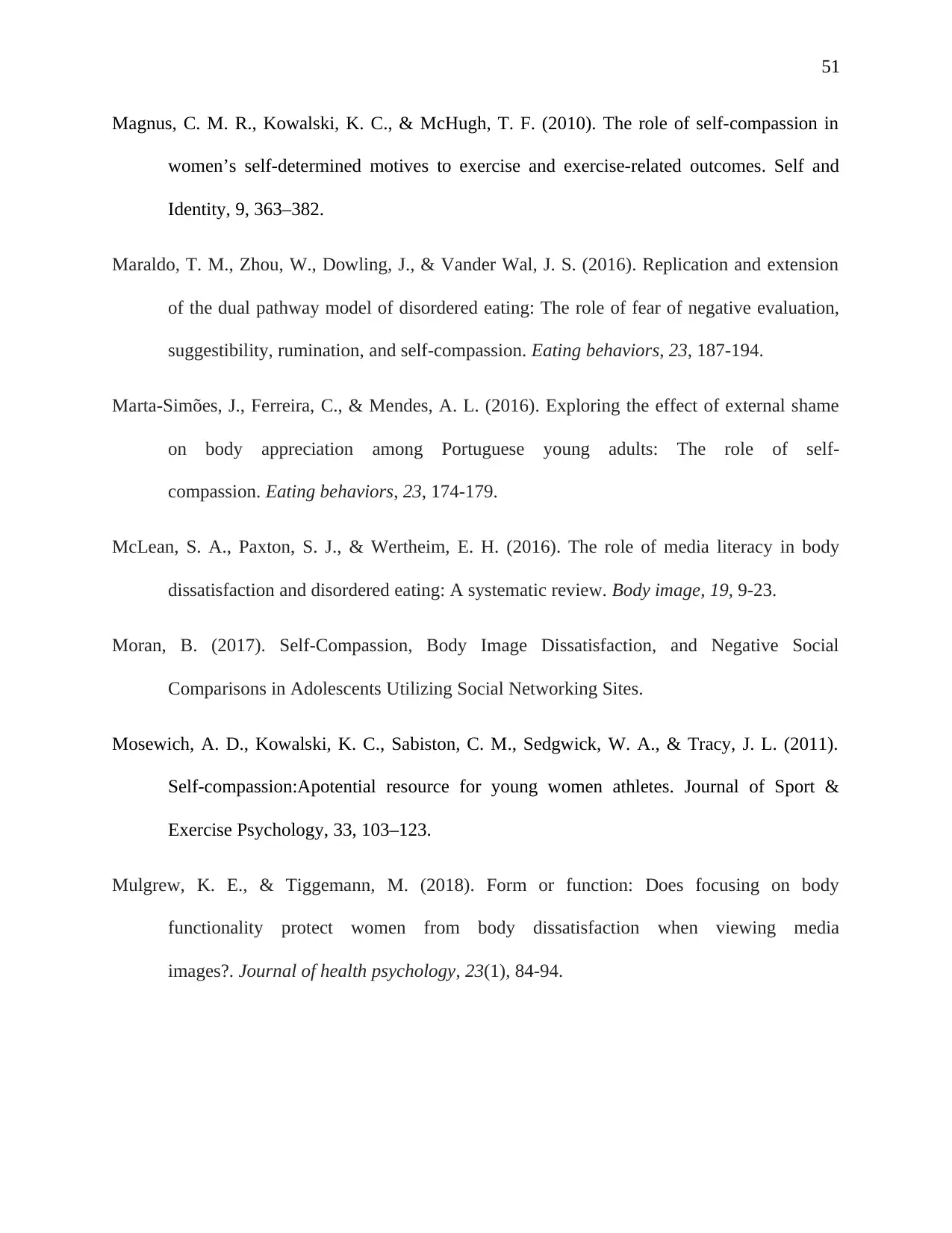
51
Magnus, C. M. R., Kowalski, K. C., & McHugh, T. F. (2010). The role of self-compassion in
women’s self-determined motives to exercise and exercise-related outcomes. Self and
Identity, 9, 363–382.
Maraldo, T. M., Zhou, W., Dowling, J., & Vander Wal, J. S. (2016). Replication and extension
of the dual pathway model of disordered eating: The role of fear of negative evaluation,
suggestibility, rumination, and self-compassion. Eating behaviors, 23, 187-194.
Marta-Simões, J., Ferreira, C., & Mendes, A. L. (2016). Exploring the effect of external shame
on body appreciation among Portuguese young adults: The role of self-
compassion. Eating behaviors, 23, 174-179.
McLean, S. A., Paxton, S. J., & Wertheim, E. H. (2016). The role of media literacy in body
dissatisfaction and disordered eating: A systematic review. Body image, 19, 9-23.
Moran, B. (2017). Self-Compassion, Body Image Dissatisfaction, and Negative Social
Comparisons in Adolescents Utilizing Social Networking Sites.
Mosewich, A. D., Kowalski, K. C., Sabiston, C. M., Sedgwick, W. A., & Tracy, J. L. (2011).
Self-compassion:Apotential resource for young women athletes. Journal of Sport &
Exercise Psychology, 33, 103–123.
Mulgrew, K. E., & Tiggemann, M. (2018). Form or function: Does focusing on body
functionality protect women from body dissatisfaction when viewing media
images?. Journal of health psychology, 23(1), 84-94.
Magnus, C. M. R., Kowalski, K. C., & McHugh, T. F. (2010). The role of self-compassion in
women’s self-determined motives to exercise and exercise-related outcomes. Self and
Identity, 9, 363–382.
Maraldo, T. M., Zhou, W., Dowling, J., & Vander Wal, J. S. (2016). Replication and extension
of the dual pathway model of disordered eating: The role of fear of negative evaluation,
suggestibility, rumination, and self-compassion. Eating behaviors, 23, 187-194.
Marta-Simões, J., Ferreira, C., & Mendes, A. L. (2016). Exploring the effect of external shame
on body appreciation among Portuguese young adults: The role of self-
compassion. Eating behaviors, 23, 174-179.
McLean, S. A., Paxton, S. J., & Wertheim, E. H. (2016). The role of media literacy in body
dissatisfaction and disordered eating: A systematic review. Body image, 19, 9-23.
Moran, B. (2017). Self-Compassion, Body Image Dissatisfaction, and Negative Social
Comparisons in Adolescents Utilizing Social Networking Sites.
Mosewich, A. D., Kowalski, K. C., Sabiston, C. M., Sedgwick, W. A., & Tracy, J. L. (2011).
Self-compassion:Apotential resource for young women athletes. Journal of Sport &
Exercise Psychology, 33, 103–123.
Mulgrew, K. E., & Tiggemann, M. (2018). Form or function: Does focusing on body
functionality protect women from body dissatisfaction when viewing media
images?. Journal of health psychology, 23(1), 84-94.
Secure Best Marks with AI Grader
Need help grading? Try our AI Grader for instant feedback on your assignments.
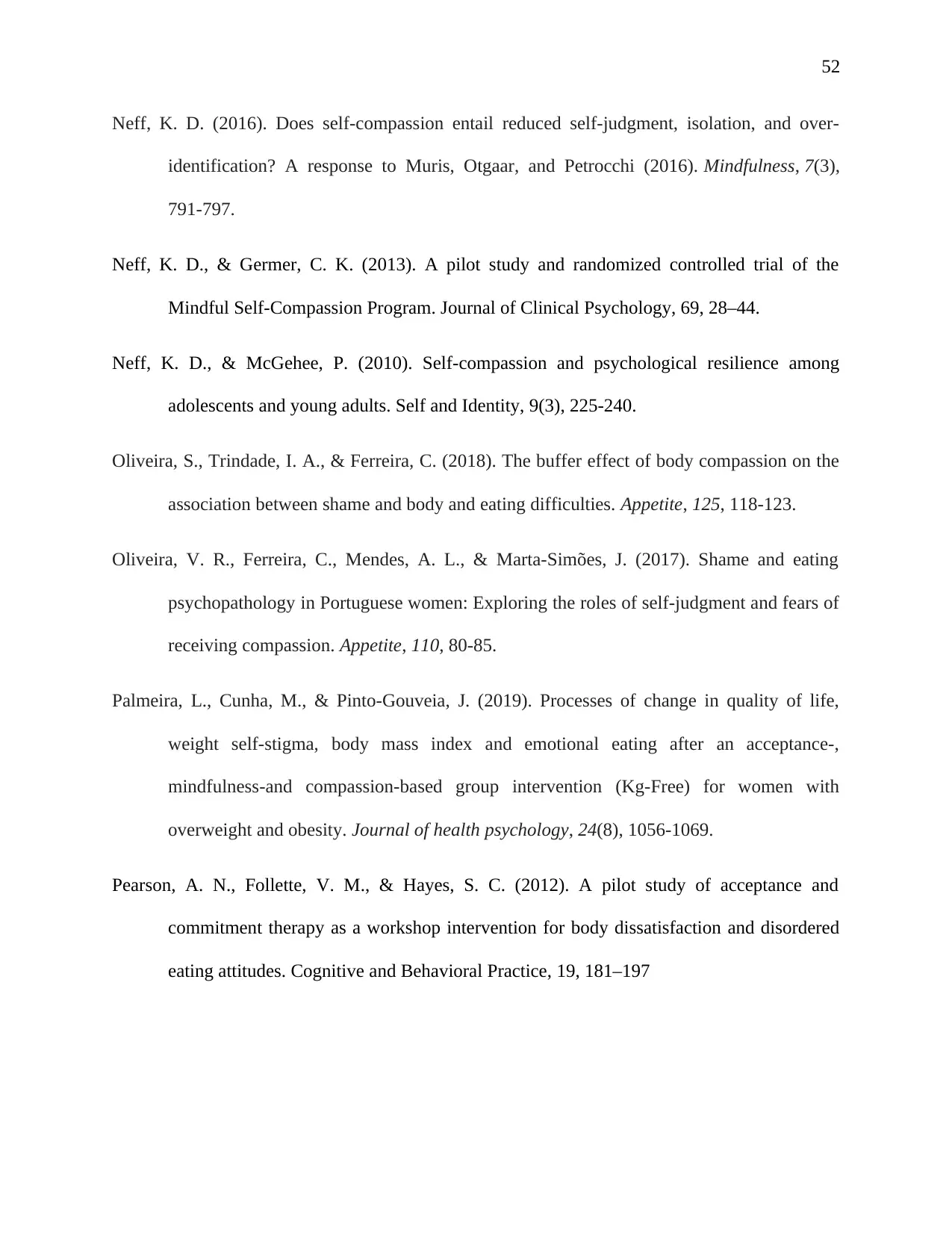
52
Neff, K. D. (2016). Does self-compassion entail reduced self-judgment, isolation, and over-
identification? A response to Muris, Otgaar, and Petrocchi (2016). Mindfulness, 7(3),
791-797.
Neff, K. D., & Germer, C. K. (2013). A pilot study and randomized controlled trial of the
Mindful Self-Compassion Program. Journal of Clinical Psychology, 69, 28–44.
Neff, K. D., & McGehee, P. (2010). Self-compassion and psychological resilience among
adolescents and young adults. Self and Identity, 9(3), 225-240.
Oliveira, S., Trindade, I. A., & Ferreira, C. (2018). The buffer effect of body compassion on the
association between shame and body and eating difficulties. Appetite, 125, 118-123.
Oliveira, V. R., Ferreira, C., Mendes, A. L., & Marta-Simões, J. (2017). Shame and eating
psychopathology in Portuguese women: Exploring the roles of self-judgment and fears of
receiving compassion. Appetite, 110, 80-85.
Palmeira, L., Cunha, M., & Pinto-Gouveia, J. (2019). Processes of change in quality of life,
weight self-stigma, body mass index and emotional eating after an acceptance-,
mindfulness-and compassion-based group intervention (Kg-Free) for women with
overweight and obesity. Journal of health psychology, 24(8), 1056-1069.
Pearson, A. N., Follette, V. M., & Hayes, S. C. (2012). A pilot study of acceptance and
commitment therapy as a workshop intervention for body dissatisfaction and disordered
eating attitudes. Cognitive and Behavioral Practice, 19, 181–197
Neff, K. D. (2016). Does self-compassion entail reduced self-judgment, isolation, and over-
identification? A response to Muris, Otgaar, and Petrocchi (2016). Mindfulness, 7(3),
791-797.
Neff, K. D., & Germer, C. K. (2013). A pilot study and randomized controlled trial of the
Mindful Self-Compassion Program. Journal of Clinical Psychology, 69, 28–44.
Neff, K. D., & McGehee, P. (2010). Self-compassion and psychological resilience among
adolescents and young adults. Self and Identity, 9(3), 225-240.
Oliveira, S., Trindade, I. A., & Ferreira, C. (2018). The buffer effect of body compassion on the
association between shame and body and eating difficulties. Appetite, 125, 118-123.
Oliveira, V. R., Ferreira, C., Mendes, A. L., & Marta-Simões, J. (2017). Shame and eating
psychopathology in Portuguese women: Exploring the roles of self-judgment and fears of
receiving compassion. Appetite, 110, 80-85.
Palmeira, L., Cunha, M., & Pinto-Gouveia, J. (2019). Processes of change in quality of life,
weight self-stigma, body mass index and emotional eating after an acceptance-,
mindfulness-and compassion-based group intervention (Kg-Free) for women with
overweight and obesity. Journal of health psychology, 24(8), 1056-1069.
Pearson, A. N., Follette, V. M., & Hayes, S. C. (2012). A pilot study of acceptance and
commitment therapy as a workshop intervention for body dissatisfaction and disordered
eating attitudes. Cognitive and Behavioral Practice, 19, 181–197
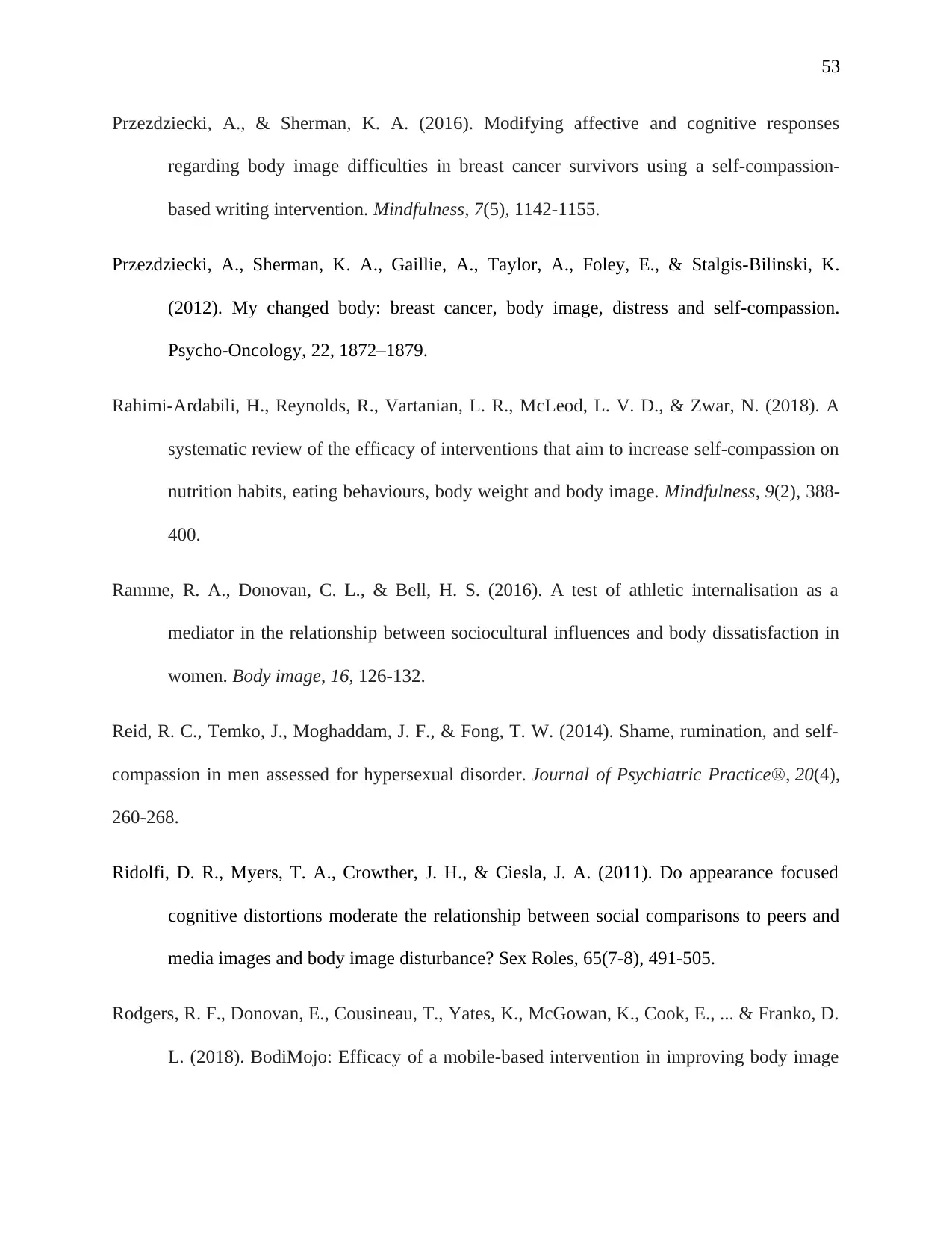
53
Przezdziecki, A., & Sherman, K. A. (2016). Modifying affective and cognitive responses
regarding body image difficulties in breast cancer survivors using a self-compassion-
based writing intervention. Mindfulness, 7(5), 1142-1155.
Przezdziecki, A., Sherman, K. A., Gaillie, A., Taylor, A., Foley, E., & Stalgis-Bilinski, K.
(2012). My changed body: breast cancer, body image, distress and self-compassion.
Psycho-Oncology, 22, 1872–1879.
Rahimi-Ardabili, H., Reynolds, R., Vartanian, L. R., McLeod, L. V. D., & Zwar, N. (2018). A
systematic review of the efficacy of interventions that aim to increase self-compassion on
nutrition habits, eating behaviours, body weight and body image. Mindfulness, 9(2), 388-
400.
Ramme, R. A., Donovan, C. L., & Bell, H. S. (2016). A test of athletic internalisation as a
mediator in the relationship between sociocultural influences and body dissatisfaction in
women. Body image, 16, 126-132.
Reid, R. C., Temko, J., Moghaddam, J. F., & Fong, T. W. (2014). Shame, rumination, and self-
compassion in men assessed for hypersexual disorder. Journal of Psychiatric Practice®, 20(4),
260-268.
Ridolfi, D. R., Myers, T. A., Crowther, J. H., & Ciesla, J. A. (2011). Do appearance focused
cognitive distortions moderate the relationship between social comparisons to peers and
media images and body image disturbance? Sex Roles, 65(7-8), 491-505.
Rodgers, R. F., Donovan, E., Cousineau, T., Yates, K., McGowan, K., Cook, E., ... & Franko, D.
L. (2018). BodiMojo: Efficacy of a mobile-based intervention in improving body image
Przezdziecki, A., & Sherman, K. A. (2016). Modifying affective and cognitive responses
regarding body image difficulties in breast cancer survivors using a self-compassion-
based writing intervention. Mindfulness, 7(5), 1142-1155.
Przezdziecki, A., Sherman, K. A., Gaillie, A., Taylor, A., Foley, E., & Stalgis-Bilinski, K.
(2012). My changed body: breast cancer, body image, distress and self-compassion.
Psycho-Oncology, 22, 1872–1879.
Rahimi-Ardabili, H., Reynolds, R., Vartanian, L. R., McLeod, L. V. D., & Zwar, N. (2018). A
systematic review of the efficacy of interventions that aim to increase self-compassion on
nutrition habits, eating behaviours, body weight and body image. Mindfulness, 9(2), 388-
400.
Ramme, R. A., Donovan, C. L., & Bell, H. S. (2016). A test of athletic internalisation as a
mediator in the relationship between sociocultural influences and body dissatisfaction in
women. Body image, 16, 126-132.
Reid, R. C., Temko, J., Moghaddam, J. F., & Fong, T. W. (2014). Shame, rumination, and self-
compassion in men assessed for hypersexual disorder. Journal of Psychiatric Practice®, 20(4),
260-268.
Ridolfi, D. R., Myers, T. A., Crowther, J. H., & Ciesla, J. A. (2011). Do appearance focused
cognitive distortions moderate the relationship between social comparisons to peers and
media images and body image disturbance? Sex Roles, 65(7-8), 491-505.
Rodgers, R. F., Donovan, E., Cousineau, T., Yates, K., McGowan, K., Cook, E., ... & Franko, D.
L. (2018). BodiMojo: Efficacy of a mobile-based intervention in improving body image
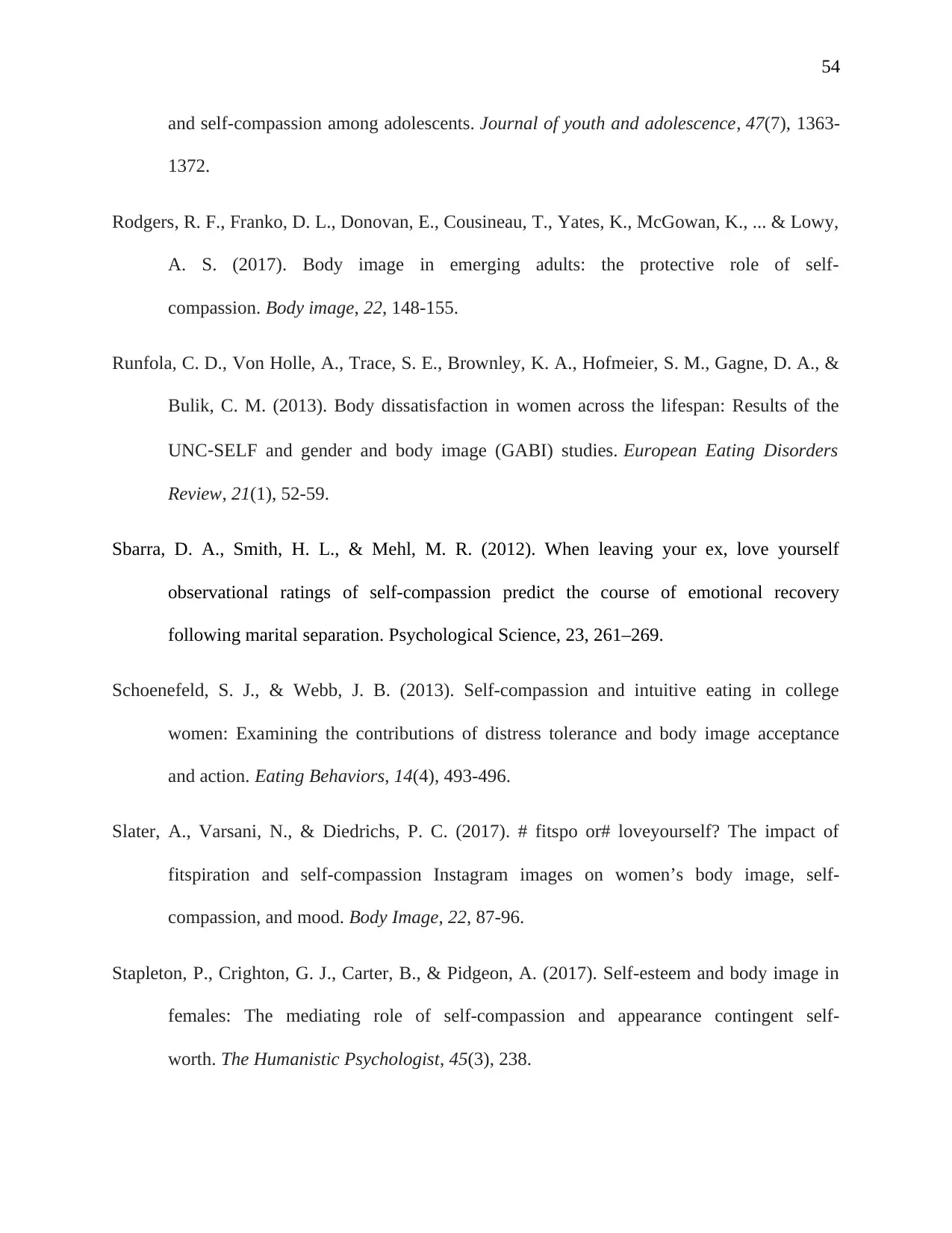
54
and self-compassion among adolescents. Journal of youth and adolescence, 47(7), 1363-
1372.
Rodgers, R. F., Franko, D. L., Donovan, E., Cousineau, T., Yates, K., McGowan, K., ... & Lowy,
A. S. (2017). Body image in emerging adults: the protective role of self-
compassion. Body image, 22, 148-155.
Runfola, C. D., Von Holle, A., Trace, S. E., Brownley, K. A., Hofmeier, S. M., Gagne, D. A., &
Bulik, C. M. (2013). Body dissatisfaction in women across the lifespan: Results of the
UNC‐SELF and gender and body image (GABI) studies. European Eating Disorders
Review, 21(1), 52-59.
Sbarra, D. A., Smith, H. L., & Mehl, M. R. (2012). When leaving your ex, love yourself
observational ratings of self-compassion predict the course of emotional recovery
following marital separation. Psychological Science, 23, 261–269.
Schoenefeld, S. J., & Webb, J. B. (2013). Self-compassion and intuitive eating in college
women: Examining the contributions of distress tolerance and body image acceptance
and action. Eating Behaviors, 14(4), 493-496.
Slater, A., Varsani, N., & Diedrichs, P. C. (2017). # fitspo or# loveyourself? The impact of
fitspiration and self-compassion Instagram images on women’s body image, self-
compassion, and mood. Body Image, 22, 87-96.
Stapleton, P., Crighton, G. J., Carter, B., & Pidgeon, A. (2017). Self-esteem and body image in
females: The mediating role of self-compassion and appearance contingent self-
worth. The Humanistic Psychologist, 45(3), 238.
and self-compassion among adolescents. Journal of youth and adolescence, 47(7), 1363-
1372.
Rodgers, R. F., Franko, D. L., Donovan, E., Cousineau, T., Yates, K., McGowan, K., ... & Lowy,
A. S. (2017). Body image in emerging adults: the protective role of self-
compassion. Body image, 22, 148-155.
Runfola, C. D., Von Holle, A., Trace, S. E., Brownley, K. A., Hofmeier, S. M., Gagne, D. A., &
Bulik, C. M. (2013). Body dissatisfaction in women across the lifespan: Results of the
UNC‐SELF and gender and body image (GABI) studies. European Eating Disorders
Review, 21(1), 52-59.
Sbarra, D. A., Smith, H. L., & Mehl, M. R. (2012). When leaving your ex, love yourself
observational ratings of self-compassion predict the course of emotional recovery
following marital separation. Psychological Science, 23, 261–269.
Schoenefeld, S. J., & Webb, J. B. (2013). Self-compassion and intuitive eating in college
women: Examining the contributions of distress tolerance and body image acceptance
and action. Eating Behaviors, 14(4), 493-496.
Slater, A., Varsani, N., & Diedrichs, P. C. (2017). # fitspo or# loveyourself? The impact of
fitspiration and self-compassion Instagram images on women’s body image, self-
compassion, and mood. Body Image, 22, 87-96.
Stapleton, P., Crighton, G. J., Carter, B., & Pidgeon, A. (2017). Self-esteem and body image in
females: The mediating role of self-compassion and appearance contingent self-
worth. The Humanistic Psychologist, 45(3), 238.
Paraphrase This Document
Need a fresh take? Get an instant paraphrase of this document with our AI Paraphraser
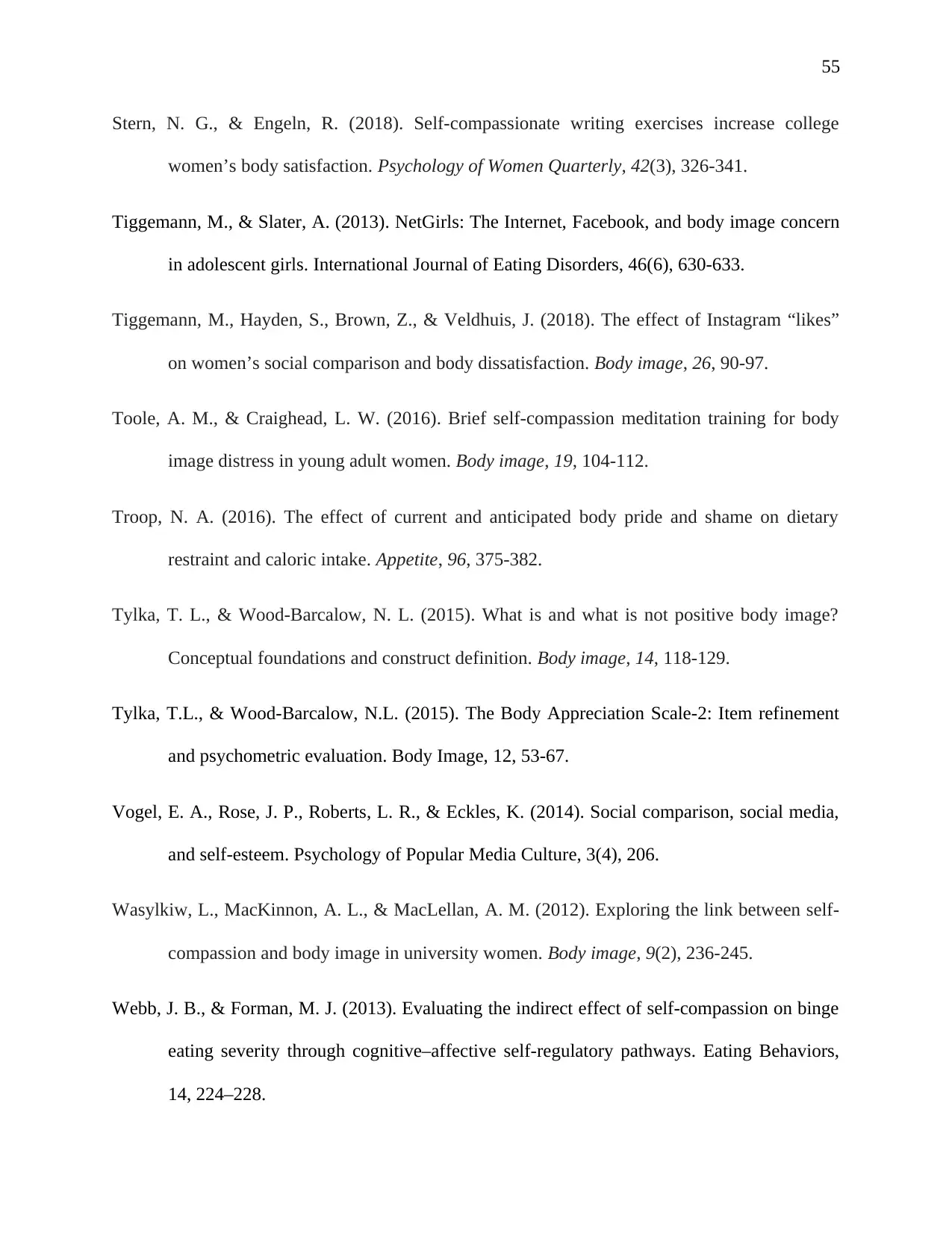
55
Stern, N. G., & Engeln, R. (2018). Self-compassionate writing exercises increase college
women’s body satisfaction. Psychology of Women Quarterly, 42(3), 326-341.
Tiggemann, M., & Slater, A. (2013). NetGirls: The Internet, Facebook, and body image concern
in adolescent girls. International Journal of Eating Disorders, 46(6), 630-633.
Tiggemann, M., Hayden, S., Brown, Z., & Veldhuis, J. (2018). The effect of Instagram “likes”
on women’s social comparison and body dissatisfaction. Body image, 26, 90-97.
Toole, A. M., & Craighead, L. W. (2016). Brief self-compassion meditation training for body
image distress in young adult women. Body image, 19, 104-112.
Troop, N. A. (2016). The effect of current and anticipated body pride and shame on dietary
restraint and caloric intake. Appetite, 96, 375-382.
Tylka, T. L., & Wood-Barcalow, N. L. (2015). What is and what is not positive body image?
Conceptual foundations and construct definition. Body image, 14, 118-129.
Tylka, T.L., & Wood-Barcalow, N.L. (2015). The Body Appreciation Scale-2: Item refinement
and psychometric evaluation. Body Image, 12, 53-67.
Vogel, E. A., Rose, J. P., Roberts, L. R., & Eckles, K. (2014). Social comparison, social media,
and self-esteem. Psychology of Popular Media Culture, 3(4), 206.
Wasylkiw, L., MacKinnon, A. L., & MacLellan, A. M. (2012). Exploring the link between self-
compassion and body image in university women. Body image, 9(2), 236-245.
Webb, J. B., & Forman, M. J. (2013). Evaluating the indirect effect of self-compassion on binge
eating severity through cognitive–affective self-regulatory pathways. Eating Behaviors,
14, 224–228.
Stern, N. G., & Engeln, R. (2018). Self-compassionate writing exercises increase college
women’s body satisfaction. Psychology of Women Quarterly, 42(3), 326-341.
Tiggemann, M., & Slater, A. (2013). NetGirls: The Internet, Facebook, and body image concern
in adolescent girls. International Journal of Eating Disorders, 46(6), 630-633.
Tiggemann, M., Hayden, S., Brown, Z., & Veldhuis, J. (2018). The effect of Instagram “likes”
on women’s social comparison and body dissatisfaction. Body image, 26, 90-97.
Toole, A. M., & Craighead, L. W. (2016). Brief self-compassion meditation training for body
image distress in young adult women. Body image, 19, 104-112.
Troop, N. A. (2016). The effect of current and anticipated body pride and shame on dietary
restraint and caloric intake. Appetite, 96, 375-382.
Tylka, T. L., & Wood-Barcalow, N. L. (2015). What is and what is not positive body image?
Conceptual foundations and construct definition. Body image, 14, 118-129.
Tylka, T.L., & Wood-Barcalow, N.L. (2015). The Body Appreciation Scale-2: Item refinement
and psychometric evaluation. Body Image, 12, 53-67.
Vogel, E. A., Rose, J. P., Roberts, L. R., & Eckles, K. (2014). Social comparison, social media,
and self-esteem. Psychology of Popular Media Culture, 3(4), 206.
Wasylkiw, L., MacKinnon, A. L., & MacLellan, A. M. (2012). Exploring the link between self-
compassion and body image in university women. Body image, 9(2), 236-245.
Webb, J. B., & Forman, M. J. (2013). Evaluating the indirect effect of self-compassion on binge
eating severity through cognitive–affective self-regulatory pathways. Eating Behaviors,
14, 224–228.
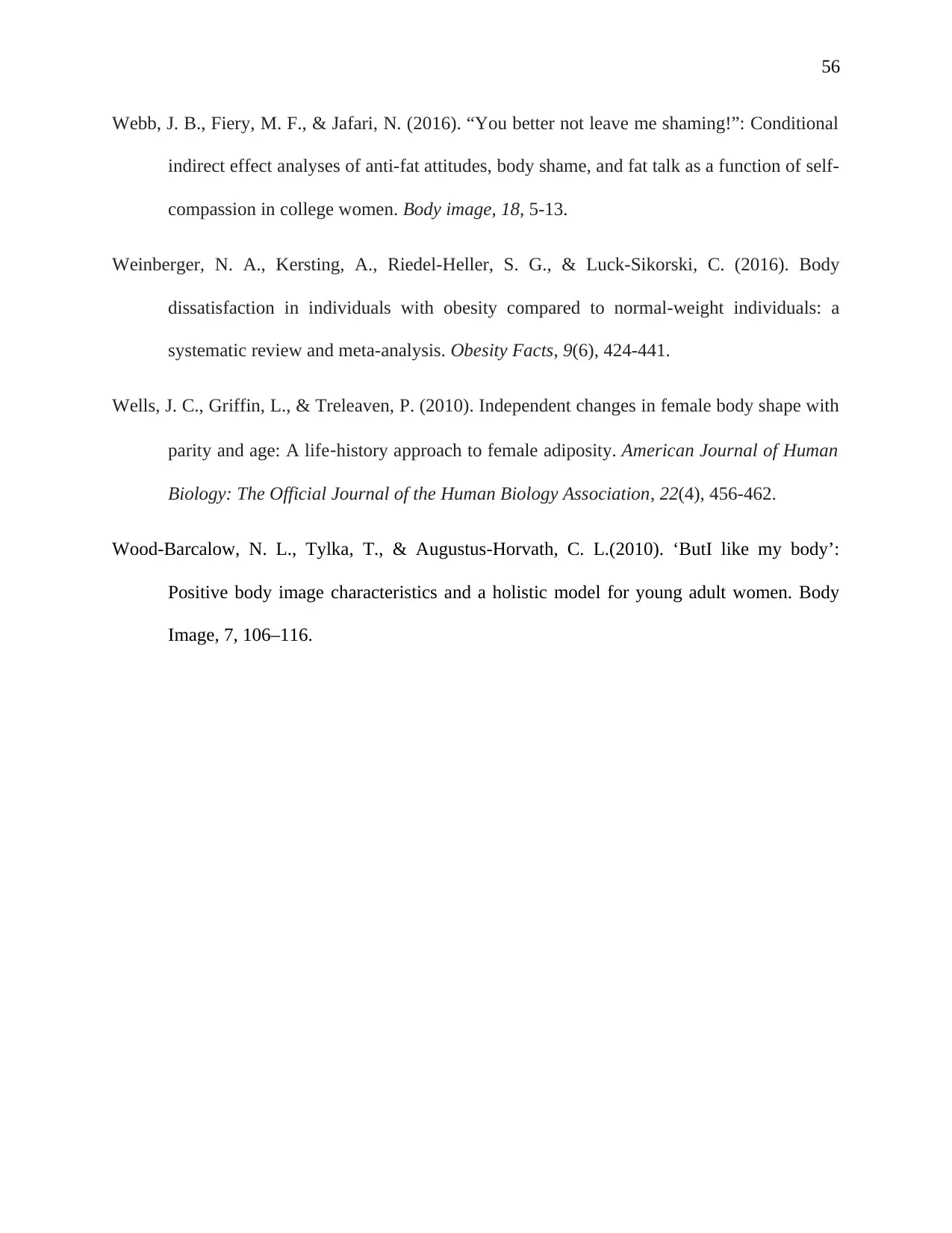
56
Webb, J. B., Fiery, M. F., & Jafari, N. (2016). “You better not leave me shaming!”: Conditional
indirect effect analyses of anti-fat attitudes, body shame, and fat talk as a function of self-
compassion in college women. Body image, 18, 5-13.
Weinberger, N. A., Kersting, A., Riedel-Heller, S. G., & Luck-Sikorski, C. (2016). Body
dissatisfaction in individuals with obesity compared to normal-weight individuals: a
systematic review and meta-analysis. Obesity Facts, 9(6), 424-441.
Wells, J. C., Griffin, L., & Treleaven, P. (2010). Independent changes in female body shape with
parity and age: A life‐history approach to female adiposity. American Journal of Human
Biology: The Official Journal of the Human Biology Association, 22(4), 456-462.
Wood-Barcalow, N. L., Tylka, T., & Augustus-Horvath, C. L.(2010). ‘ButI like my body’:
Positive body image characteristics and a holistic model for young adult women. Body
Image, 7, 106–116.
Webb, J. B., Fiery, M. F., & Jafari, N. (2016). “You better not leave me shaming!”: Conditional
indirect effect analyses of anti-fat attitudes, body shame, and fat talk as a function of self-
compassion in college women. Body image, 18, 5-13.
Weinberger, N. A., Kersting, A., Riedel-Heller, S. G., & Luck-Sikorski, C. (2016). Body
dissatisfaction in individuals with obesity compared to normal-weight individuals: a
systematic review and meta-analysis. Obesity Facts, 9(6), 424-441.
Wells, J. C., Griffin, L., & Treleaven, P. (2010). Independent changes in female body shape with
parity and age: A life‐history approach to female adiposity. American Journal of Human
Biology: The Official Journal of the Human Biology Association, 22(4), 456-462.
Wood-Barcalow, N. L., Tylka, T., & Augustus-Horvath, C. L.(2010). ‘ButI like my body’:
Positive body image characteristics and a holistic model for young adult women. Body
Image, 7, 106–116.
1 out of 57
Related Documents
Your All-in-One AI-Powered Toolkit for Academic Success.
+13062052269
info@desklib.com
Available 24*7 on WhatsApp / Email
![[object Object]](/_next/static/media/star-bottom.7253800d.svg)
Unlock your academic potential
© 2024 | Zucol Services PVT LTD | All rights reserved.





